- Accueil
- Base de données
- 56
- USAAF
- 29 April 1944
29 April 1944
North American P-51B-10-NA Mustang s/n 42-106485 (code A9-V)
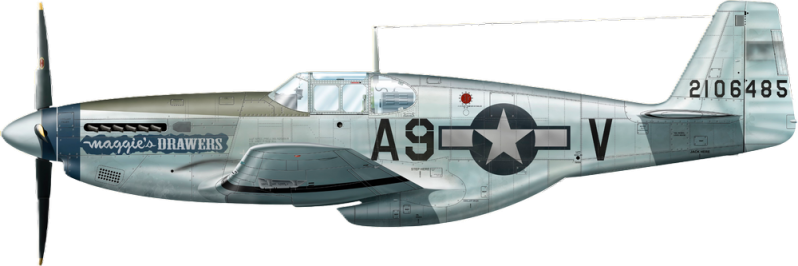
© Jean-Marie GUILLOU
&
North American P-51B-5-NA Mustang s/n 43-6513 (code A9-Q)
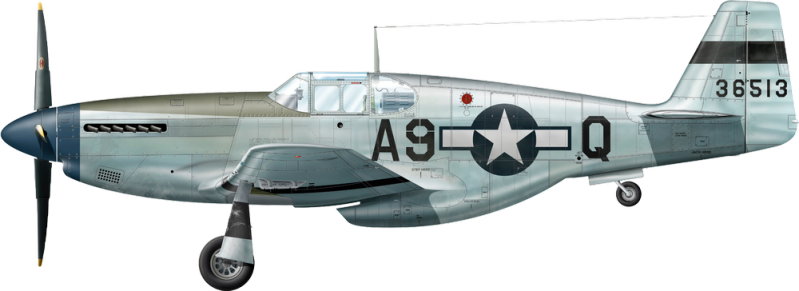
© Jean-Marie GUILLOU
Allaire (56)
(contributors : Isabelle Guillermic, Daniel Baron [Groupe Patrimoine & Histoire Locale d'Allaire], Philippe Guillermic, Frédéric Hénoff, Ann Trevor)
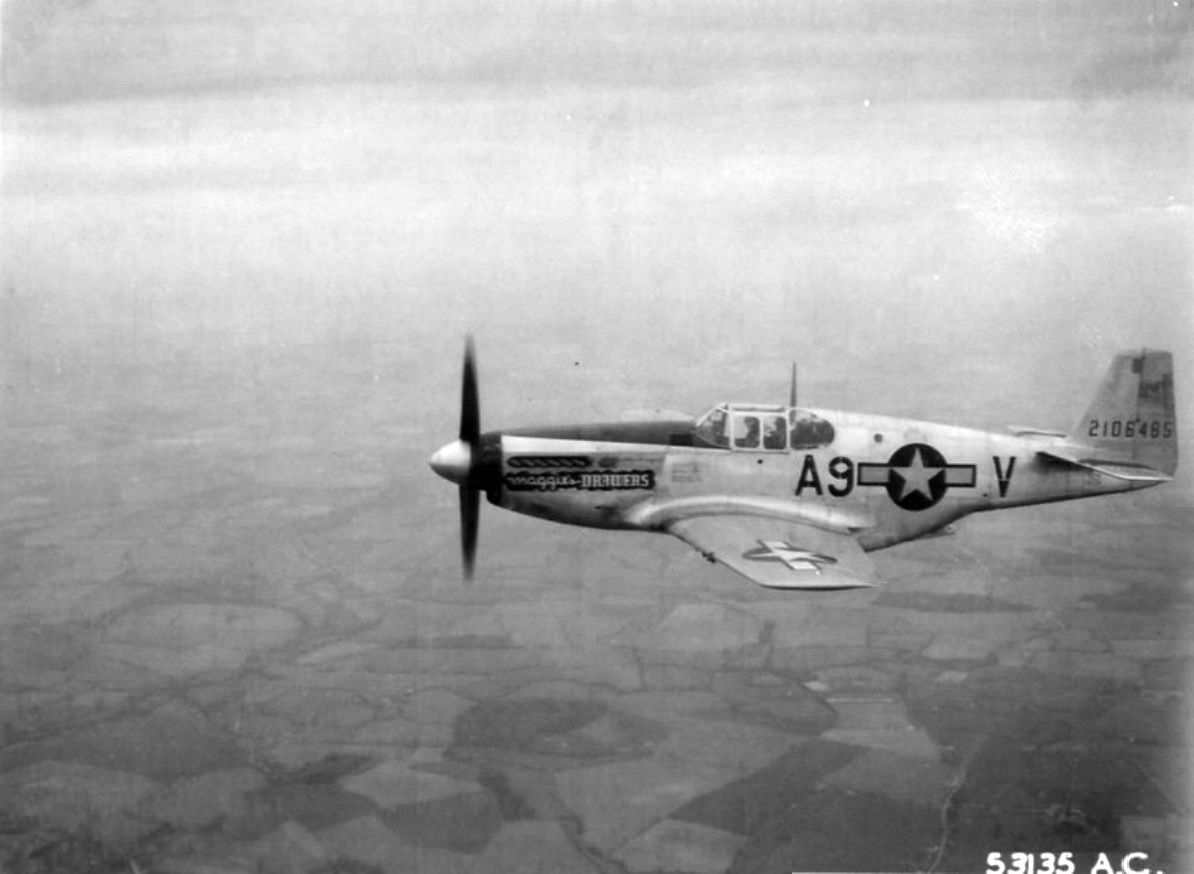
North American P-51 "Maggie's Drawers (1) " (s/n 42-106485) in flight
Photo U.S. Army Air Forces ref. 342-FH-3A16458-53135AC - source National Archives and Records Administration (domaine public)
(1) : nickname given to the red flag used to indicate failure during target practice
Pilots (363rd FG - 380th FS) :
♦ P-51 code A9-V (s/n 42-106485) : 2nd Lieutenant Albert George JOHNSON (service number O-805057)
Captured on June 5, 1944 in Dax, reported to Stalag Luft 1 in Barth, Western Pomerania (Germany)
no date specified, but returned to the United States in May 1945.
Born on March 9, 1921, in Saint Paul, Minnesota, USA, parents George and Alpha Johnson
Married to Zera H. Coulouris on August 18, 1945 – 3 children : John, Tina, and Mark.
Albert died on June 19, 1983, in Little Falls, Morrison County, Minnesota, USA.
♦ P-51 code A9-Q (s/n 43-6513) : 2nd Lieutenant Norman Davis HERSBERGER (service number O-805045)
Captured on June 5, 1944 in Dax, sent to Stalag Luft 3 Sagan – Silesia Bavaria
(later moved to Nuremberg-Langwasser) 49-11 (camp closed in February 1945).
Born in Saskatchewan, Canada, on October 30, 1919, parents Marshall and Edna HERSBERGER,
he had three brothers, Marshall, Homer, and Wilson, and they were raised in Poolesville, in a bungalow on West Willard Road.
Married to Eloise Hersberger – two sons : Norman Davis Hersberger II and Tim Shoaf Hersberger,
both from Covington, and three grandchildren.
Norman died on January 1, 2003, in Southaven – DeSoto County, Mississippi, USA
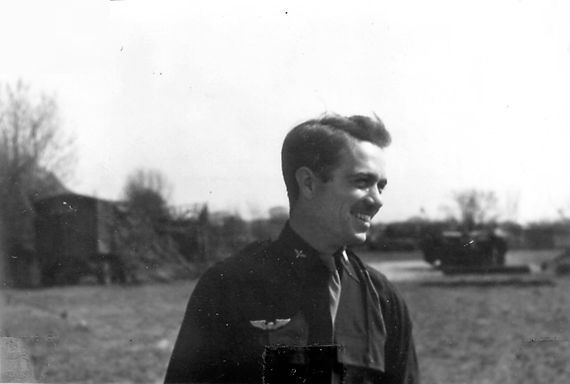
Norman Davis Hersberger
Photo Karen Owen via Glenn Wallace (Find a Grave)
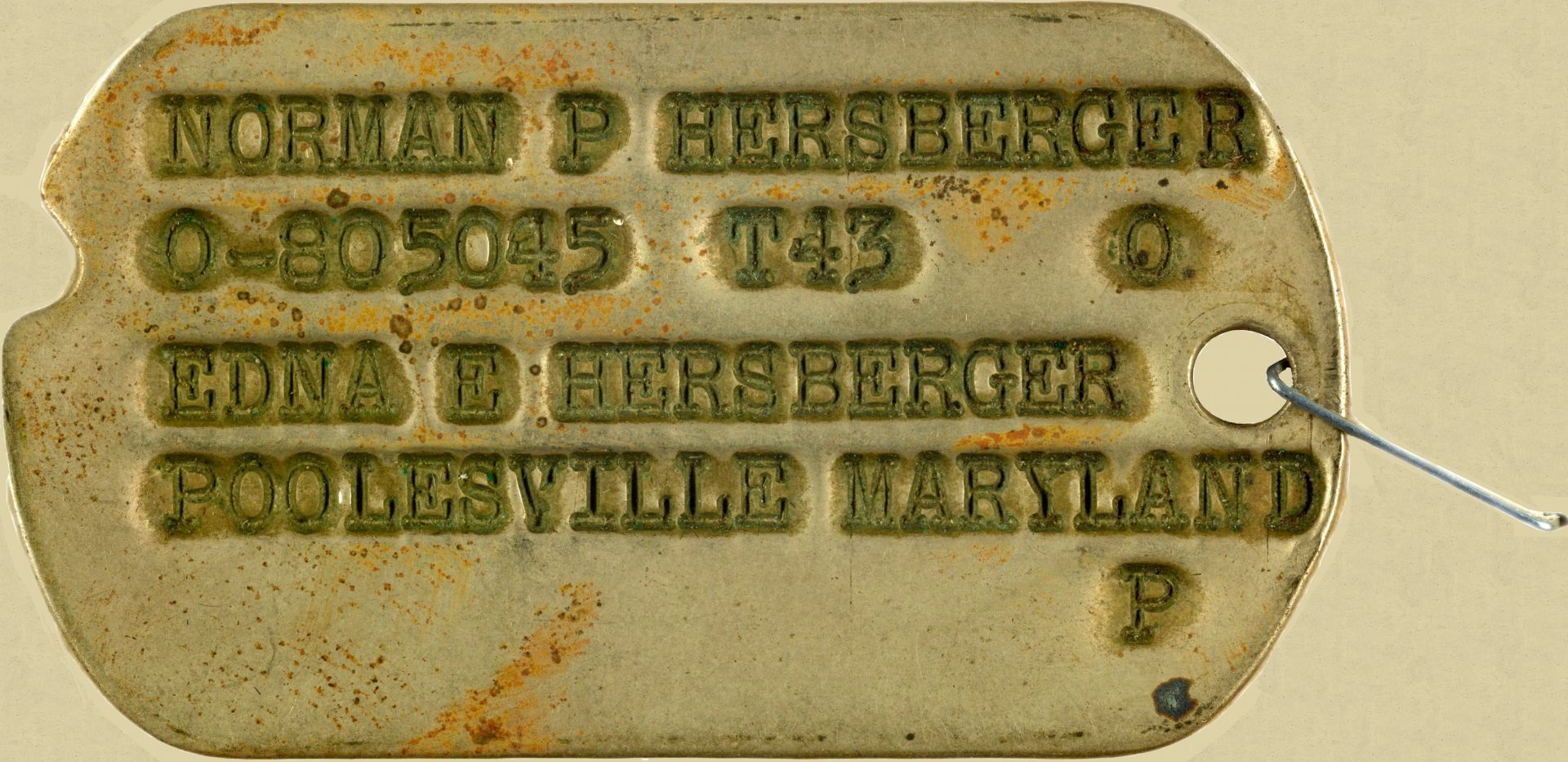
Norman Hersberger's military "dog tag".
This tag allowed the identity of a body to be determined in case of death
THE STORY (by Isabelle Guillermic)
Two American P-51B Mustang fighters crashed in Allaire on April 29, 1944
The 363rd Fighter Group (380th Fighter Squadron), a group equipped with P51 Mustangs, entered combat from England in February 1944, carrying out bomber escort and ground strafing missions. They participated in the invasion of Normandy, protecting gliders and troop transports on June 6 and 7. In September 1944, while based in Le Mans, France, the group was renamed 363rd Tactical Reconnaissance Group. Flying Lightning F5 and F6 aircrafts, the group collected photographic evidence of the location and strength of enemy positions in support of air and ground operations. They were particularly involved in supporting the Battle of the Bulge in the winter of 1944-45 and in the Allied efforts to break through the Siegfried Line in early 1945.
In April 1944, the group left Rivenhall for Staplehurst in Kent, England. Mr Bill Piper, of the Staplehurst Historical Society, points out that there wasn't actually an airfield at Staplehurst. Rather, a landing field was created on a farm near Staplehurst. It was a prototype of the Advanced Landing Ground (ALG) that would appear in France after the D-Day landings. It only lasted a few months. The American pilots and crew lived in tents. Mr Piper believes that Americans didn't visit Staplehurst much because there was little to do in the small community during the war, but when they did, they were made to feel welcome.
(a commemorative plaque has since been erected on the ALG site where some senior American officers attended the ceremony).
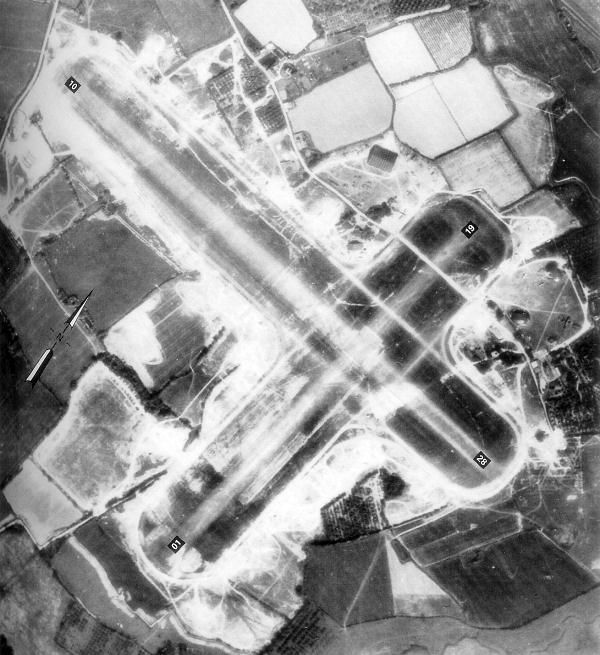
Aerial view of Staplehurst base on 21 May 1944
Photo: Royal Ordinance Survey - United Kingdom Government - Public domain
This April 29, 1944 is scheduled for the 8th Air Force, a massive attack mission on Friedrichstrasse station in Berlin. A large-scale program, since the following were to participate :
751 bombers from 8 Combat Wings equipped with B17s and four equipped with B24s, divided into three forces :
- the first force composed of 263 B17s, from four Combat Wings of the 3rd Bomb Division.
- the second force composed of 236 B17s, from four Combat Wings of the 1st Bomb Division.
- the third force composed of 252 B24s from four Combat Wings of the 2nd Bomb Division.
Fighter support from sixteen groups of VIII Fighter Command (593 aircrafts), four groups of IX Fighter Command (183 aircrafts) and two Squadrons equipped with P51 Mustangs belonging to the RAF (24 aircrafts). Two groups of P47s from VIII Fighter Command were scheduled to carry out a second sortie on the bombers' return flight.
On April 29, 1944, on returning from Germany, certain documents indicated a "briefing error" (perhaps an error in the return heading) and also the presence of fog.
However, other elements appeared :
- the 2nd Lt Norman Davis Hersberger saw his aircraft's fuel level reducing and realized he would not be able to return to England. The fighting over Germany was violent and long, and the fuel consumption was higher.
- the 2nd Lt Albert G. Johnson's aircraft appeared to be having engine problems (see appendix MACR 4431 and 4435). A return to England then appeared complicated.
They both then decide to leave their aircrafts at the same time. They were above the town of Allaire in Morbihan (56).
Residents of Allaire provide assistance to airmen who have fallen by parachute.
It was between 3 and 4 p.m. when Mrs Marthe RENAUDEAU saw the airman Norman Davis HERSBERGER falling a few meters from his house. His older brother, Maurice RENAUDEAU, refusing compulsory service, designated to go to Germany under the famous relief, wanted and summoned many times to the German court in Vannes, arrived on site and helped Norman to get rid of his parachute, then took him across the countryside. Norman fell 80 meters from the gendarmerie (in the garden ?), in a house under construction. In 2025, the old gendarmerie was converted into private housing and is located at 22 rue de Redon.
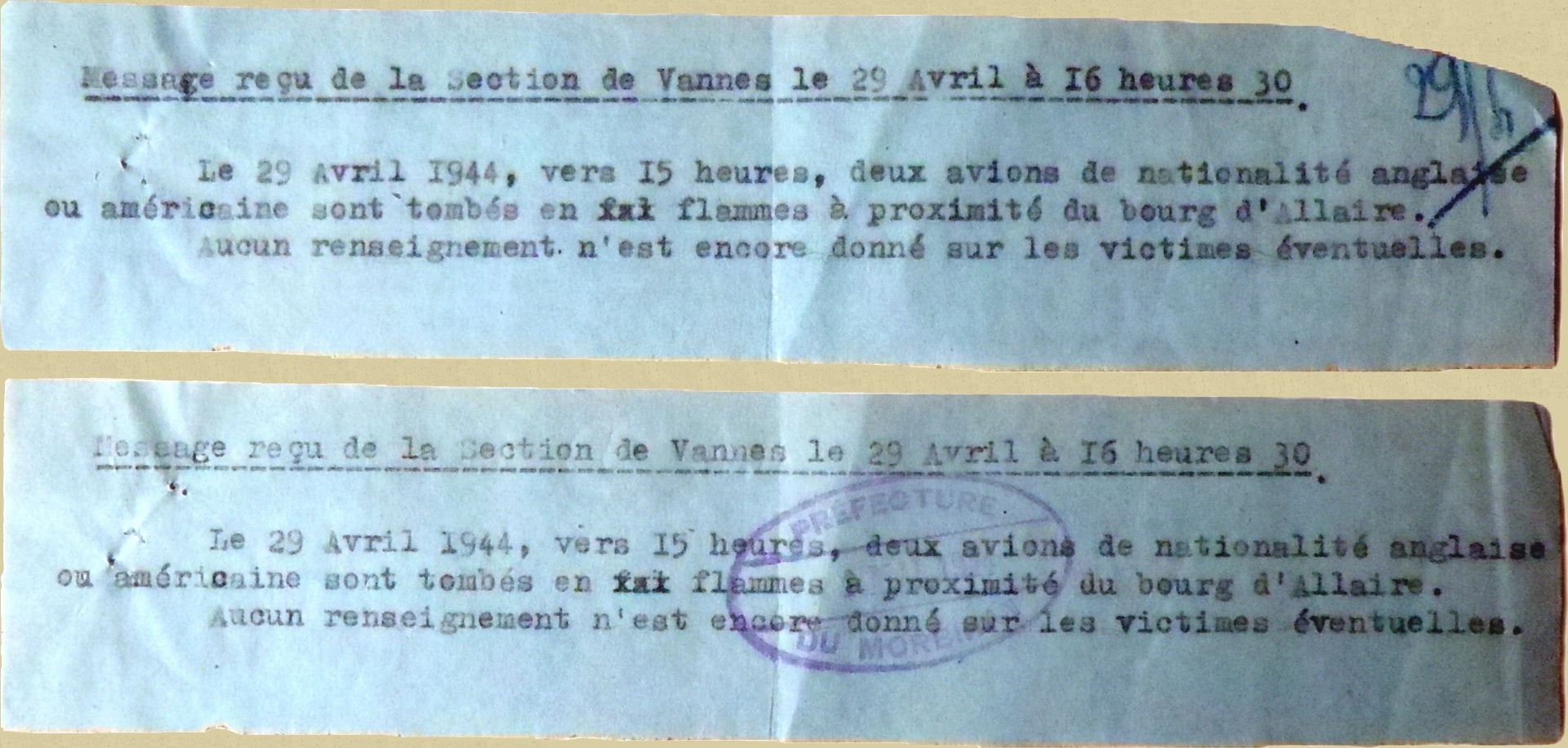
Messages from the Vannes Gendarmerie reporting the crash of two aircrafts which are said to have "fallen in flames" near Allaire
Source: Departmental Archives of Morbihan
Shortly after, the Gestapo arrived from Redon at the scene of the crash and began searching airmen, fortunately in vain. The Germans were furious with the French. They had seen airmen, but no one wanted to indicate the direction they had taken. The Allaire gendarmerie would also be criticized for its laxity by the Feldgendarmerie. Indeed, six hours passed between the crash and the Germans' visit to the gendarmerie without any search being carried out.
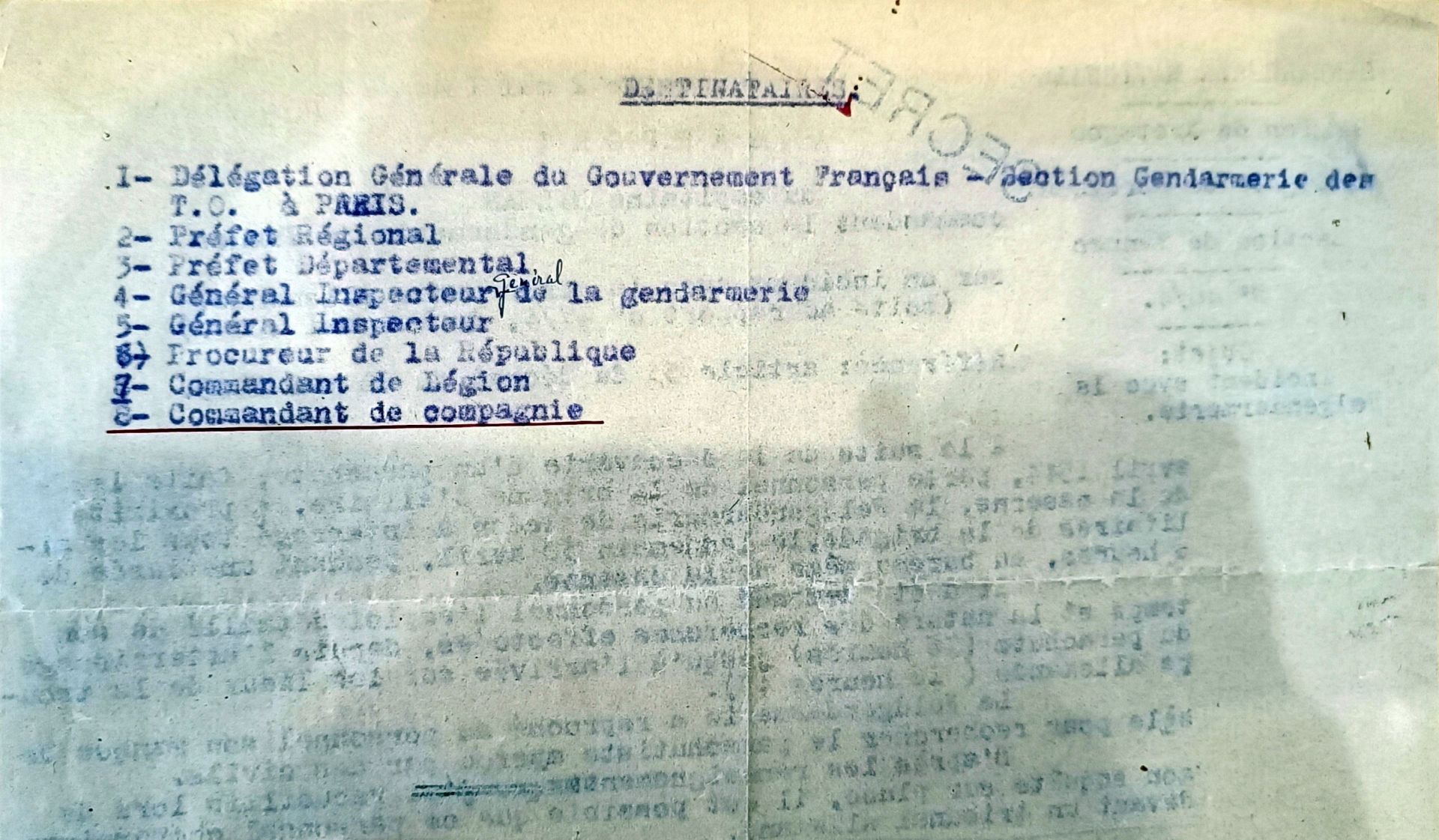
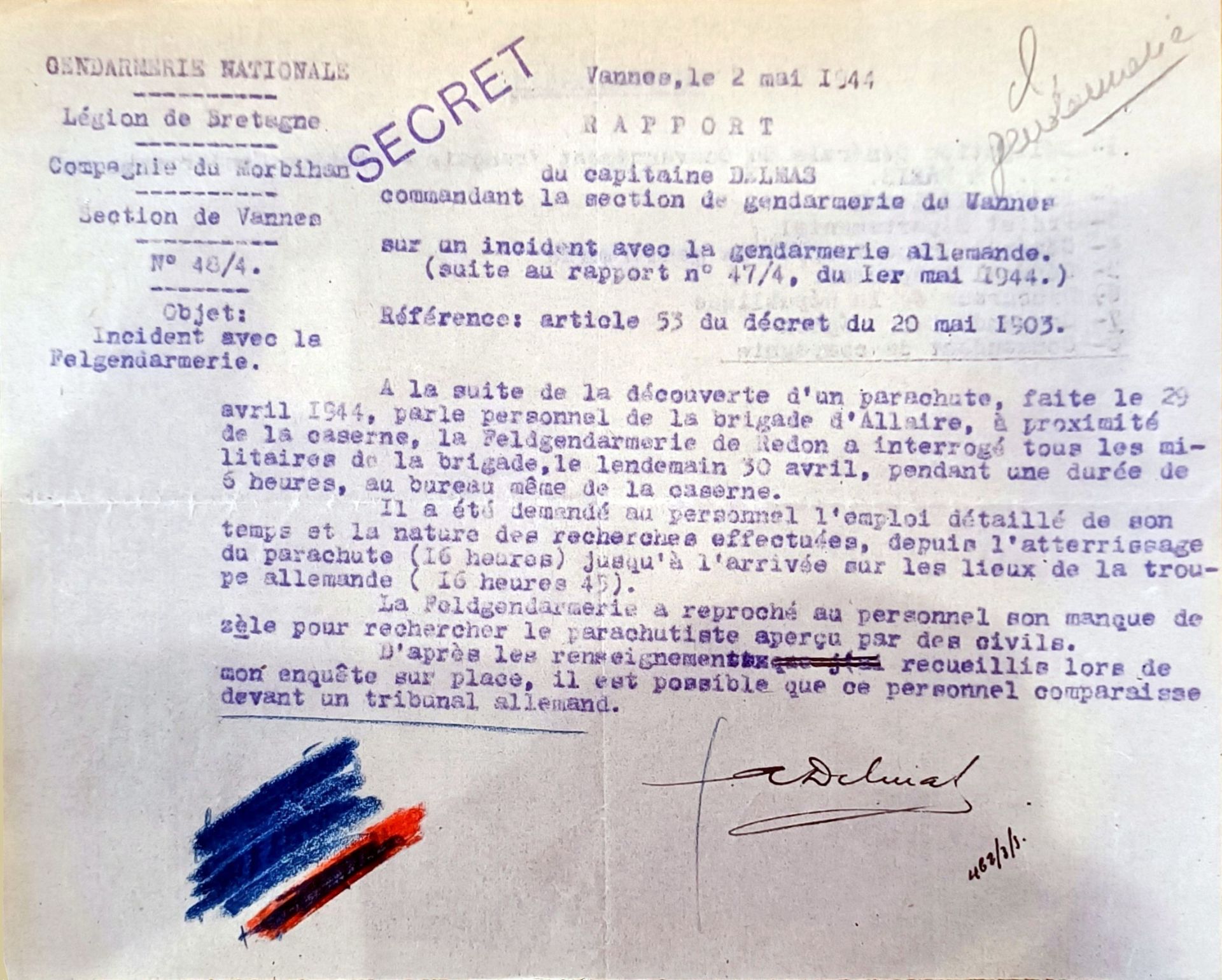
Message from the Vannes Gendarmerie which specifies that the Feldgendarmerie has criticized the French Gendarmerie
for his lack of enthusiasm in searching for the aviators
Source: Departmental Archives of Morbihan
Mrs Marthe RENAUDEAU then left to join her brother, equipped with clothes, with her younger brother. Arriving on site, she made Norman change clothes and left with him, completely changing direction to avoid pursuit. After many kilometers, they arrived in a safe place and as night fell, she left Norman exhausted. On Sunday, she did not move from the house, because the "jerries" were there and were still carrying out searches and questioning people. Finally, the next day, May 1st, a day off, she left with her brother to see Norman and his friend Albert G. JOHNSON, also fallen a few kilometers from Allaire. She jumped on their necks, offering them a bottle of champagne and some clothes. But unfortunately, on June 14, the Gestapo and the militia came for Marthe Renaudeau's father and he was deported to the Neuengamme concentration camp where he died after terrible suffering and deprivation. He was a teacher in Allaire.
Mr COYAC, in a statement, mentioned that after learning that Norman Davis Hersberger had been taken to safety, it was his duty, as a member of a resistance organization, to search for the second airman. Around 6:00 p.m., he learned that he was at his aunt's house.Mrs Widow CRUAUD at "Bot", in Allaire. He went to see him and, noticing that Albert G. Johnson was too close to the accident, he decided to move him to a safer place. But he realized that Albert G. JOHNSON had an injured leg (it had hit the tail of the aircraft when bailing out) and that he was untransportable. He then decided to postpone his exit until 1:30 a.m. On the May 1st 1944, after dressing him, he took him to another of his aunts, Mrs Widow JOUVANTE, to "Bled in Béganne". The journey was very difficult. JOHNSON could only use one leg. He was a 1.83 m tall fellow, so Mr COYAC had to carry him with a friend, Mr Georges LEBEL, for 3 km, through the woods. He indicated that at Madame JOUVANTE's, they gave him the best care and that JOHNSON could not forget the famous "Bérard" champagne, which they drank while talking about the victory that was near. In the evening, he dressed JOHNSON in brand new civilian clothes, gave him 2,000 francs and took him to Mr Auguste MOQUET in "La Beraye en Caden", where he met his friend, Norman Davis HERSBERGER. He noted in his testimony that he returned to Allaire with the 2,000 francs but not with the new suit. The MOQUET family lived in the castle of "La Beraye in Caden". A family of 10 children (at the time then 11 after the war). We were able to meet Mr. Alain MOQUET and his son Alban, in Monterblanc in March 2025.
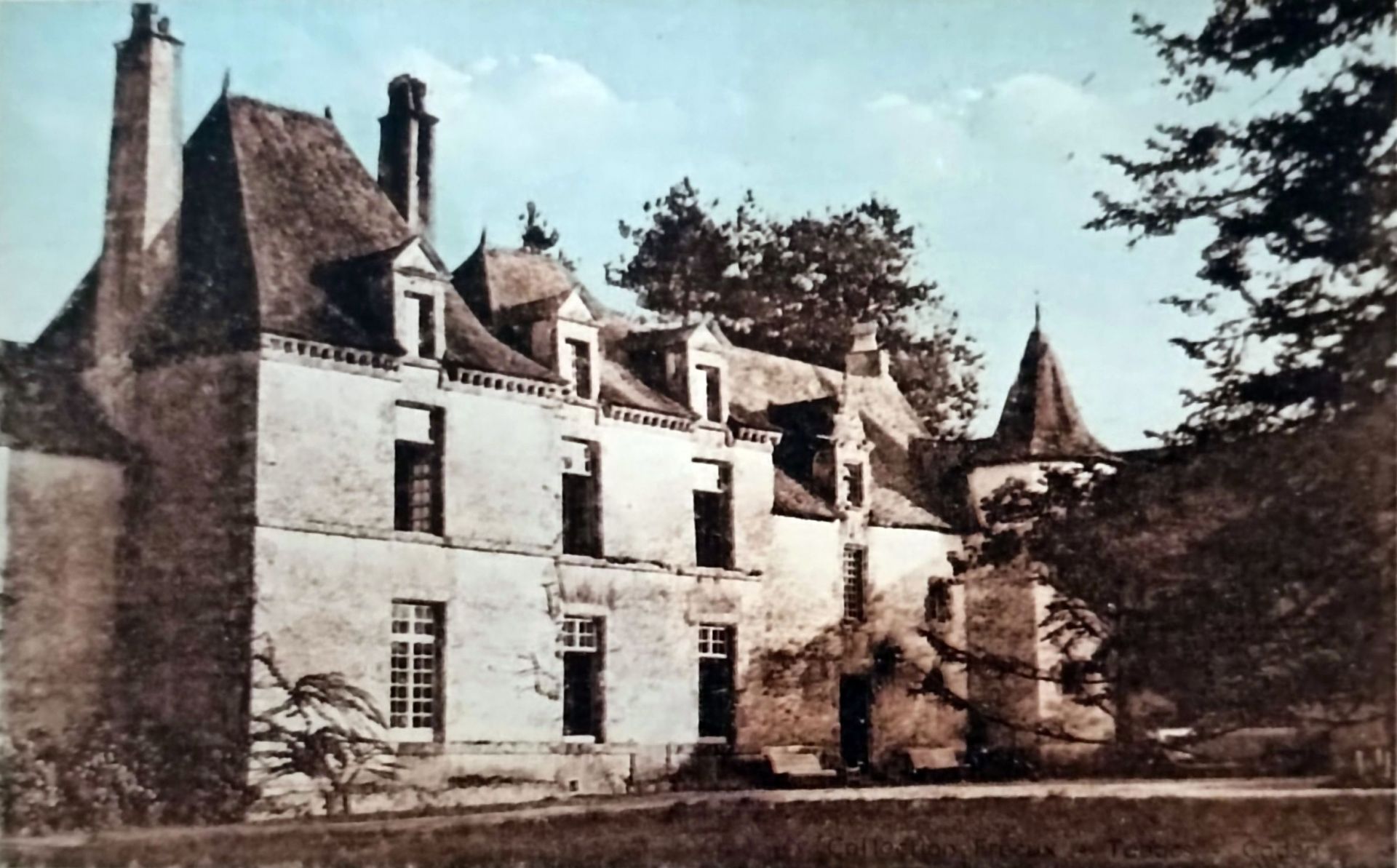
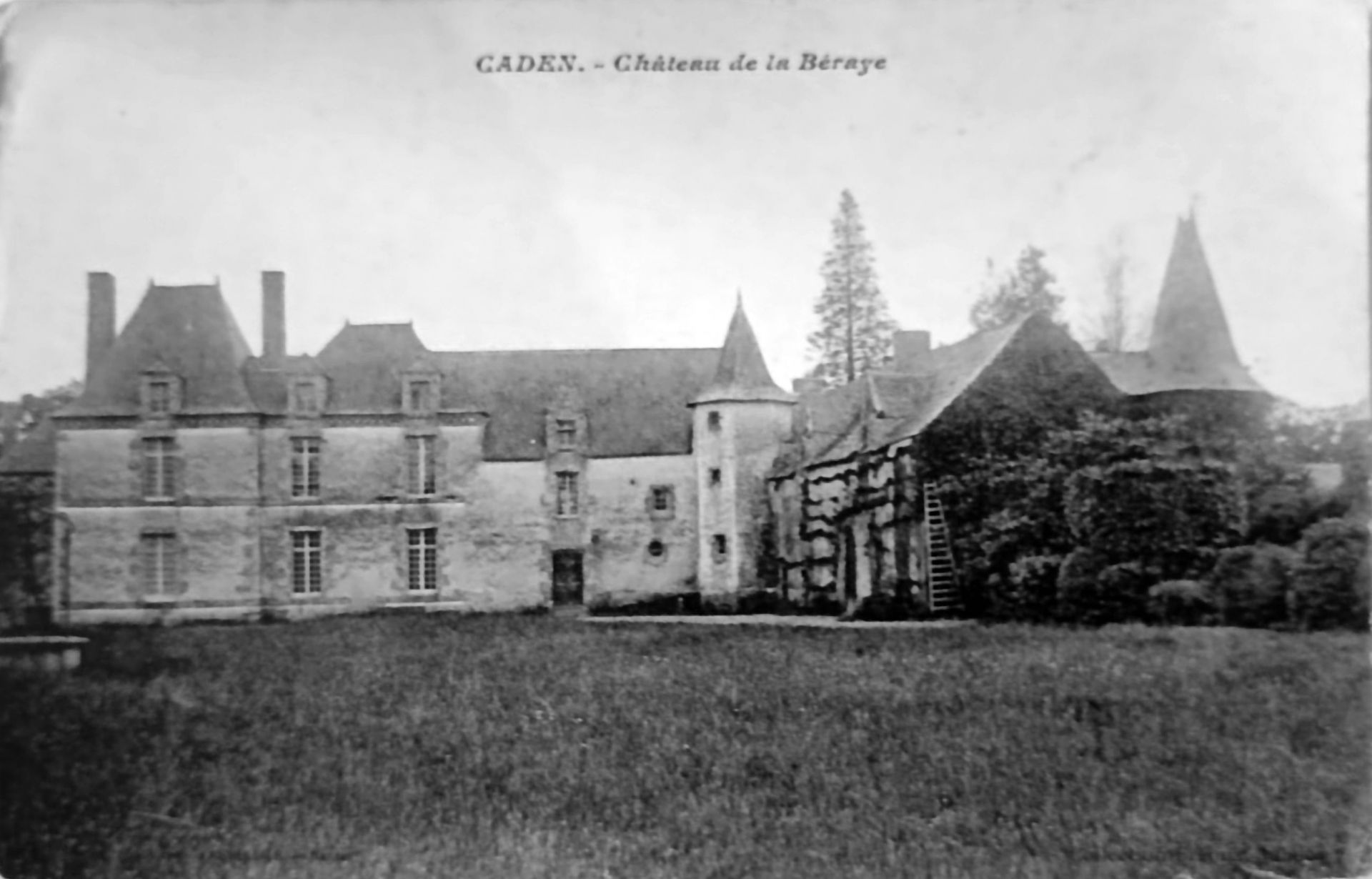
Two photos of the "Château de la Béraye" in Caden where Auguste MOQUET and his family lived.
Our two American airmen were hidden for a few days in the building on the right in the photo above.
(a ladder is along the wall of this building).
Photo : MOQUET family
While many crew members were hiding at "La Beraye", the children never encountered them. Allied flight personnel came out only at night. They were hidden in the attic of one of the estate's outbuildings (see photo above). Lieutenants Norman Davis Hersberger and Albert George Johnson stayed at the Château for 3 to 4 days. Then, the pilots were handed over to the BOA group commanded by Raymond CHEMIN to Saint Jean La Poterie, to take the train. Unfortunately in Bayonne, they were arrested.
In an article in the Monocacy Monocle by Rande Davis, (local newspaper published in Poolesville, Maryland, the village where Hersberger grew up - see also below the "Press coverage" section), Norman Davis HERSBERGER tells the rest of his story :
" Norman Davis Hersberger graduated from Poolesville High School in 1938. If you had asked him, who had spent much of his life in Covington, Tennessee, if he had any regrets about attending PHS, he probably would have said he should have worked harder in French. Six years after graduation, the young lieutenant found himself parachuting into enemy territory in France, six weeks before D-Day. He was rescued by the French Resistance and hidden in Brittany while plans were made to send him to Spain. Those plans were stopped when he was captured by the Gestapo. Fifty years later, in a letter, French Resistance fighter Jean Claude Moussat expressed to Hersberger what a hero he was, considering that he refused to give the Gestapo the names and contacts of the French Resistance who had come to his aid. Moussat wrote : « it was courageous to endure the torture of the Gestapo. Without your courageous silence, members of our own group and network would have been captured and killed ». Hersberger replied : « I am grateful for your help in enabling me to attempt to escape to England ».
Hersberger had flown thirty-nine missions when, on April 29, 1944, he and fellow pilot Albert Johnson, two Mustang fighter pilots on a bombing mission, ran out of fuel due to a malfunction of the radio transmission equipment. A sixteen-year-old boy spotted them after hearing the sound of the aircraft crash. The young man was working with Moussat, who led the resistance in the region. Hersberger recalled : « a teenager and a few other men rushed towards us as soon as we hit the ground. The boy was shouting 'Quick, quick,' so we started running ». Hersberger had learned some French at PHS and knew that it meant "quick". « Since they weren't brandishing weapons, we didn't ask any questions ».
It was Moussat, who had joined the resistance in 1940 to avoid being drafted into the German army, who led the interrogation of the young pilots. The men were given civilian clothes and false identity cards, and a perilous journey to Spain began. In great danger, they were hidden in barns and villages, traveling by bicycle in an attempt to reach the American embassy in Spain. One day, the plan changed to leave France by train. He was first taken to Paris and hidden for two weeks in an apartment. Leaving Paris, they traveled to Bordeaux, then to Dax, each city bringing them closer to Spain. But things went wrong. On June 5, 1944, the day before D-Day and just ten minutes before the train arrived in Dax, during a routine identity check, the Gestapo searched their compartment. « We were both supposed to be French. Johnson pretended to be deaf and mute, and I tried to use my French, insisting that I didn't understand English »..The interrogator almost handed Hersberger his ID card, « but when he asked me where I was going, by the time, I had translated what he had said to answer him in French, he became suspicious ». Then that the Gestapo agent shouted : « Zemite ! » [probably "Kommen Sie mit" which means "come with me"]. « I wish I had studied more French in high school, I probably would have been able to get by », he said fifty years later.
Hersberger always believed that it was impossible for the Gestapo to know his whereabouts without the help of an informant. From Bordeaux, they were taken to Gestapo headquarters in Bayonne. Hersberger gave only his name, rank, and service number, even under immense pain and torture. « The guy [interrogator] was so irritated that I didn't speak, and he came out from behind his desk and slapped me. The next thing I remember is that I was on the ground ». They called an executioner who, with a cane, began beating Hersberger until it broke. The executioner then used a rubber hose, then a baton, but was unable to make Hersberger talk. Hersberger tried to protect himself by covering his head with his arms. « I don't know how long the beating lasted, but it must have finally hit me
in the head, because the next thing I remember is being woke up in a dark basement with mud puddles and a leak dripping from the ceiling ».
Sleeping in crowded cells, on a flea-infested mattress, a straw mattress on the concrete, he began his eighteen-month prison sentence. With only a little bread, coffee, and sometimes beans, he was transferred to five different prisons in just over a year. At his capture, he weighed 82 kilos, but by the time he was handed over to German Air Force troops two and a half months later, he weighed only 44 kilos. Handcuffed, he and other prisoners were taken to Stalag Luft 13 in Poland [presumably Stalag Luft III, not 13]. Thousands of prisoners marched through the ice and snow to avoid Soviet troops. « A march began at 3 a.m. and lasted until evening, when they put us in barns », he said. Later, they were transferred to Nuremberg, and finally to Mossberg, where they were liberated by General George S. Patton's Third Army.
From his experience, he humbly said : « You never knew if you were going to get out of there. You had to rely on your will to survive to live ».
The Germans mistook them for the pilots of two other P-51 Mustangs
On April 29, 1944, two other Mustangs from the same unit having participated in the same mission (s/n 43-6804 piloted by the 1st Lt Arthur W. Jr OWEN and 43-6852 piloted by F/O Daniel G. DIYA) belly-landed around 2:45 p.m. near Saint-Jean d'Angely (then in Charente-Inférieure, now Charente-Maritime), 1 mile from the Saintes-Rochefort railway. German loss reports below attest to this.
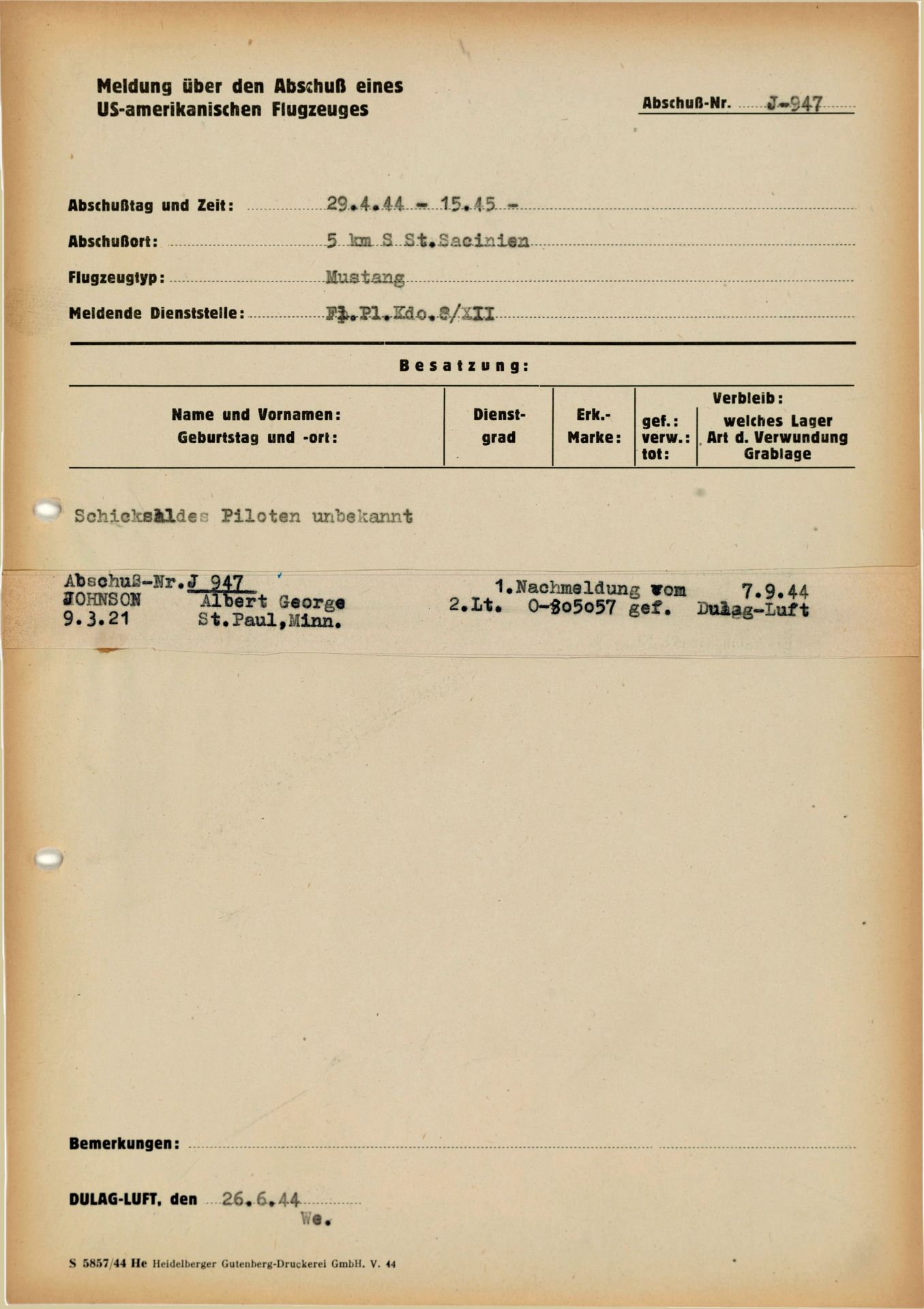
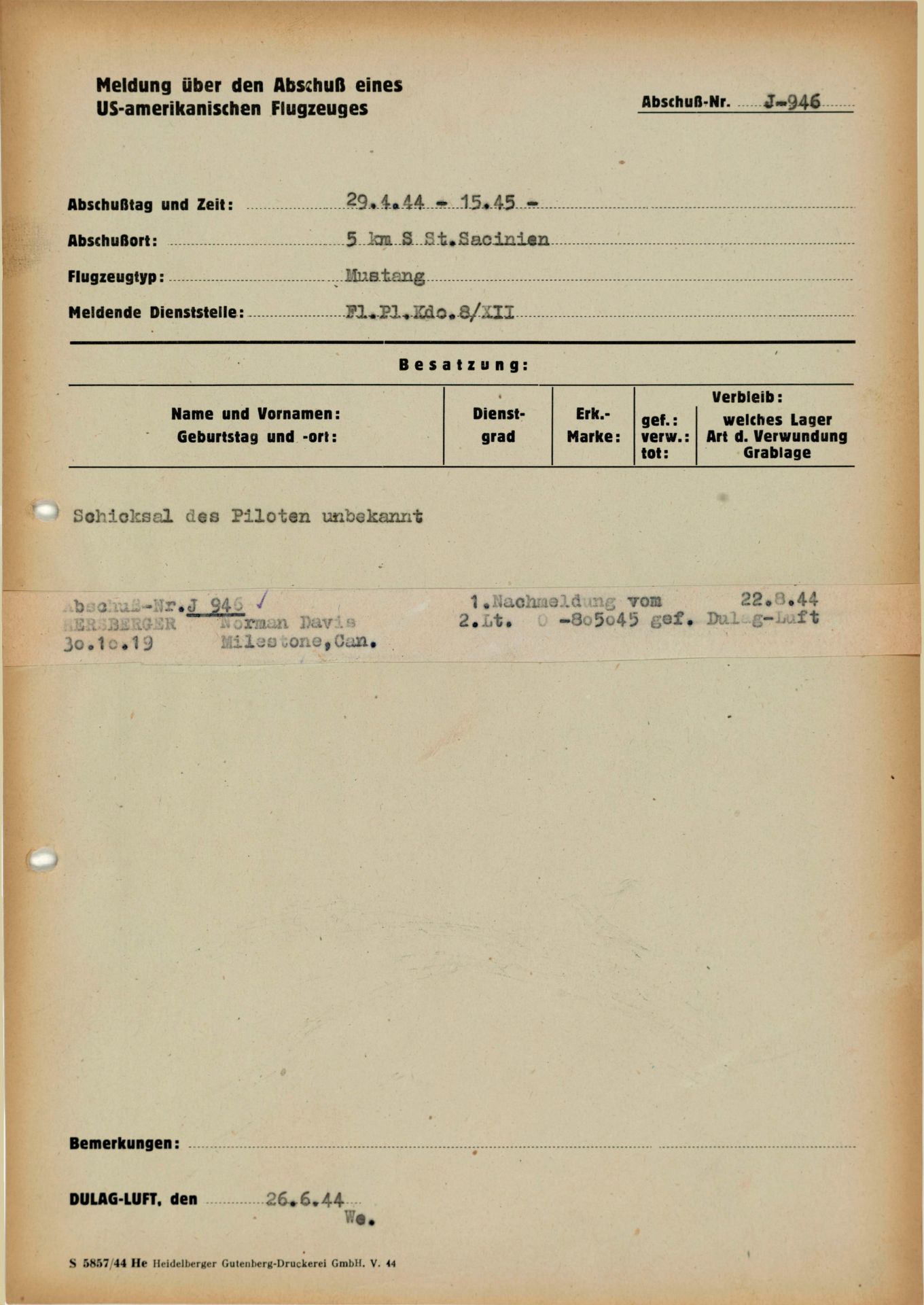
In these documents, apparently drawn up late (Nachmeldung = late registration), the Germans clearly questioned their
prisoners, who have been in a transit camp for aviators (Dulag-Luft) since June 26, 1944
(i.e. 21 days after the capture of Albert JOHNSON and Norman HERSBERGER), ;
They know their registration numbers and their dates and places of birth. The Germans indicate that they are pilots of downed Mustang aircrafts.
April 29, 1944 at 3:45 p.m., 5 km from Saint Sacignien (understand Saint-Savinien), therefore not far from Saint-Jean d'Angely.
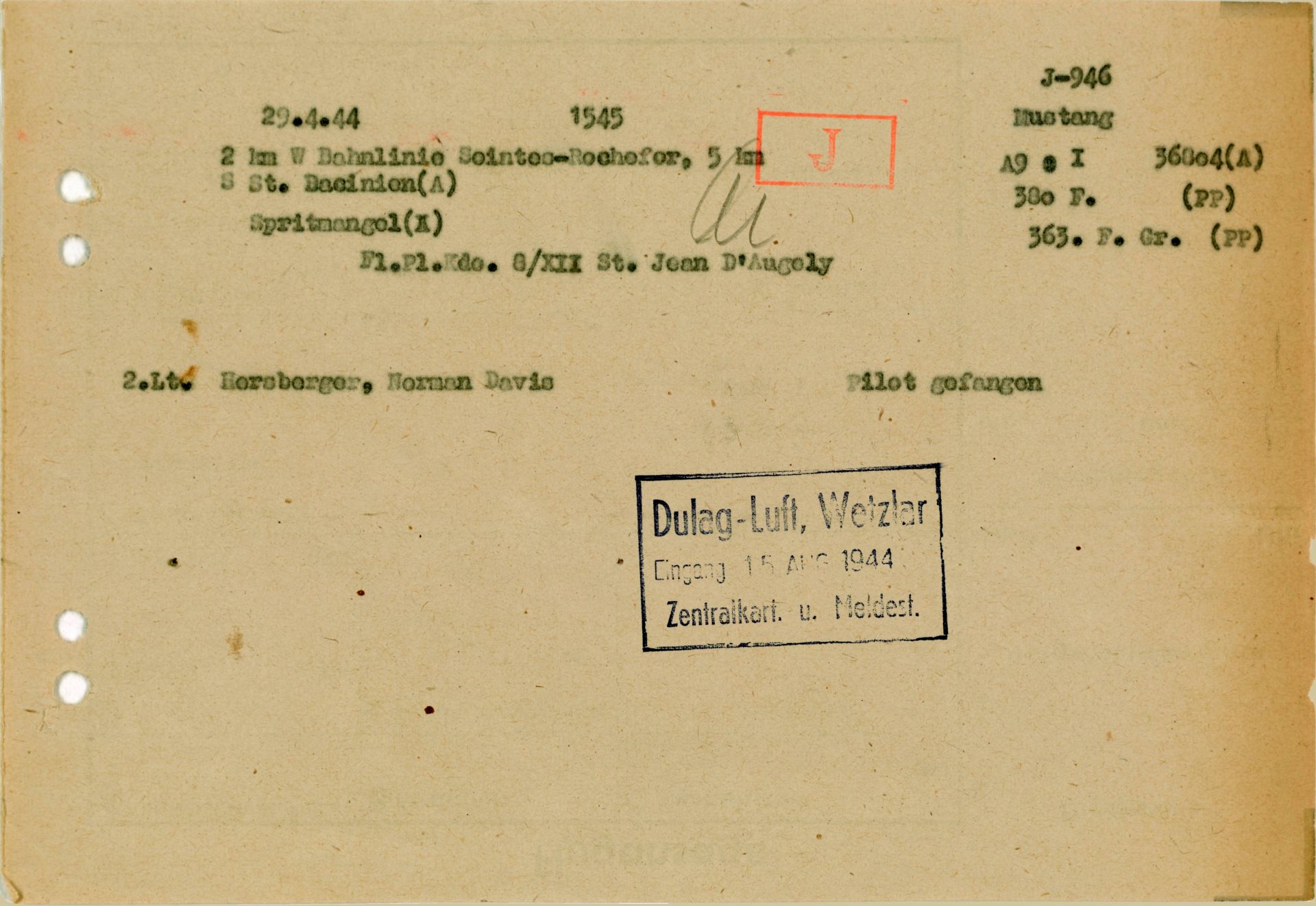
On this other document, the Germans attribute to HERSBERGER the Mustang P-51 s/n 43-6804 which fell along the
Saintes-Rochefor(t) railway line not far from Saint-Bacinien (actually Saint-Savinien).
In reality, it was the aircraft of 1st Lt Arthur W. Jr. OWEN.
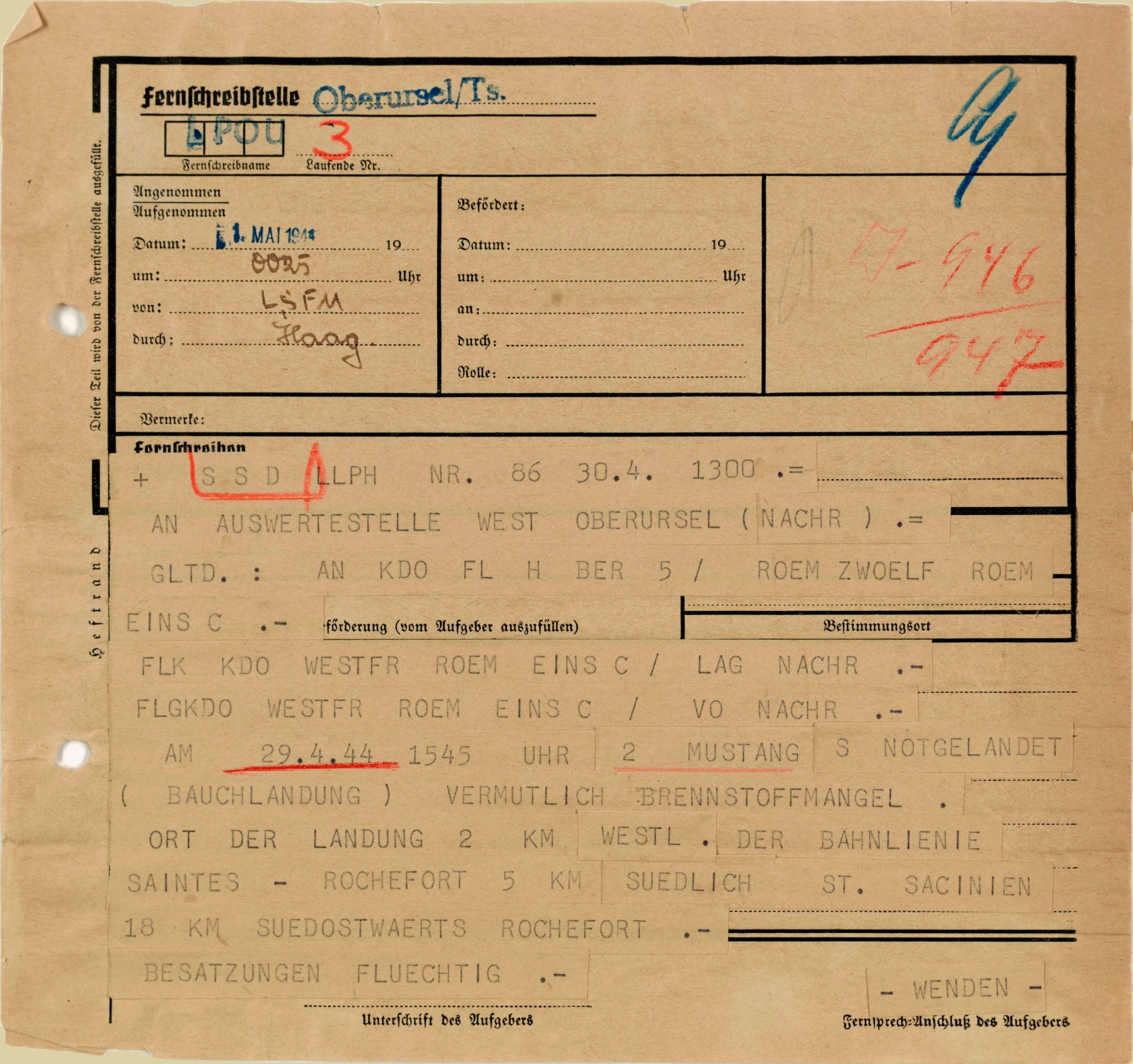
In this document, the Germans state that on April 29, 1944, two Mustangs made an emergency belly landing, probably due to fuel
shortages. The landing site was 2 km west of the Saintes-Rochefort railway line,
5 km south of Saint Sacinien (Saint-Savinien), southeast of Rochefort. The pilots fled.
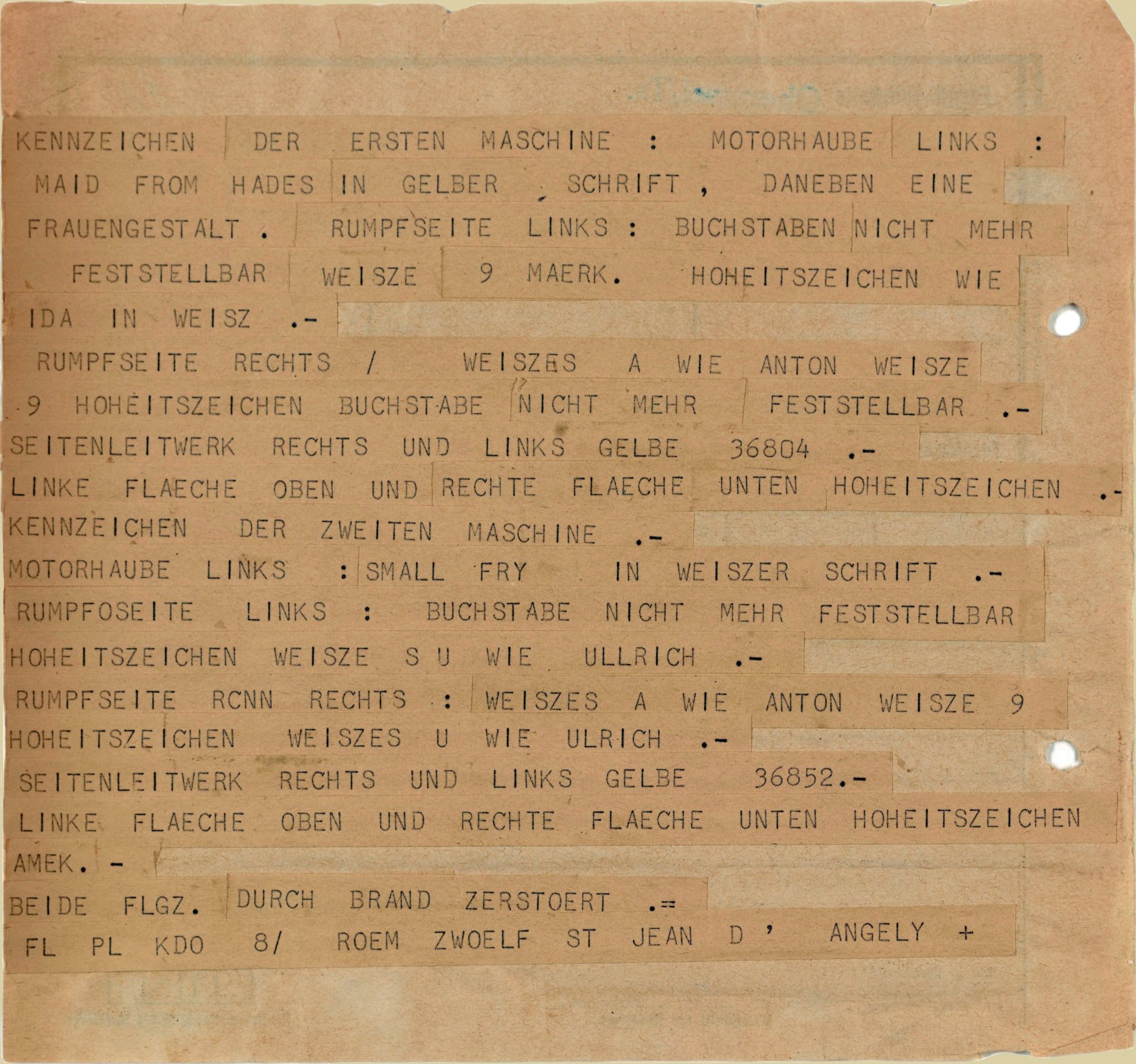
Finally, on this last document, the Germans describe the two Mustangs that they attributed to Johnson and Hersberger. They give
in particular the serial numbers of the aircrafts (43-6804 and 43-6852) which leaves no doubt that it was not
the aircrafts of our two airmen but that they were indeed those of OWEN and DIYA.
The 1st aircraft had "Maid from Hades" written on the left side of the engine in yellow letters next to a drawing of a woman.
On the left side of the fuselage, unidentifiable letters, a "9" and white national emblems and on the right side a white "A" and "9".
On each side of the aircraft's tail, "36804" written in yellow (thus s/n 43-6804).
For the 2nd aircraft, "Small fry" was written in white letters. On the left side of the fuselage, unidentifiable letters and a white "U" were written.
On the right side, in white, an "A", a "9" and a "U". On the tail, "36852" in yellow (so s/n 43-6852).
The American star above on the left wing and below under the right wing.
Both aircrafts were destroyed by fire.
.
Thanks to :
- Mr Alain MOQUET for his testimony
- Mrs Ann Trevor for her research on "Helpers" at the American National Archives in Washington.
- Mr Rande Davis of Monogacy Monocle, Barnsville, Maryland (USA) : website
- Mr Tristan Leroy from the Museum of the Resistance in Brittany - Saint-Marcel (56) : website.
Source documents :
- Departmental Archives of Morbihan (56).
- US National Archives in Washington (via Ann Trevor).
TESTIMONIALS
Xxxxx
VICTOIRE CRUAUD, MARTHE RENAUDEAU, PAUL AYOUL, JOSEPH COYAC AND AUGUSTE MOQUET, ALLAIRE'S "HELPERS" (investigation carried out in the National American archives at Washington with the invaluable assistance of Ann Trevor, volunteer historian).
At the end of the war, the Americans began to identify and thank those who had assisted airmen, the "helpers." This recognition sometimes resulted in a financial reward based on the level of risk taken by these "helpers." These rewards could be requested by the "helpers" themselves, or, more often, by their relatives. For each "helper," more or less documented files exist in the American National Archives in Washington.
In the case of our two airmen who fell at Allaire, a veritable chain of solidarity was established to hide them, and the Cruaud, Renaudeau, Ayoul, Coyac, and Moquet families were involved. You will find in appendices (below) copies of their files, collected by Ann Trevor, an American volunteer historian. Here is a summary of our helpers' involvement
♦ Paul AYOUL lived on the road to Vannes, in Allaire (56). He was a student, born on January 25, 1925, a war amputee (discharged) but nevertheless a member of the Resistance group AS (Secret Army). He was arrested on June 19, 1944, with other resistance fighters, on their return from a fight in Saint-Marcel, but they managed to escape. In April 1944, he was tasked with finding the airmen and returning them to a safe place, at "La Beraye" in the MOQUET family.
♦ Joseph COYAC lived in "Belle de Mai" in Béganne (56). Born on July 3, 1904 in Redon (35), he was a farmer but also a former F.F.I. Sergeant and group leader in the National Front (1st November 1943). Father of three children (12, 10 and 1 year old at the time), he was married to Marie-Ange JOUNIER (33 years old in 1946). He indicated that JOHNSON was injured jumping from his aircraft : his leg hit the tail of the aircraft. He learned from his aunt, Mrs Widow CRUAUD, that this airman was hiding at her home, in "Bot", in Allaire. Believing that it was too risky because he was close to the Germans, he transported JOHNSON to another aunt in "Bled", in Béganne, Mrs Widow JOUVANCE, on the night of April 30 to May 1st 1944, at around 1:30 a.m. With his resistance comrade Georges LEBEL (living at 17 rue Pajol, in the 18th arrondissement of Paris in 1946), he had to carry JOHNSON, injured, for 3 km through the woods. Arriving at Mrs JOUVANCE's house, they toasted the Champagne. Then they dressed JOHNSON in civilian clothes and took him to Auguste MOQUET's house in "La Beraye en Caden".
He indicated that he also knew that HERSBERGER, who fell the same day near the Allaire Gendarmerie, was helped by the RENAUDEAU family living in the village of Allaire. Unfortunately, Mr. RENAUDEAU senior, a teacher and member of the National Front, was arrested on June 14, 1944 and deported to a concentration camp from which he did not return. Joseph COYAC specified that from April 30 at 7 p.m. to May 2 at 1 a.m., he only left his "protégé" JOHNSON for an hour to go and get him some cigarettes that he was asking for.
♦ Auguste MOQUET et Suzanne Hortense MOQUET (née DOLU) lived at the "Chateau de la Beraye" in Caden (56) and had (at the time) 10 children (19, 18, 17, 16, 15, 13, 12, 11, 10 and 9 years old in 1946). Mrs MOQUET declared having helped airmen from June 29, 1943 to the end of April 1944 (but the resistance activity of the MOQUET family was effective throughout the war, from 1939). Auguste MOQUET, born May 11, 1900 in Langon (35), was a farmer. They hid George H. GLOUDERMAN on June 29, 1943, co-pilot of the B-17 s/n 42-29847 which fell on June 28, 1943 in Muzillac, and our two aviators HERSBERGER and JOHNSON for 4 days in April 1944. Auguste MOQUET was adjudant in the AS (Secret Army) in the Rochefort-en-Terre group (56). He was released in May 1945.
PARTS OF ONE OF TWO P-51'S FOUND 60 YEARS LATER
The remains of Albert JOHNSON's aircraft appeared in 2004, 60 years later, when a farmer noticed that his cows were damaging their legs in a bramble grove located in a formerly marshy area. He then discovered a radiator and a number of fragments under the thorns. Gérad CERIZIER*, interested in the history of the Second World War, was contacted and took charge of extracting the pieces of the aircraft. He then decided to give the parts of the P-51 to the Resistance Museum in Saint Marcel, in gratitude for the help provided by the Breton resistance fighters to the two American pilots. The pieces are currently stored at the Morbihan Aéro Musée in Monterblanc.
After the war, Mr. Lebel, who helped Albert George Johnson, received several letters from him. He even considered tracking down the pilots, 22 years later. Unfortunately, his letters remained unanswered, and the Mayor of Allaire at the time was uncooperative.
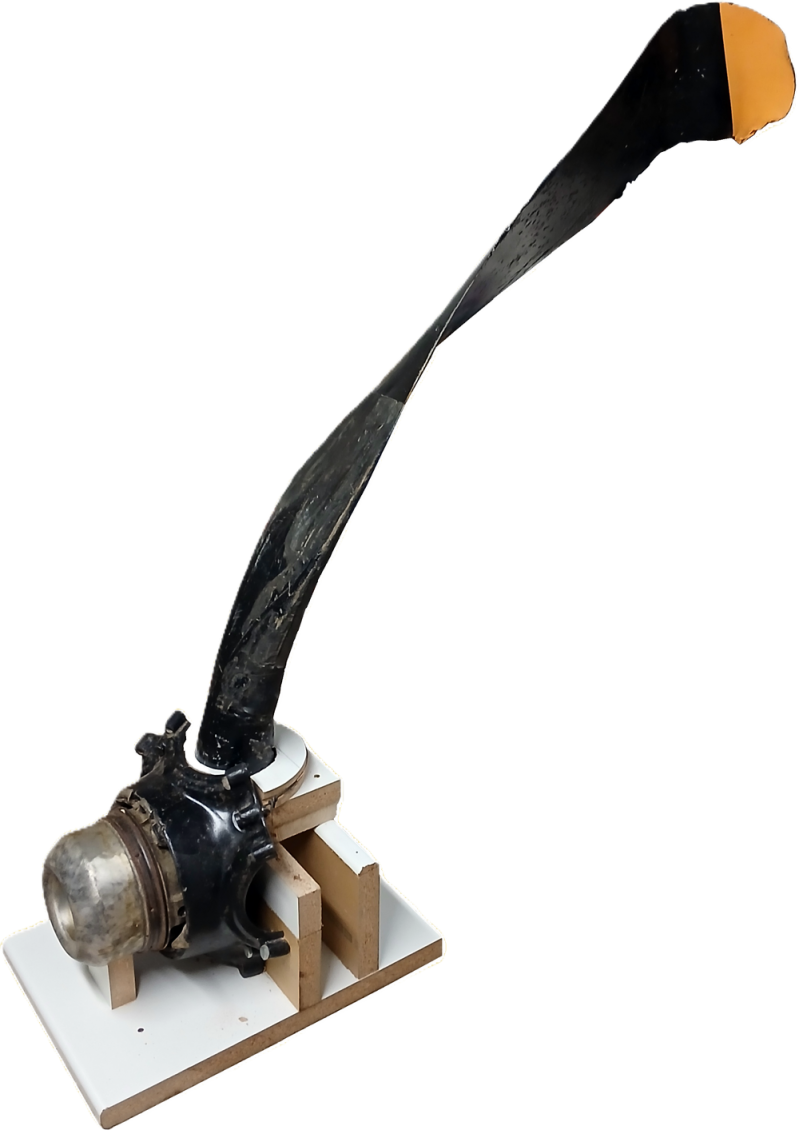


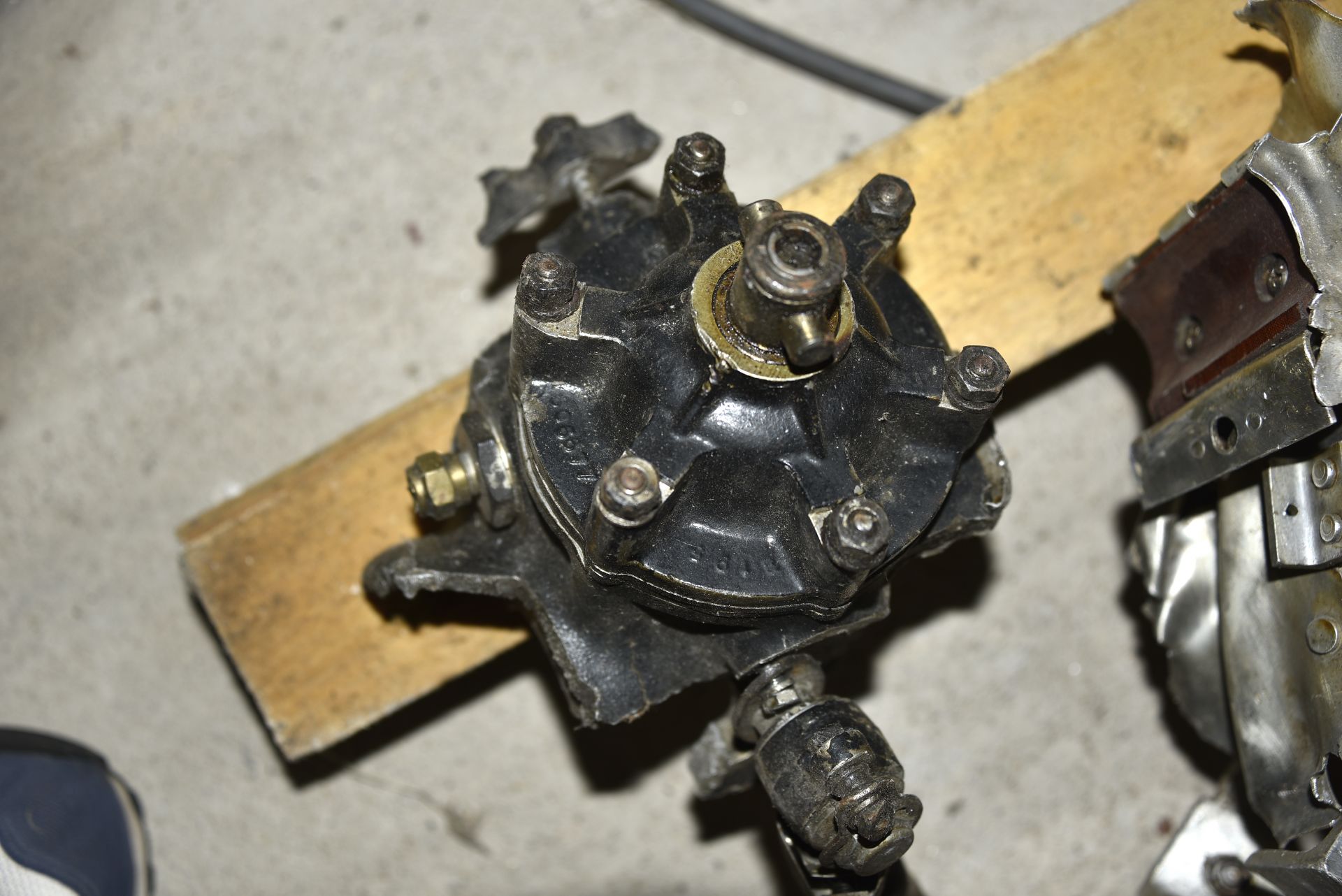
Parts of one of the two P-51Bs that fell at Allaire, recovered in 2004 by Gérard CERIZIER, donated to the Resistance Museum in Brittany
are currently on loan to the Musée Aéro Morbihan for exhibition.
Photo Philippe Guillermic
Furthermore, a small piece of metal, likely from the fuselage of Norman Hersberger's P-51, was kept (and framed) by the Sébillet family. Inscriptions were probably engraved on it at the time by the people who found it. It appears to read "Derrière notre maison - avion américain (ou avion Allaire) - Behind our house - American aircraft (or Allaire aircraft)."
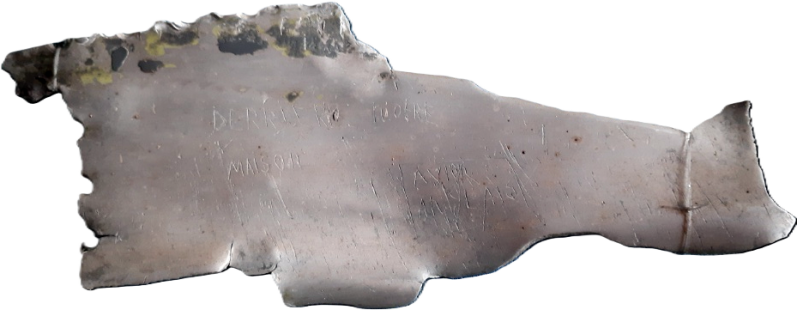
Photo Brigitte Mary taken at Mr. and Mrs. Sébillet's house
* Gérard CERIZIER is now a member of ABSA 39-45
IN THE PRESS
Norman Davis Hersberger grew up in Poolsville, Michigan. Poolsville's local newspaper, the "Monogacy Monocle", covered this pilot's story in 2007 and again in 2023 with two long articles. Following our 2025 research, and through Isabelle Guillermic, Rand Davis dedicated a new article in its April 2025 issue to discuss our research and the upcoming commemoration work (April 29, 2025).
• The Monogacy Monocle, May 2025 : (website : Monogacy Monocle)
with courtesy of Rande Davis, Barnesville, Maryland (USA)
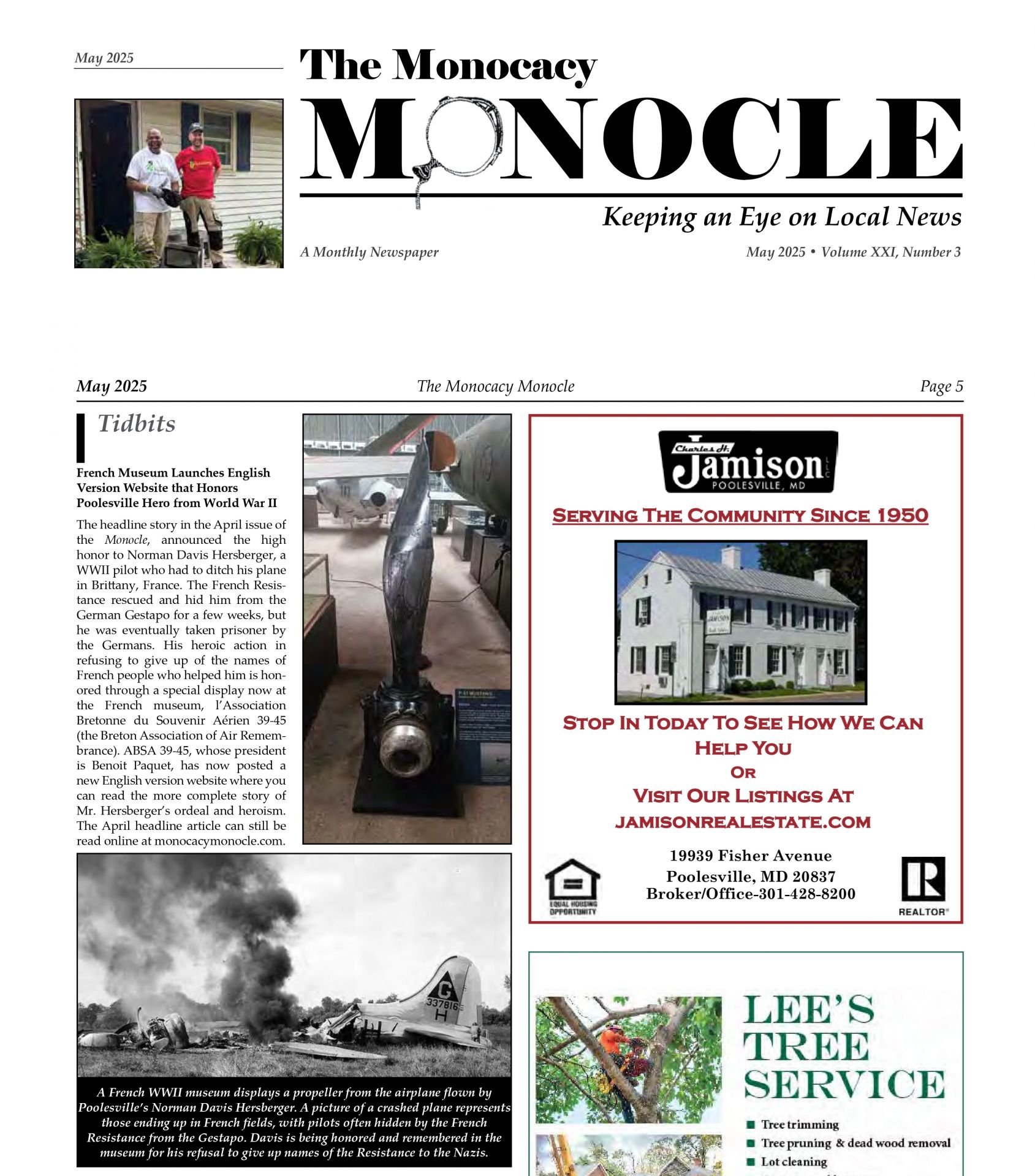
• The Monogacy Monocle, April 2025 : (website : Monogacy Monocle)
with courtesy of Rande Davis, Barnesville, Maryland (USA)
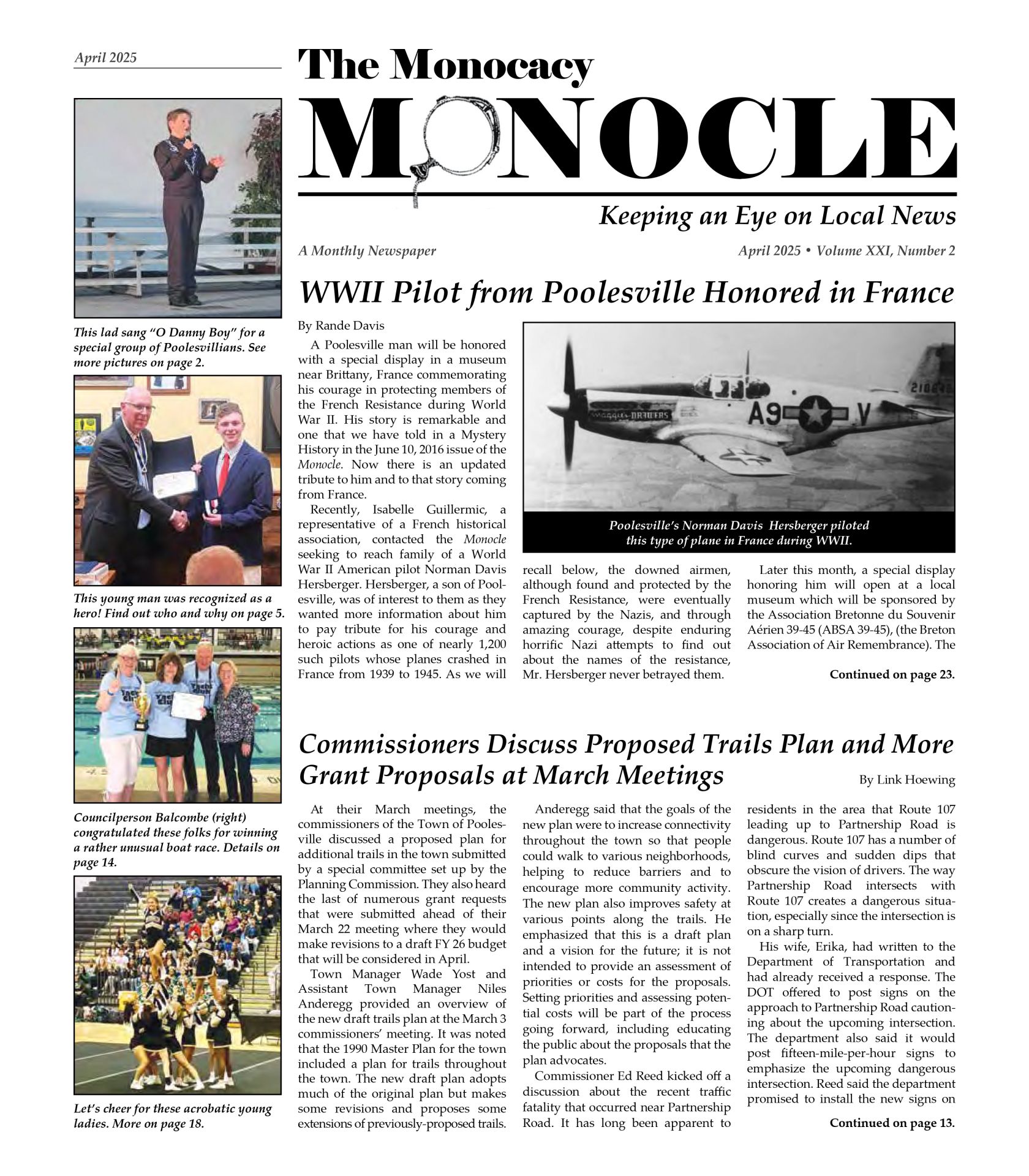
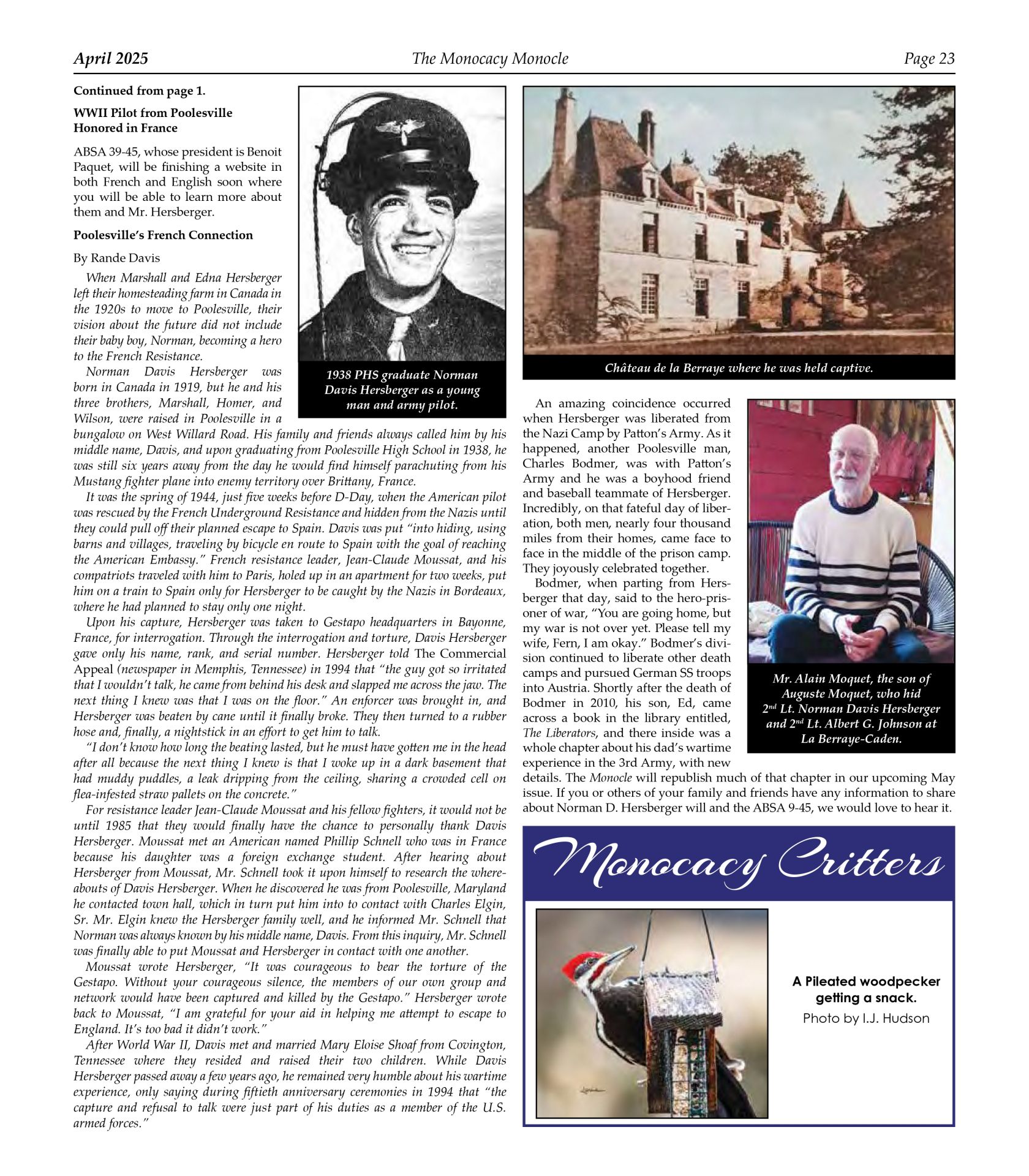
• The Monogacy Monocle, March 31, 2023 : (website : Monogacy Monocle)
with courtesy of Rande Davis, Barnesville, Maryland (USA)
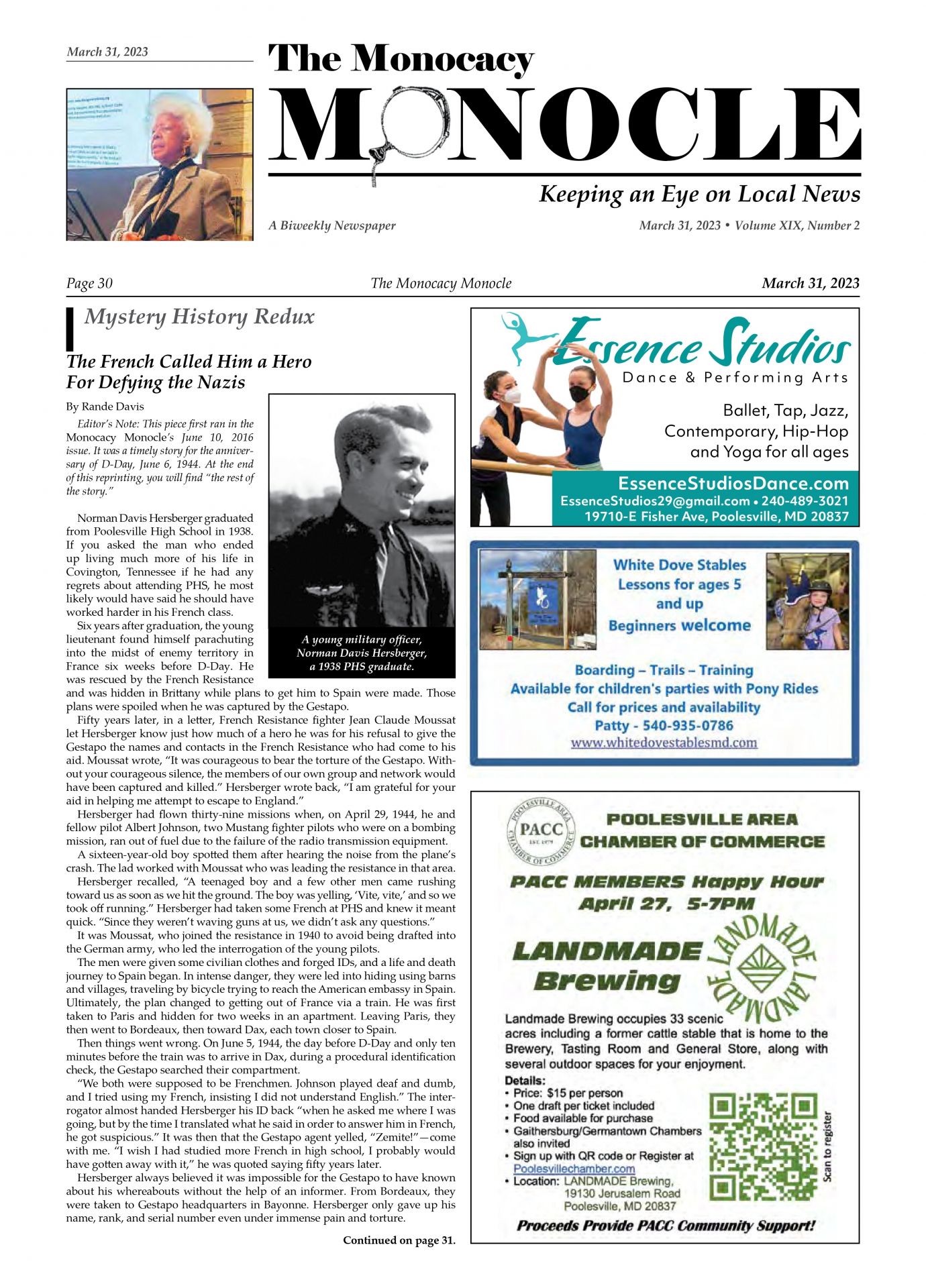
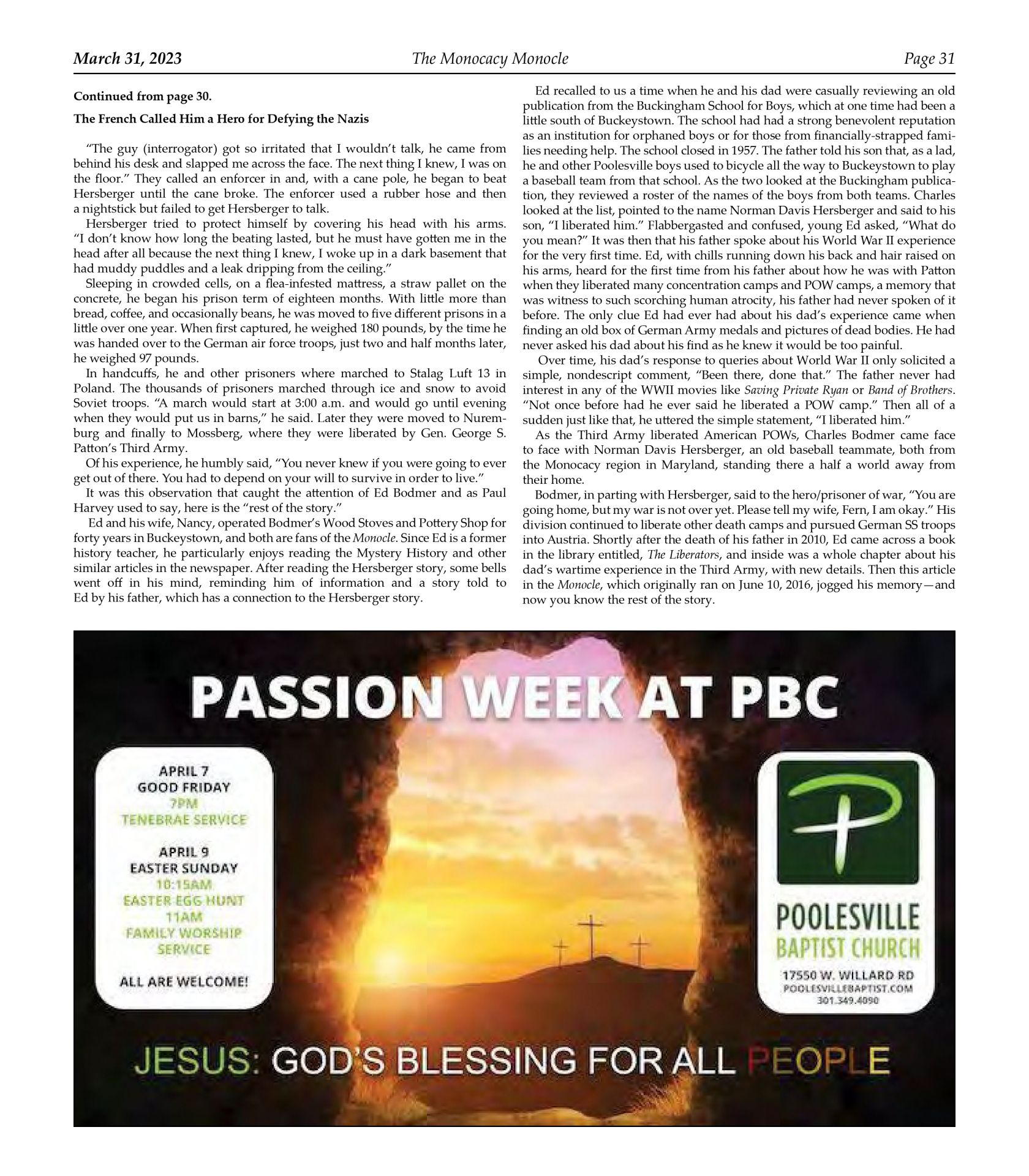
• The Monogacy Monocle, March 16, 2007 (website : Monogacy Monocle)
with courtesy of Rande Davis, Barnesville, Maryland (USA)
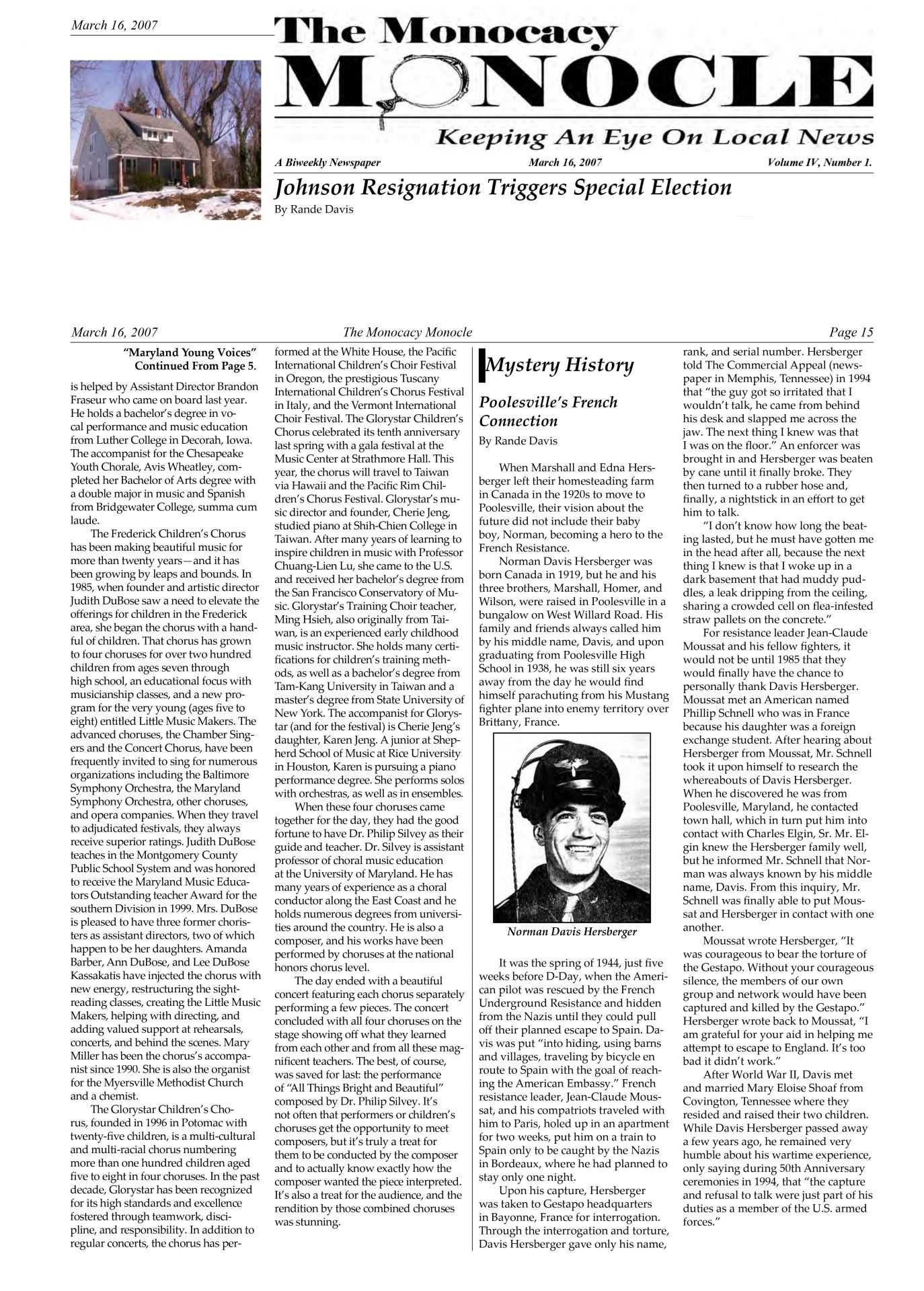
APPENDICES
• Missing Air Crew report # 4431 concerning Norman Davis HERSBERGER.
(source : US National Archives)
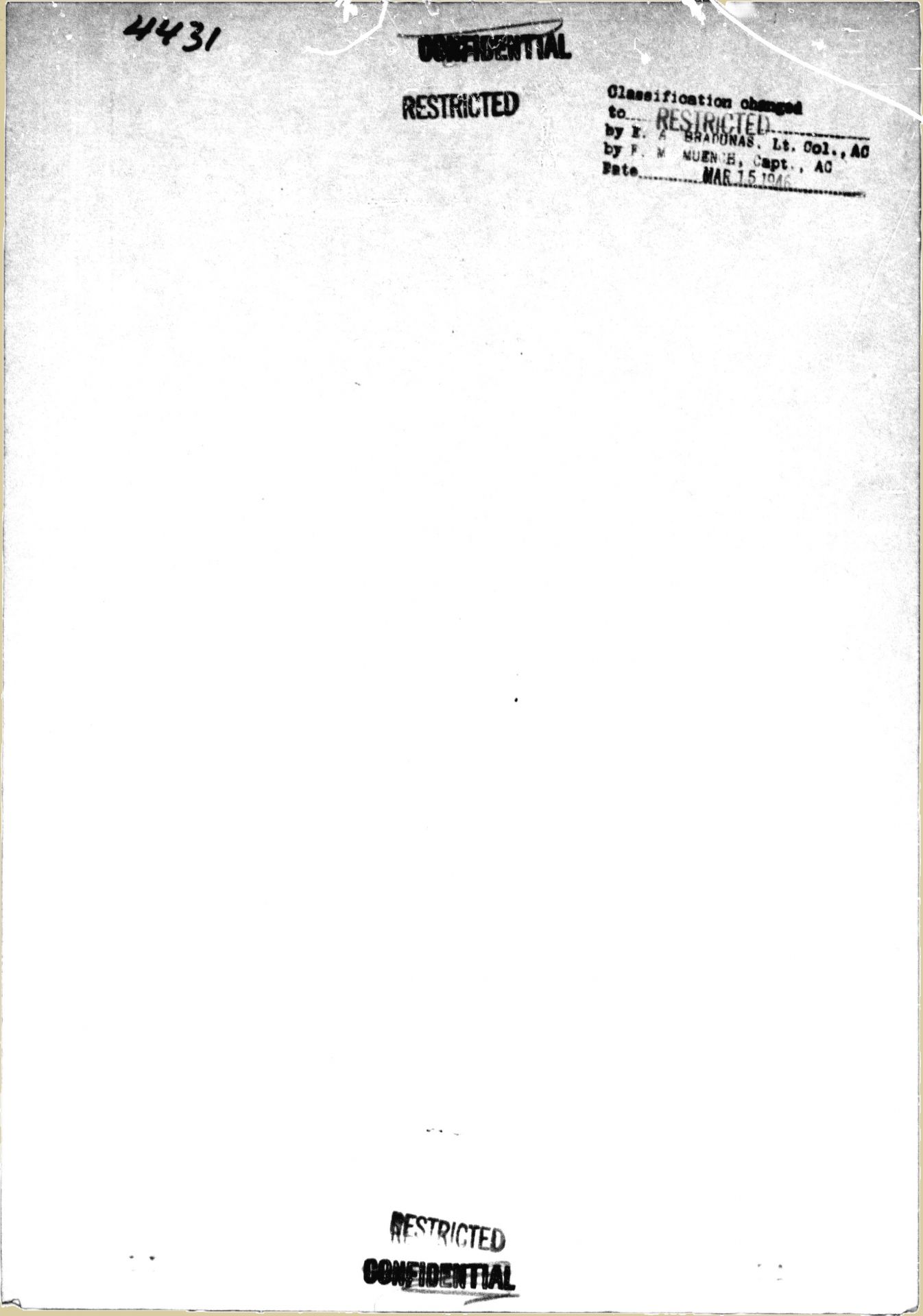
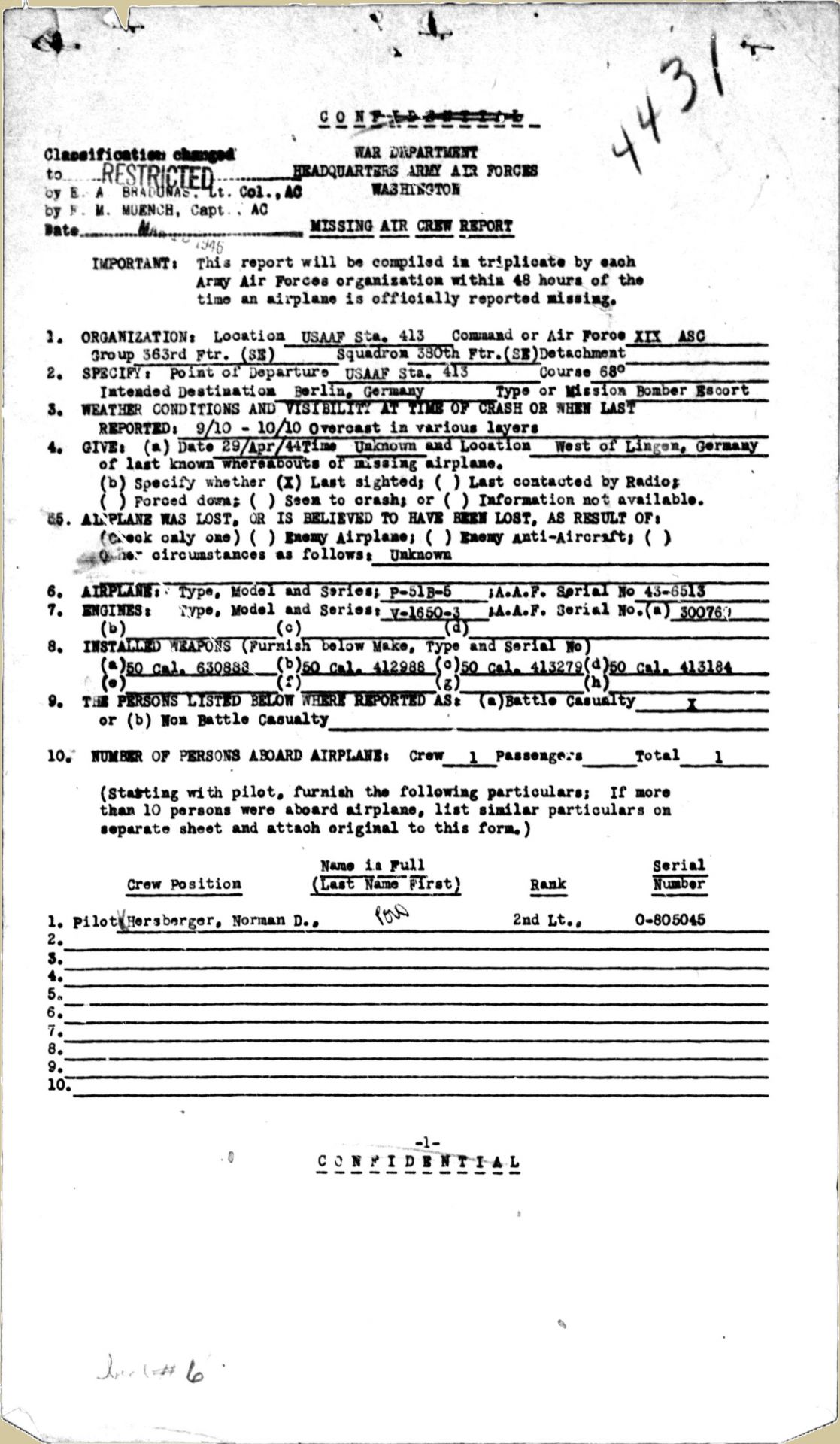
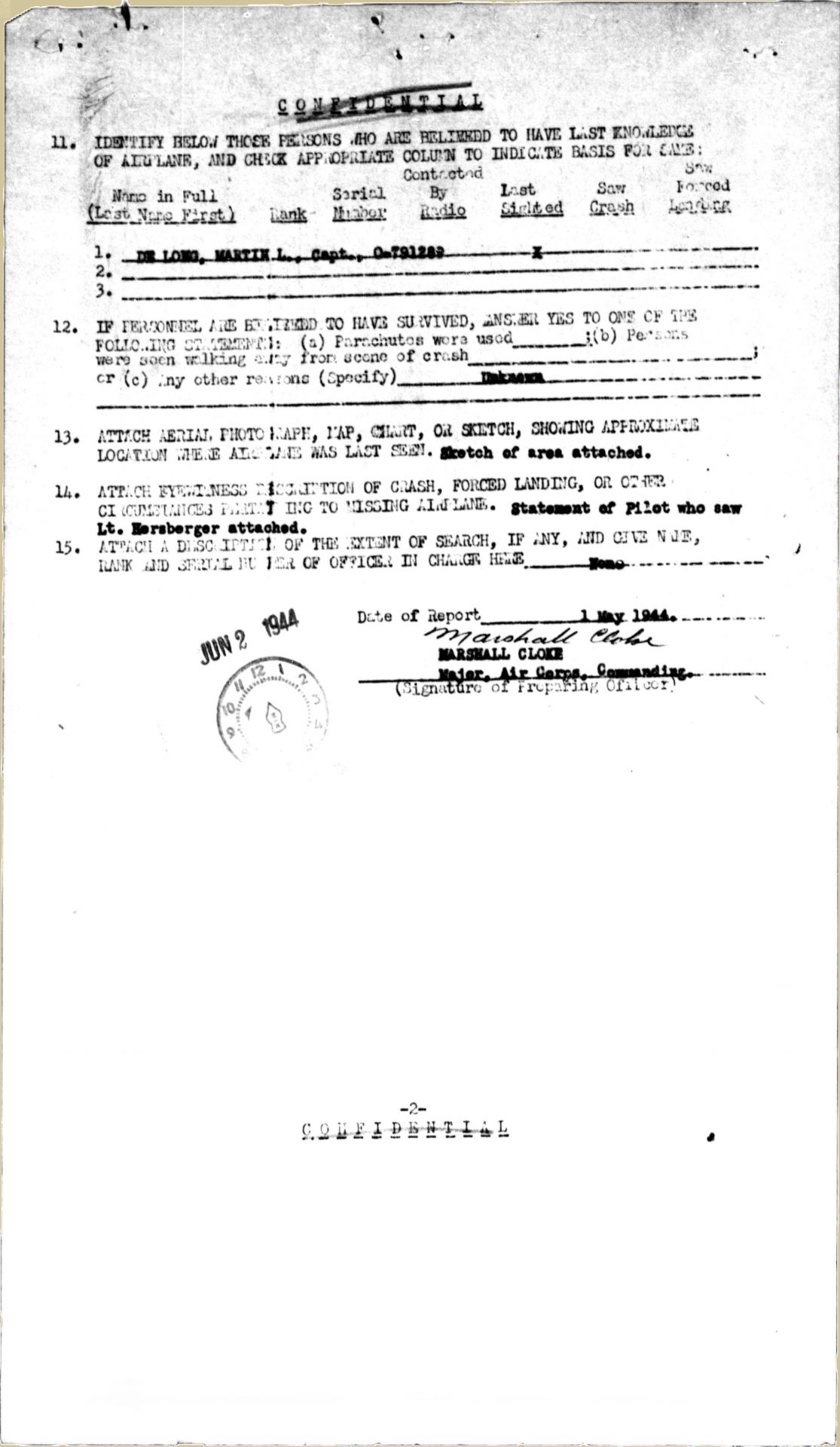

On this page, Captain Martin L. DELONG specifies:
"On April 29, 1944, I was leading Red Flight consisting of Lts Snyder, Ballinger, Tyler and myself on bomber escort mission to Berlin.
We rendezvoused with bombers early, at 10:00 hours, west of Lingen and I positioned Blue Flight led by Lt Owen on the left side of
the second box of bombers. Blue Flight took this position and it was the last time we could positively identify Blue Flight.
However, shortly before reaching the target, we were able to hear over the R/T [radio] that Lt Johnson,
Blue #4 was having engine trouble. Lt. Owen was heard to say that "I'll be with you in a minute." Lt. Johnson was
heard again later reporting to Lt Owen that he still had engine trouble. I heard nothing further."
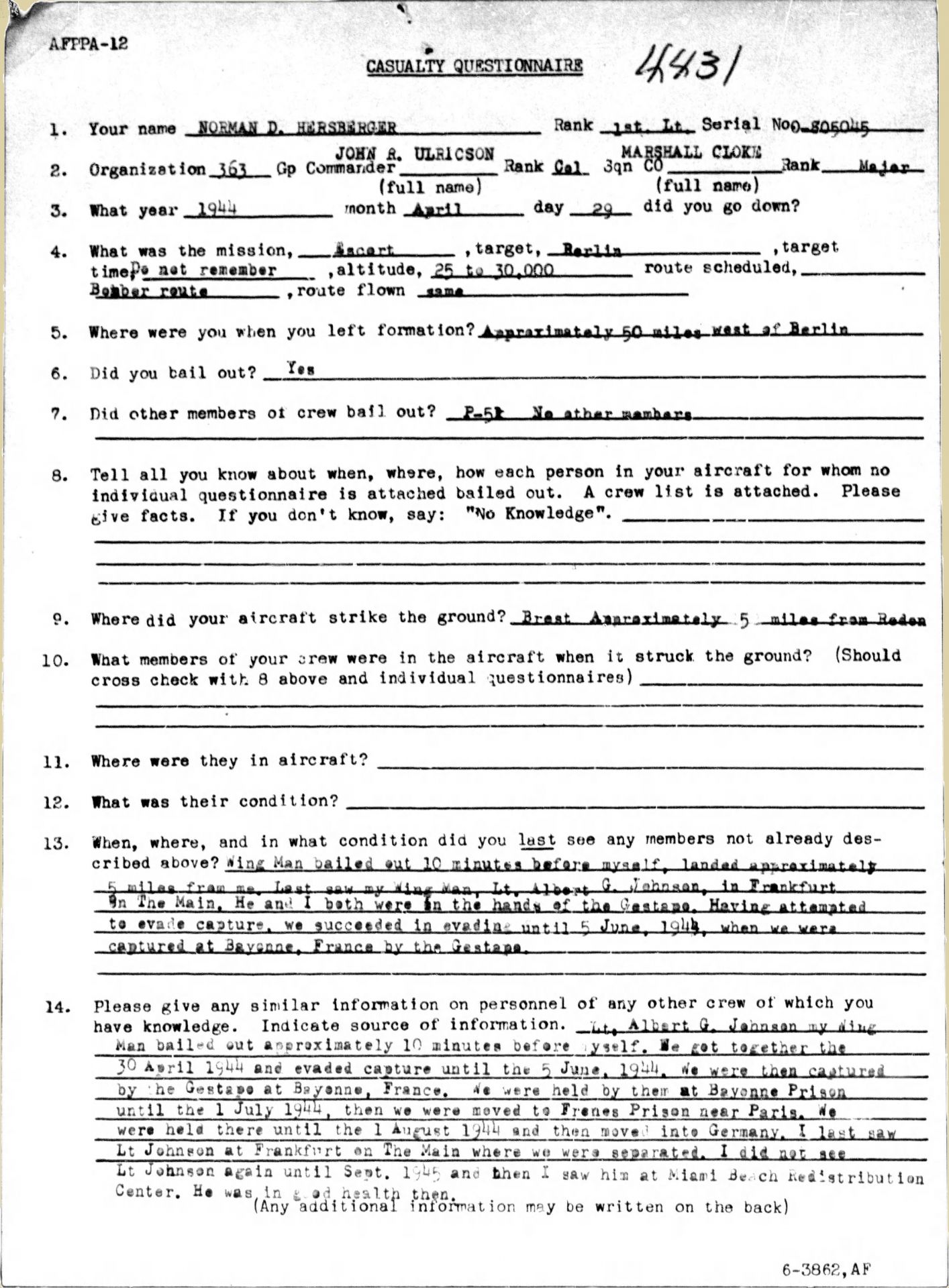
On this page, HERSBERGER recounts the circumstances of his fall in Brittany.
He states that his aircraft near Brest, about 5 miles from Redon. He says that his Wing Man, Albert G. Johnson, bailed out
10 minutes before him and that he had landed about 5 miles away from him. They were both in the hands of the Gestapo.
They attempted to evade capture until June 5, 1944, when they were captured in Bayonne.
They were taken to Bayonne prison until the July 1st, then they were sent to Fresnes prison, near Paris.
They stayed there until the August 1st, 1944 and then moved into Germany.
He saw Johnson for the last time in Frankfurt am Main, where they were separated. He did not see Johnson again until September 1945.
at the Miami Beach Redistribution Center. He was in good health then.
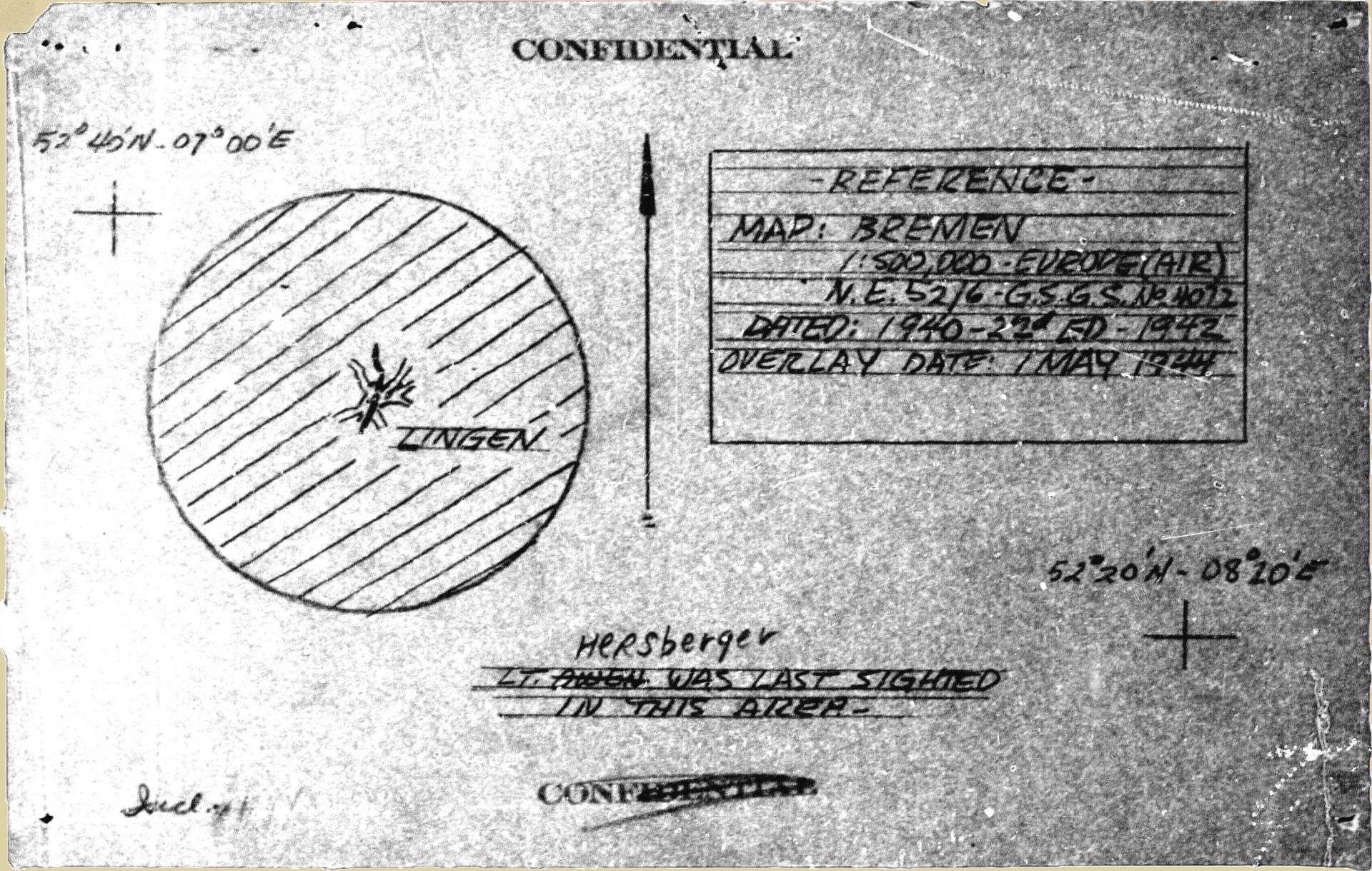
In this document it is stated that Lt HERSBERGER was last sighted in a circular area around the German city
from Lingen, very far from Allaire where he crashed.
In the rest of the MACR, HERSBERGER's "dog tag" is mentioned, as well as information relating to the 2 other P-51
Mustangs which fell on April 29, 1944 near Saint-Jean d'Angely, in Charente-Maritime (at the time Charente-Inférieure).
We know that the Germans thought that Hersberger (and Johnson) were the pilots of these two other Mustangs. These two other
Mustangs were s/n 43-6804 piloted by 1st Lt Arthur W. Jr. Owen (mentioned in the MACR) and 43-6852
piloted by F/O Daniel G. DIYA, both from the same unit as HERSBERGER and JOHNSON.
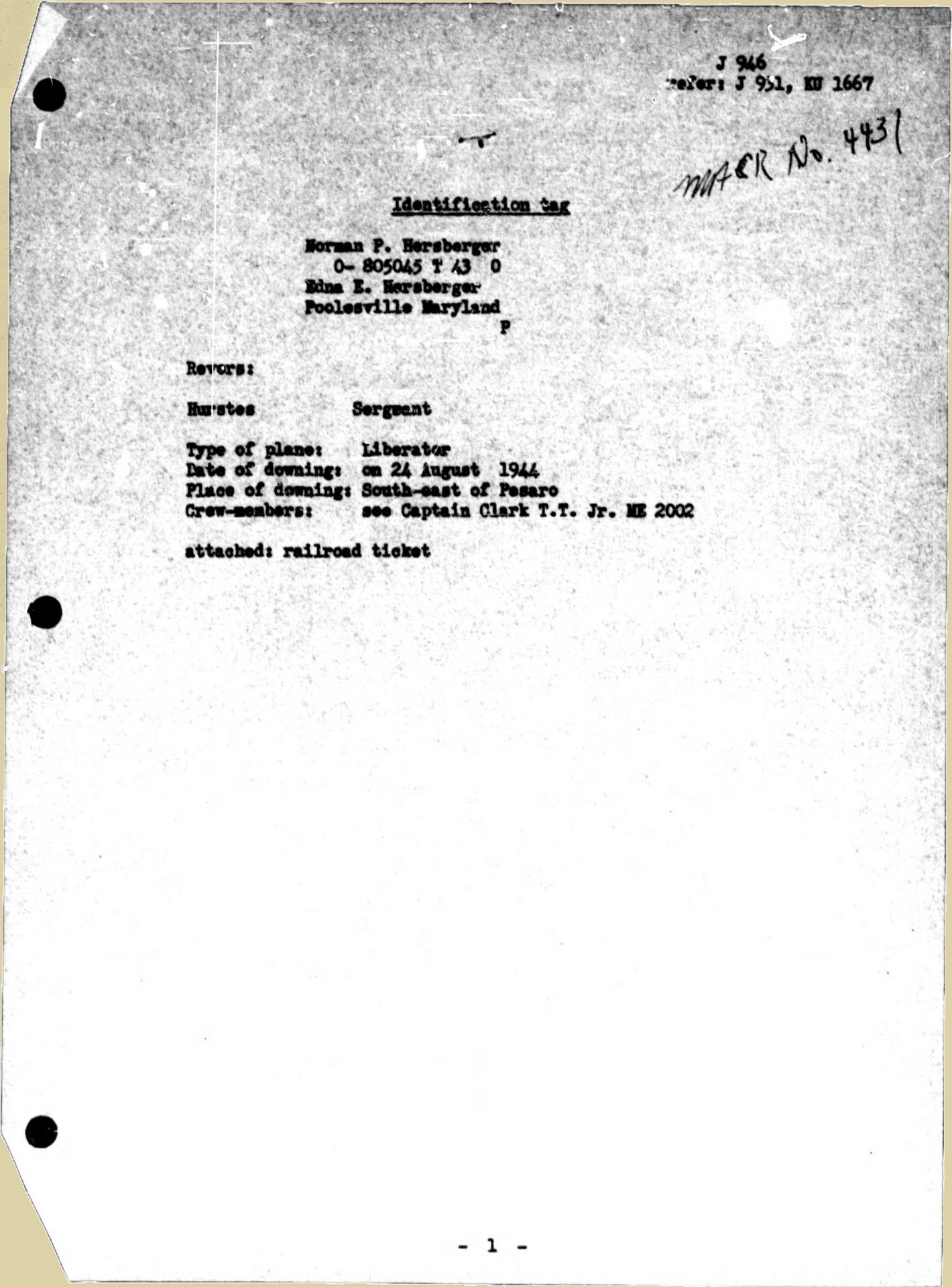
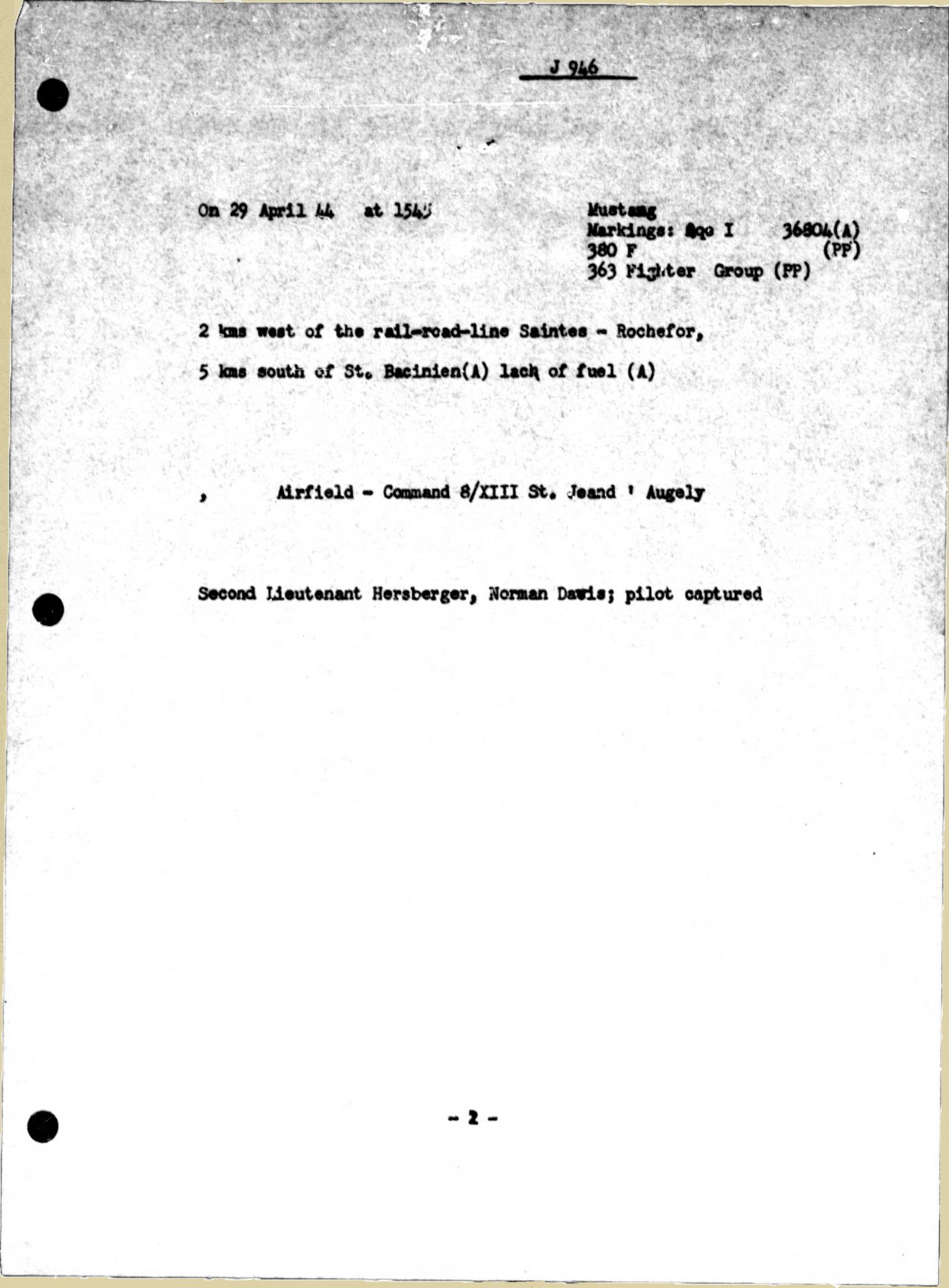
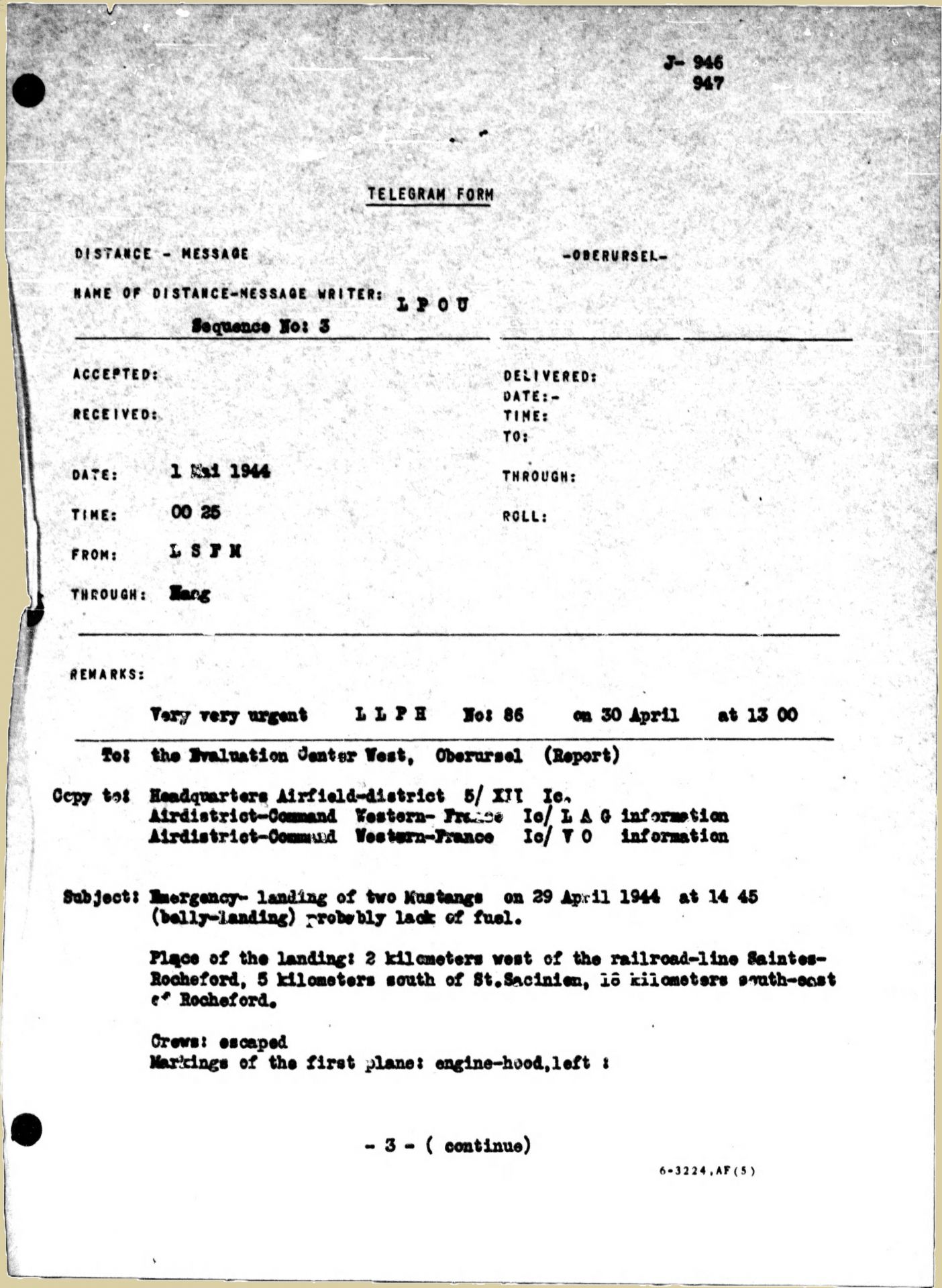
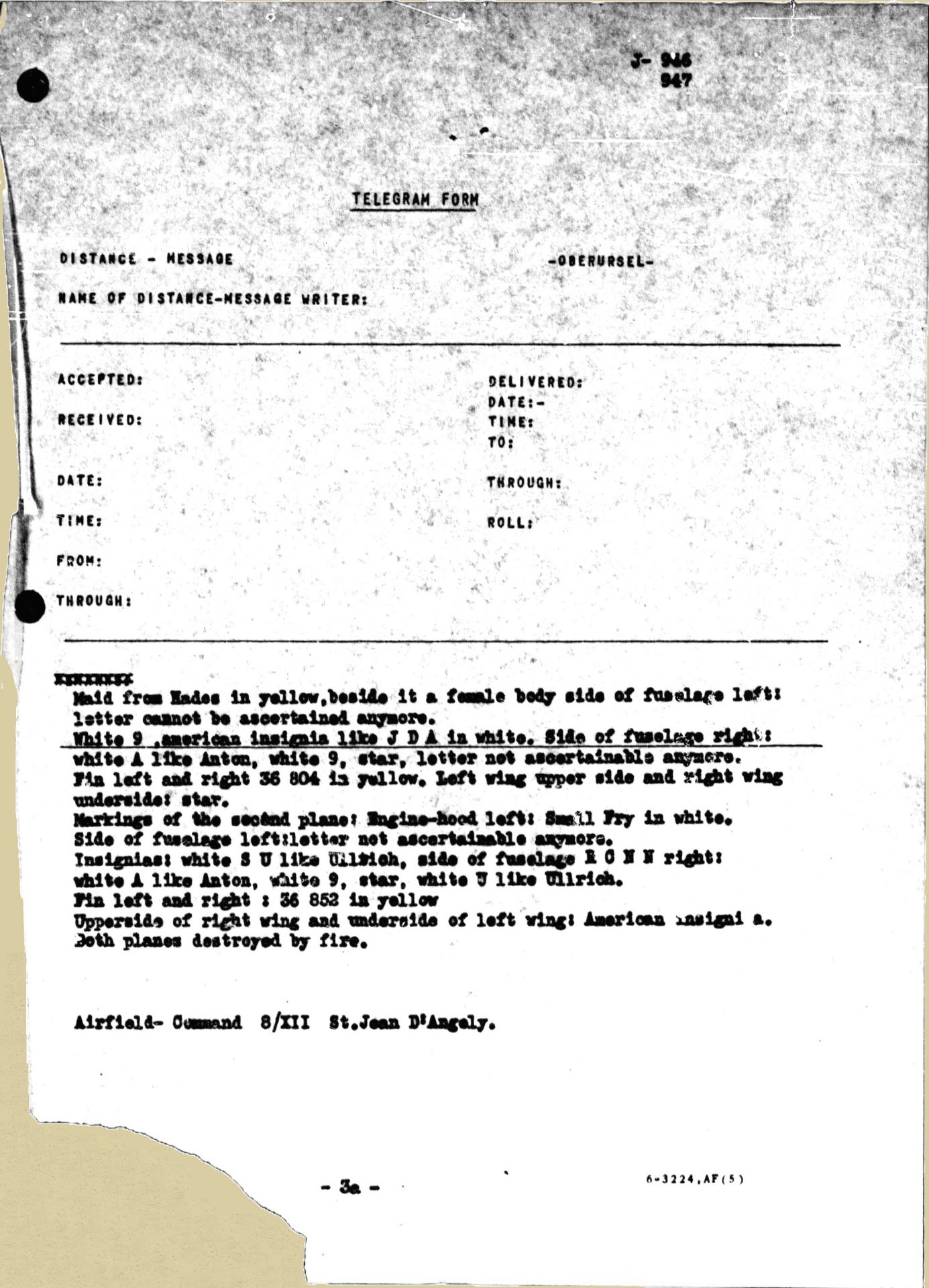
• Missing Air Crew report # 4435 concerning Albert George JOHNSON.
(source : US National Archives)
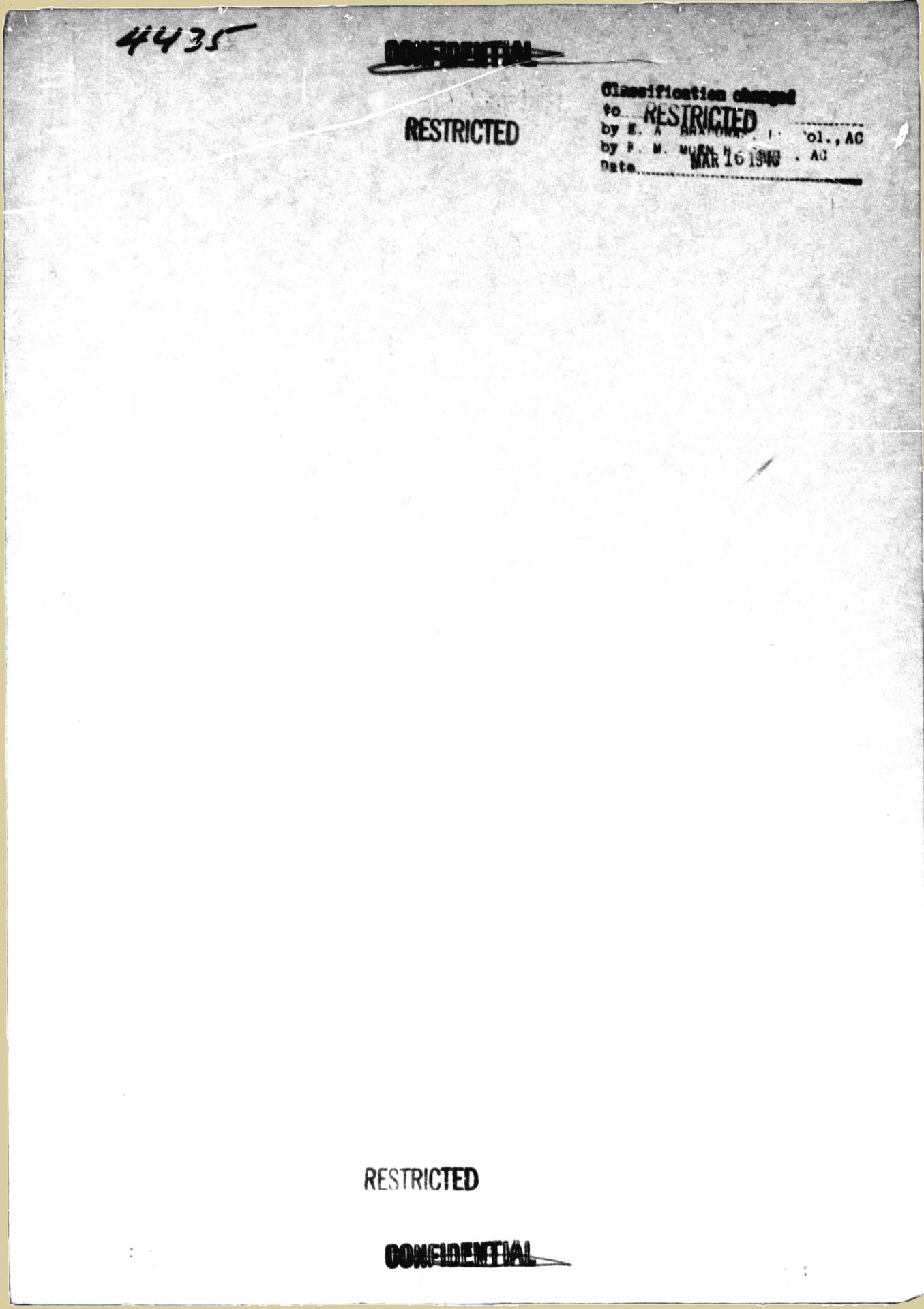
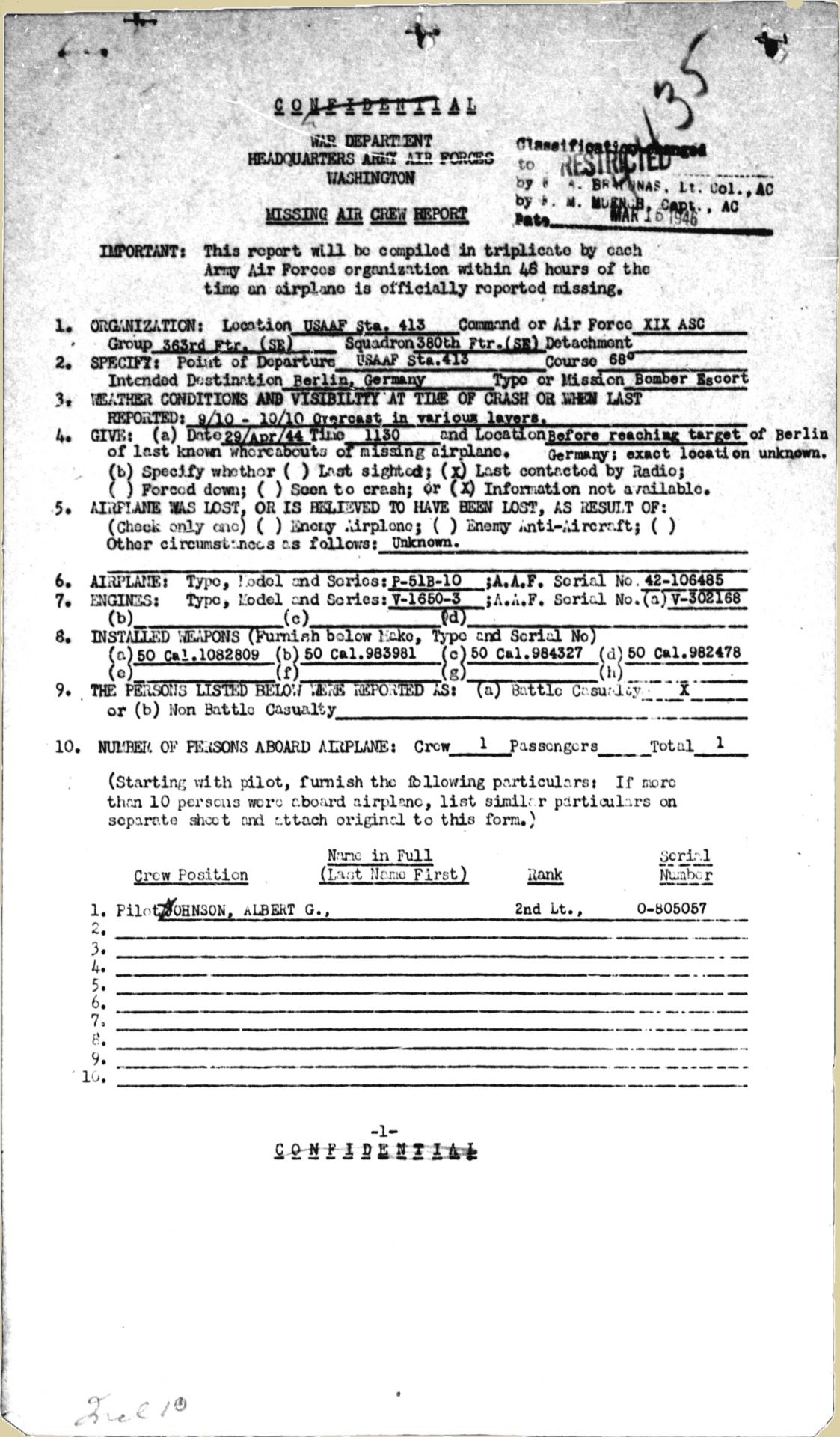
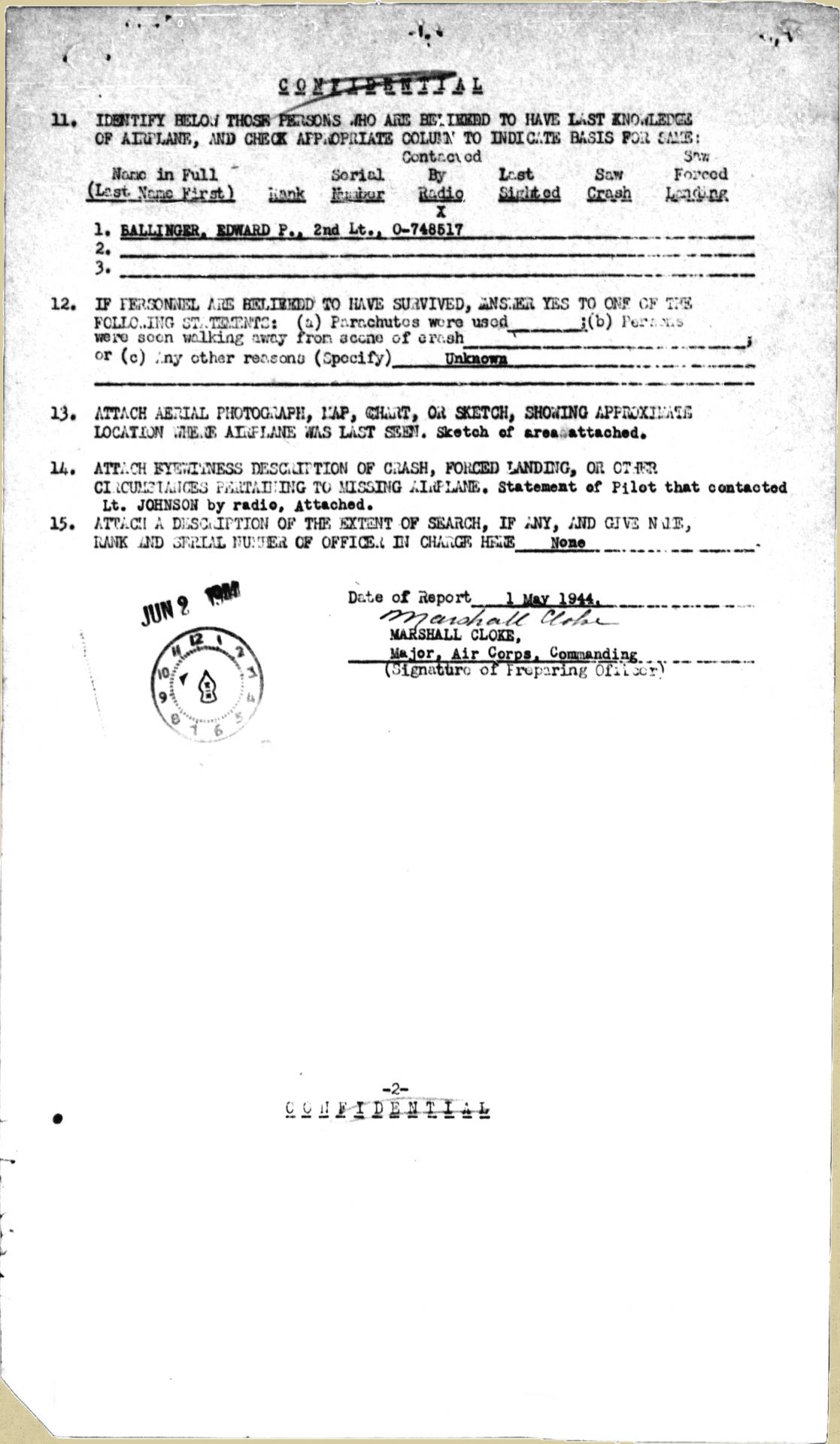
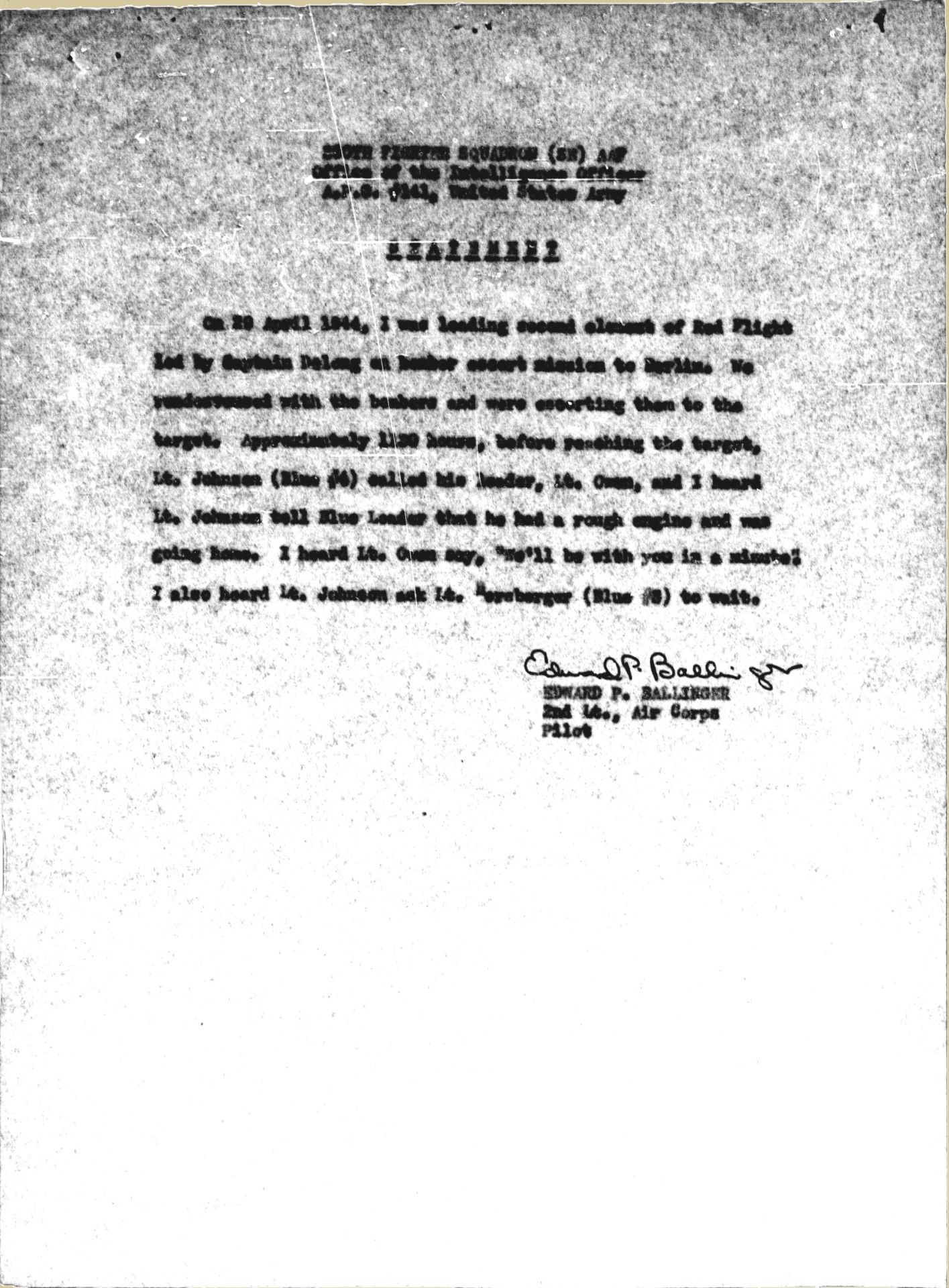
In this page, the 2nd Lt Edward P. BALLINGER states :
" On 29 April 1944, I was leading second element of Red Flight led by Captain Delong at bomber escort mission to Berlin.
We rendezvoused with the bombers and were escorting them to the target. Approximatively 11:30 hours, before reaching the target,
Lt Johnson (Blue #4) called his leader, Lt Owen, and I heard Lt Johnson tell Blue Leader that he had a rough engine and was going home.
I heard Lt Owen say "we'll be with you in a minute". I also heard Lt Johnson ask Lt Hersberger (Blue #8) to wait".
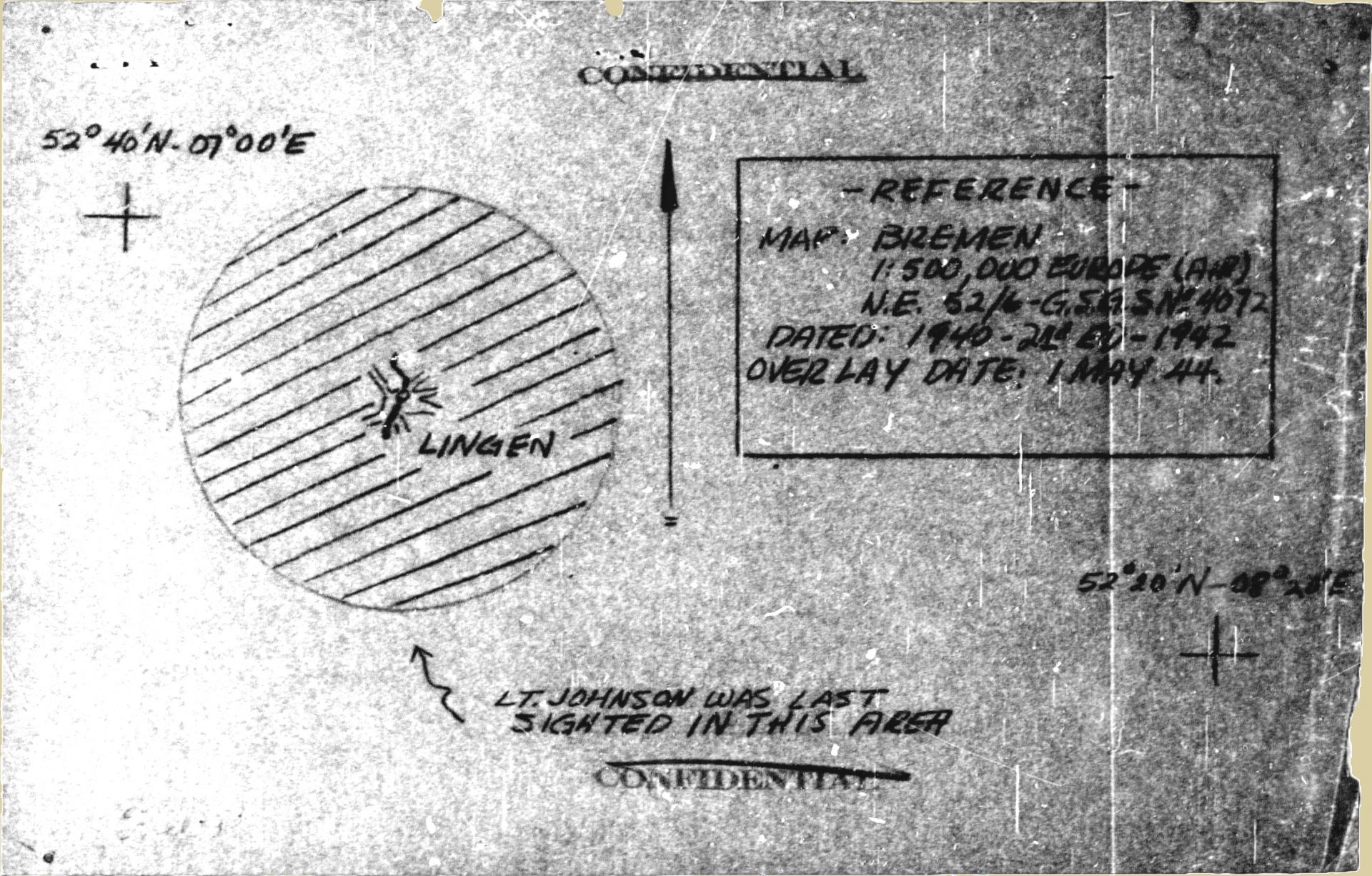
In this document, it is stated that Lt JOHNSON was last sighted in a circular area around the German town of Lingen,
like HERSBERGER, very far from Allaire where he crashed.
• Albert JOHNSON's prisoner file. This file consists of letters and telegrams sent by Red Cross correspondents.
(source: Archives of the International Committee of the Red Cross)
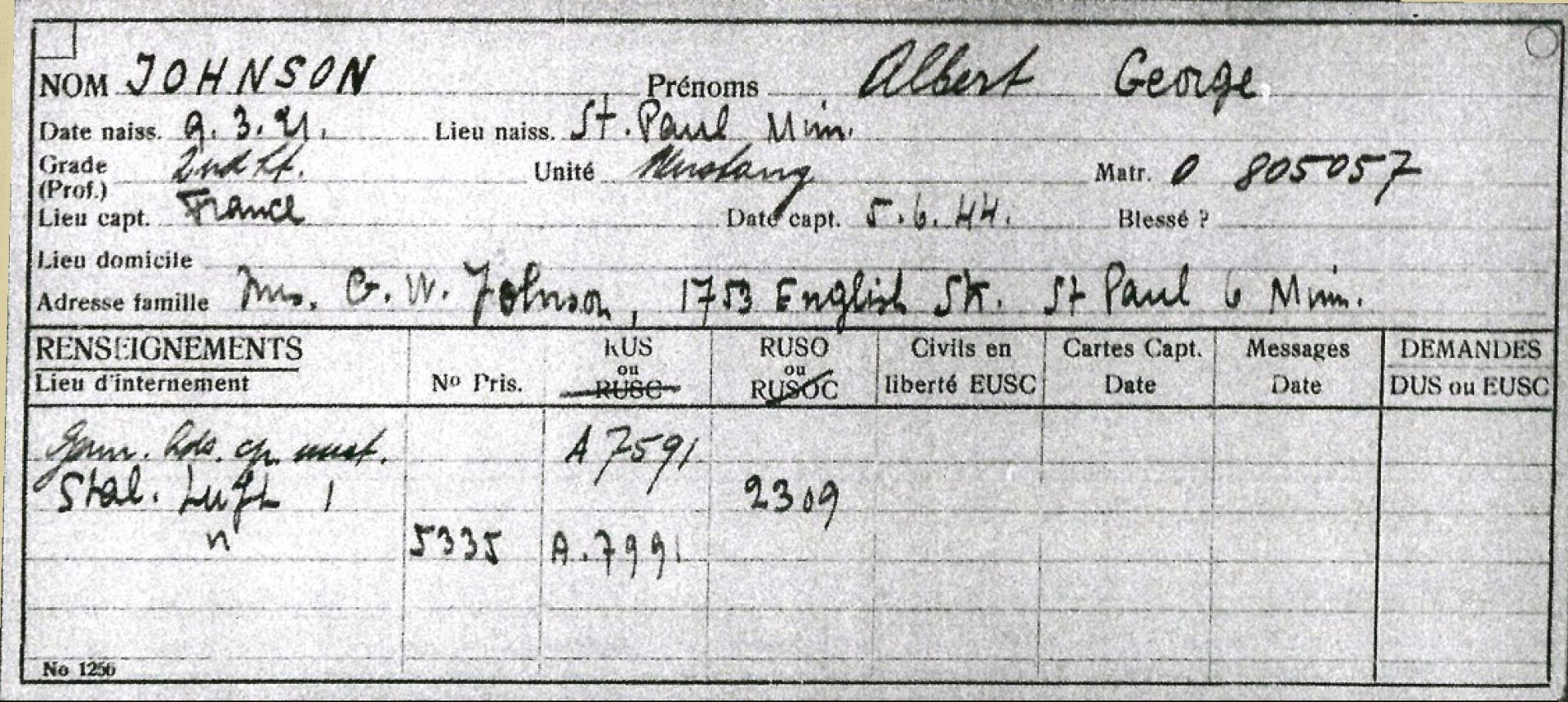
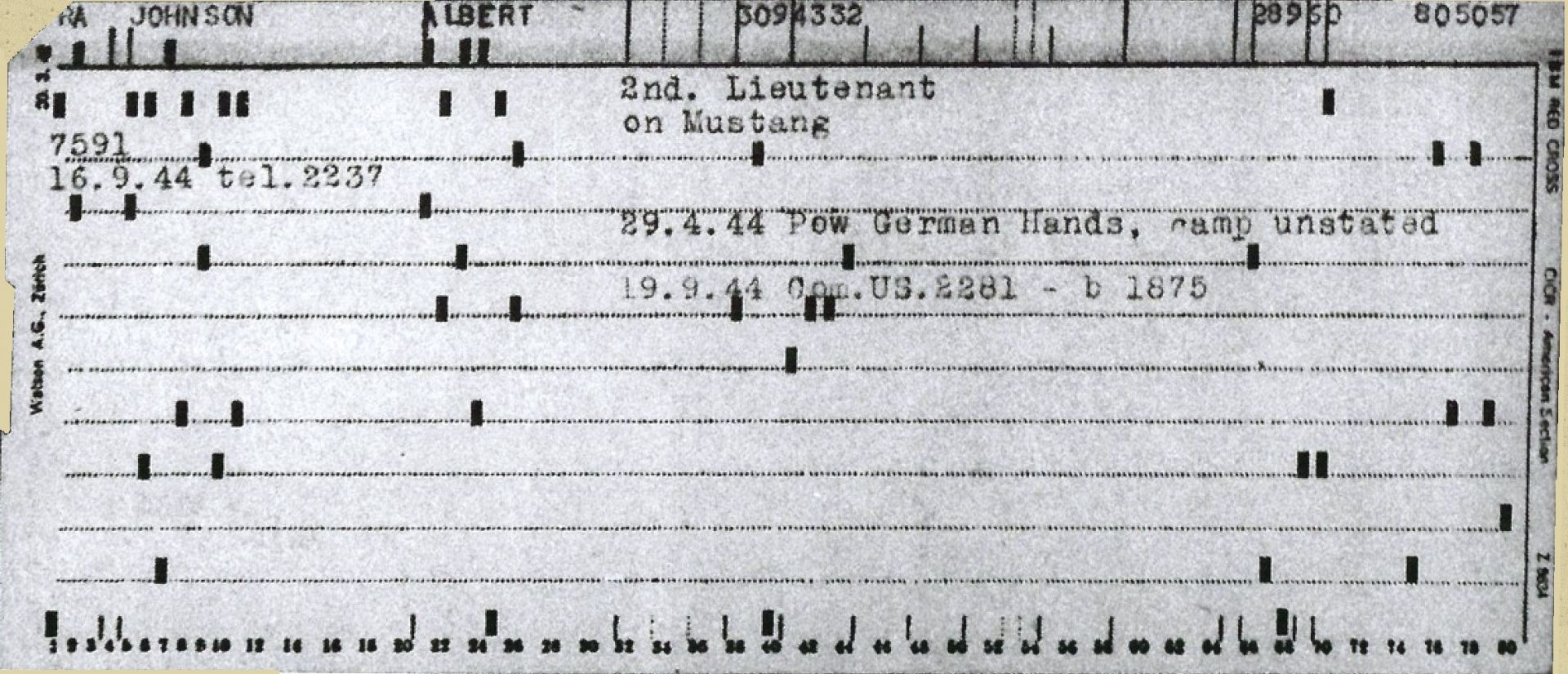
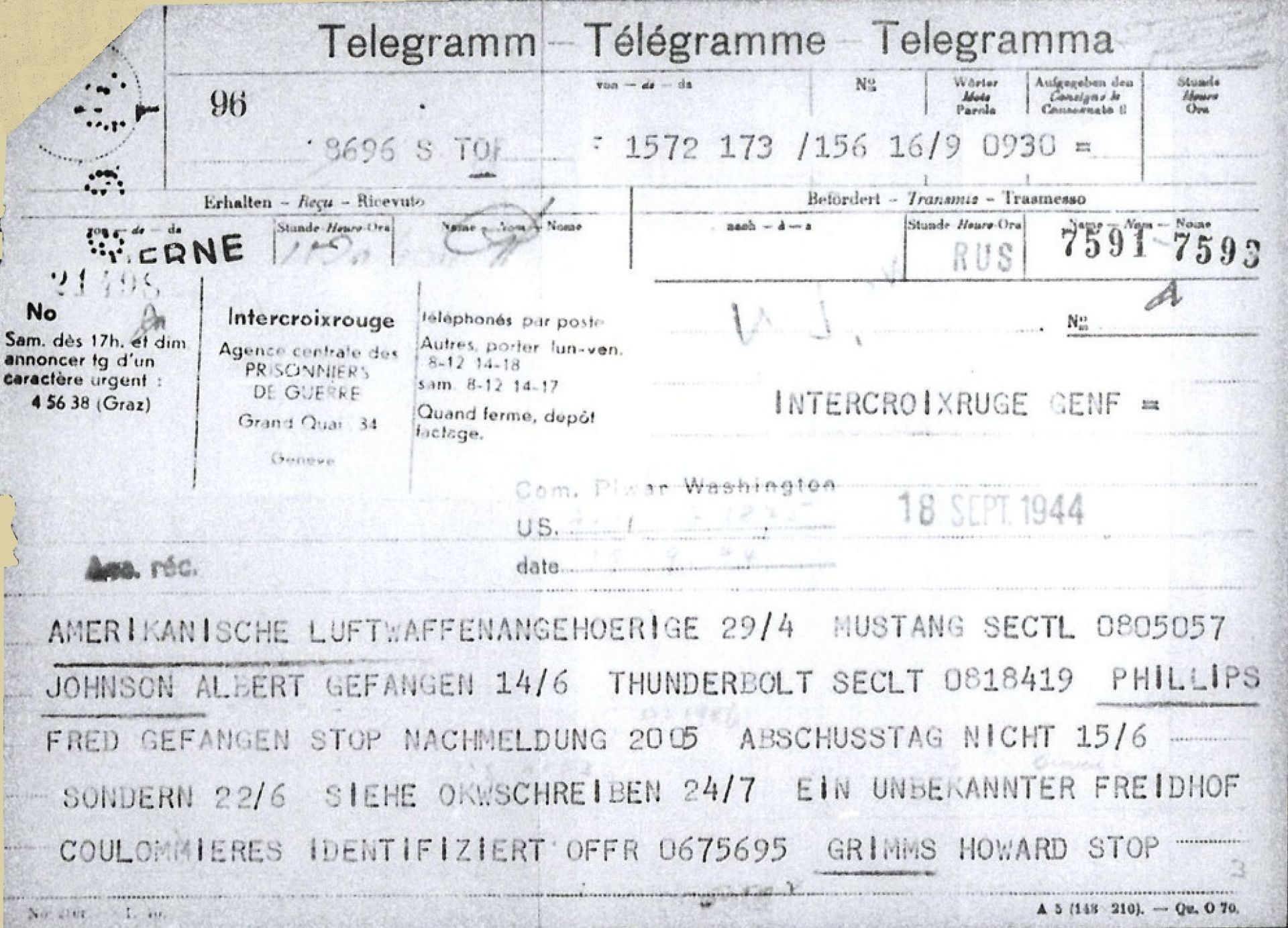
This telegram specifies :
"Members of the United States Air Force 4/29 Mustang - service number 0805057 Johnson Albert Captured
6/14 Thunderbolt service number 0818419 Philipps Fred Captured - STOP
Late report 2005 Date of the shooting not 6/15 but 6/22
See OKW letter 7/24 an unknown cemetery Coulommieres identified Offr 0675695 Grimms Howard - STOP"
This document therefore mentions Johnson's capture and recalls the date of his fall, 4/29

This document indicates that Johnson was interned on September 9, 1944, at Stalag Luft I, which is confirmed by the list of prisoners
who arrived at Stalag Luft I on September 9, 1944, a list that includes Johnson.
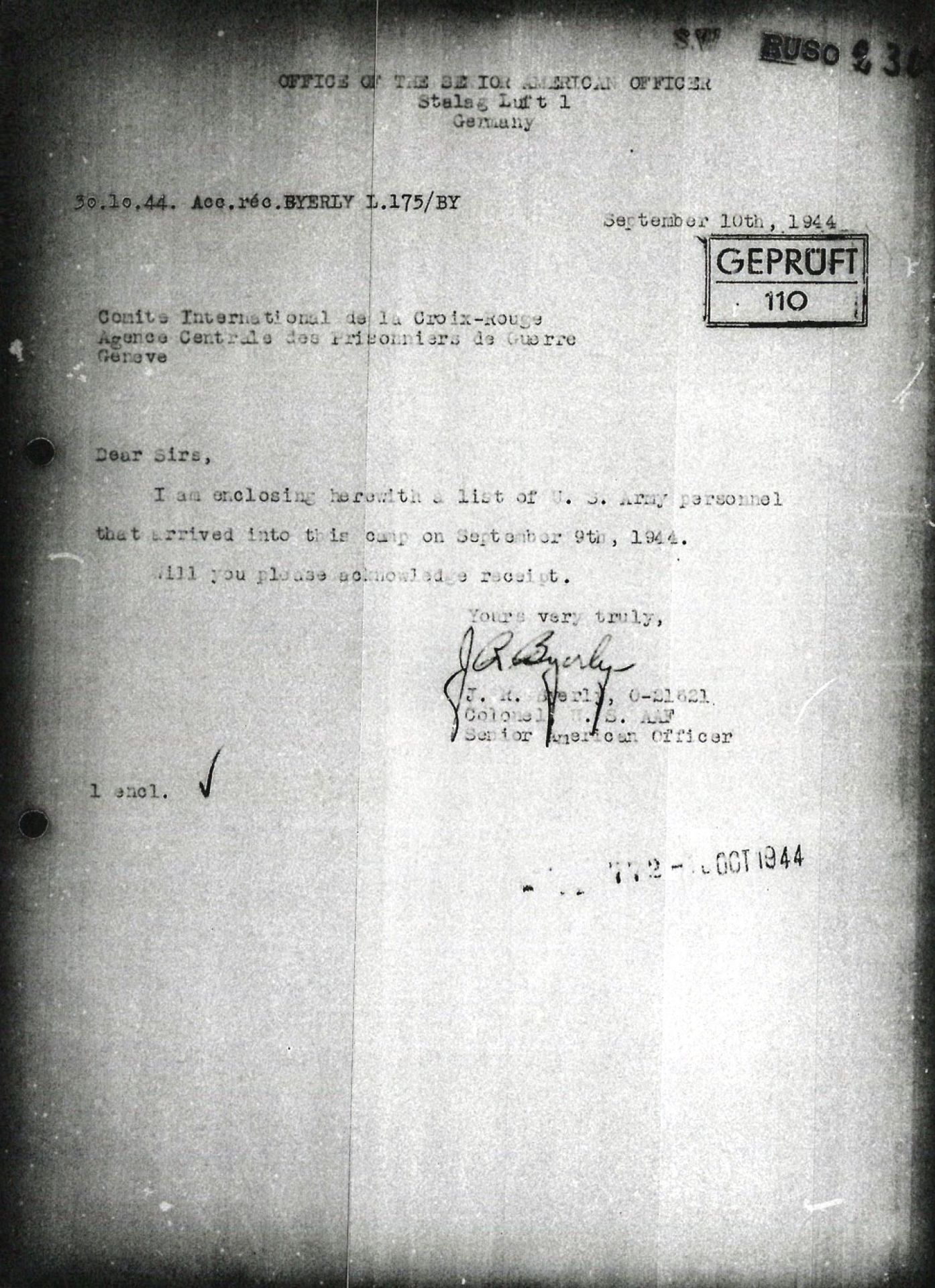
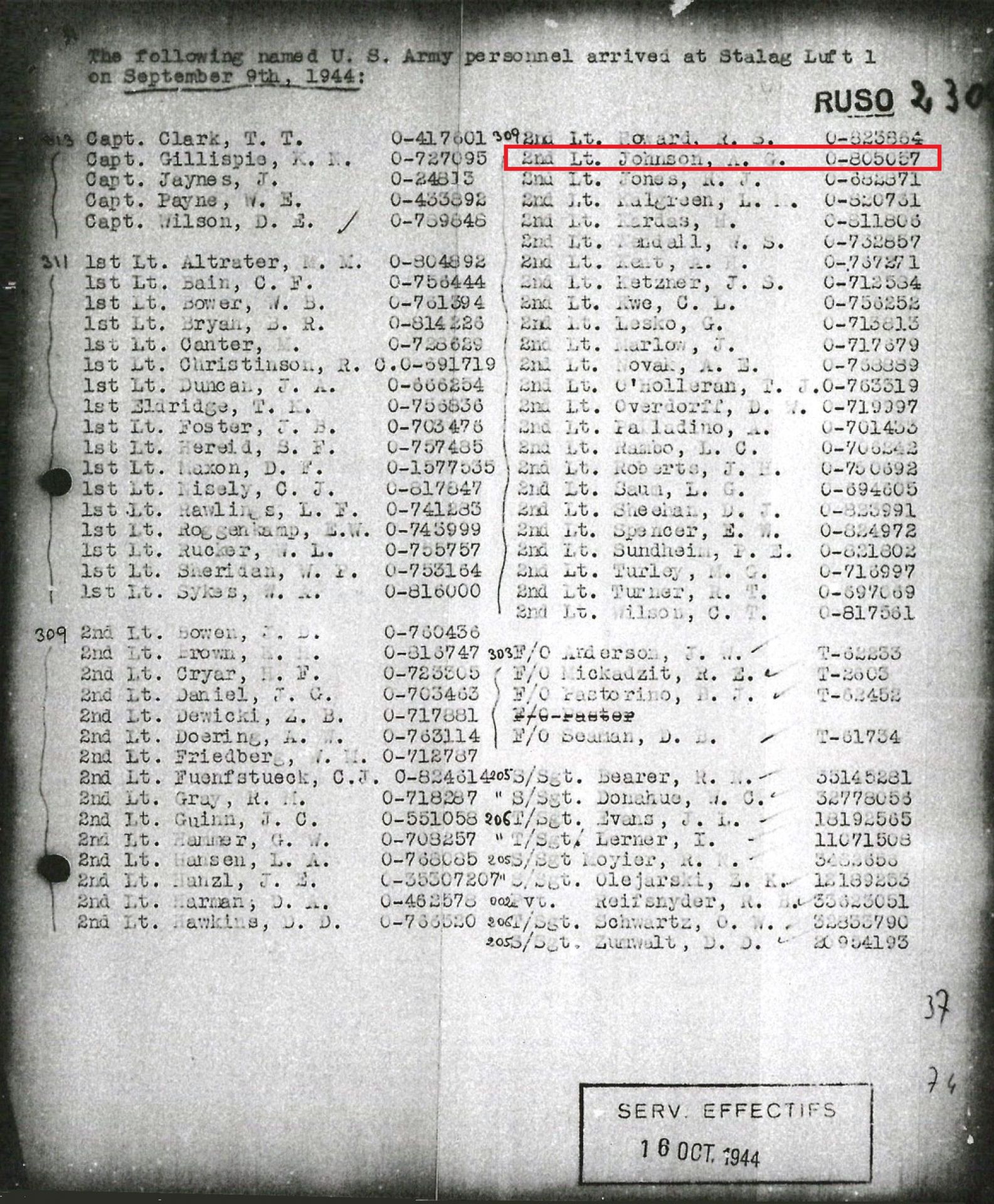
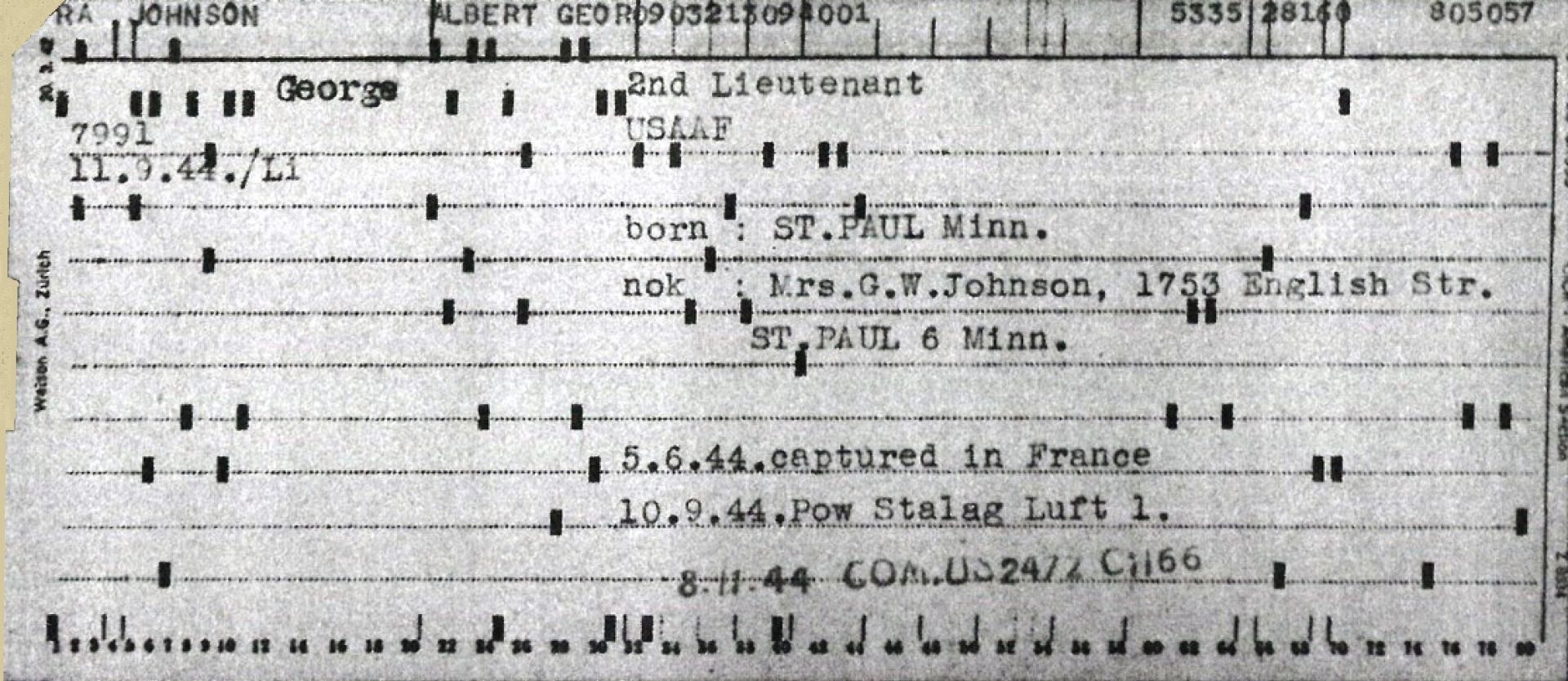
This document confirms the date of capture, June 5, 1944.
It specifies September 10 at Stalag Luft I, which could be the date of registration since Johnson arrived on September 9.
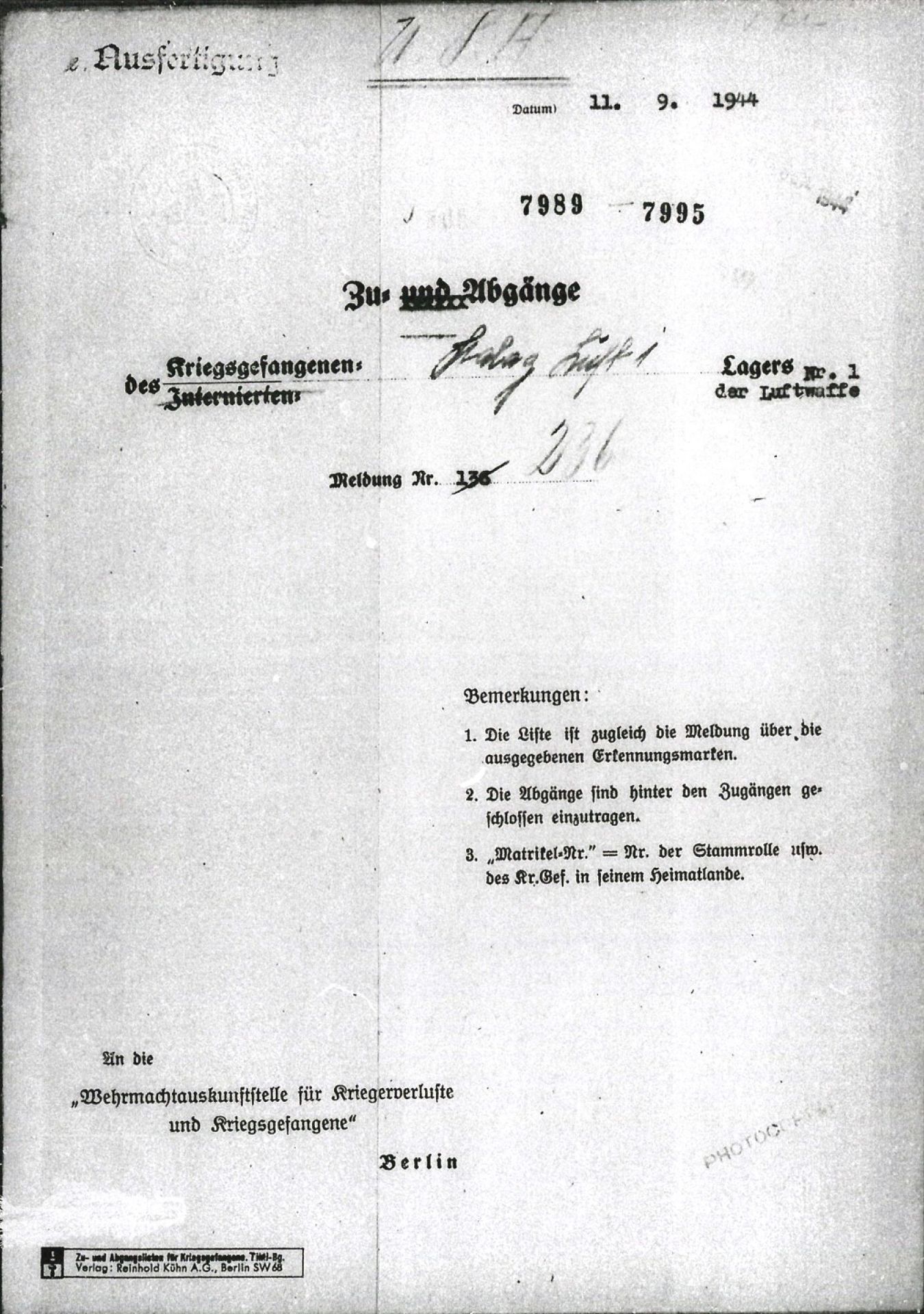
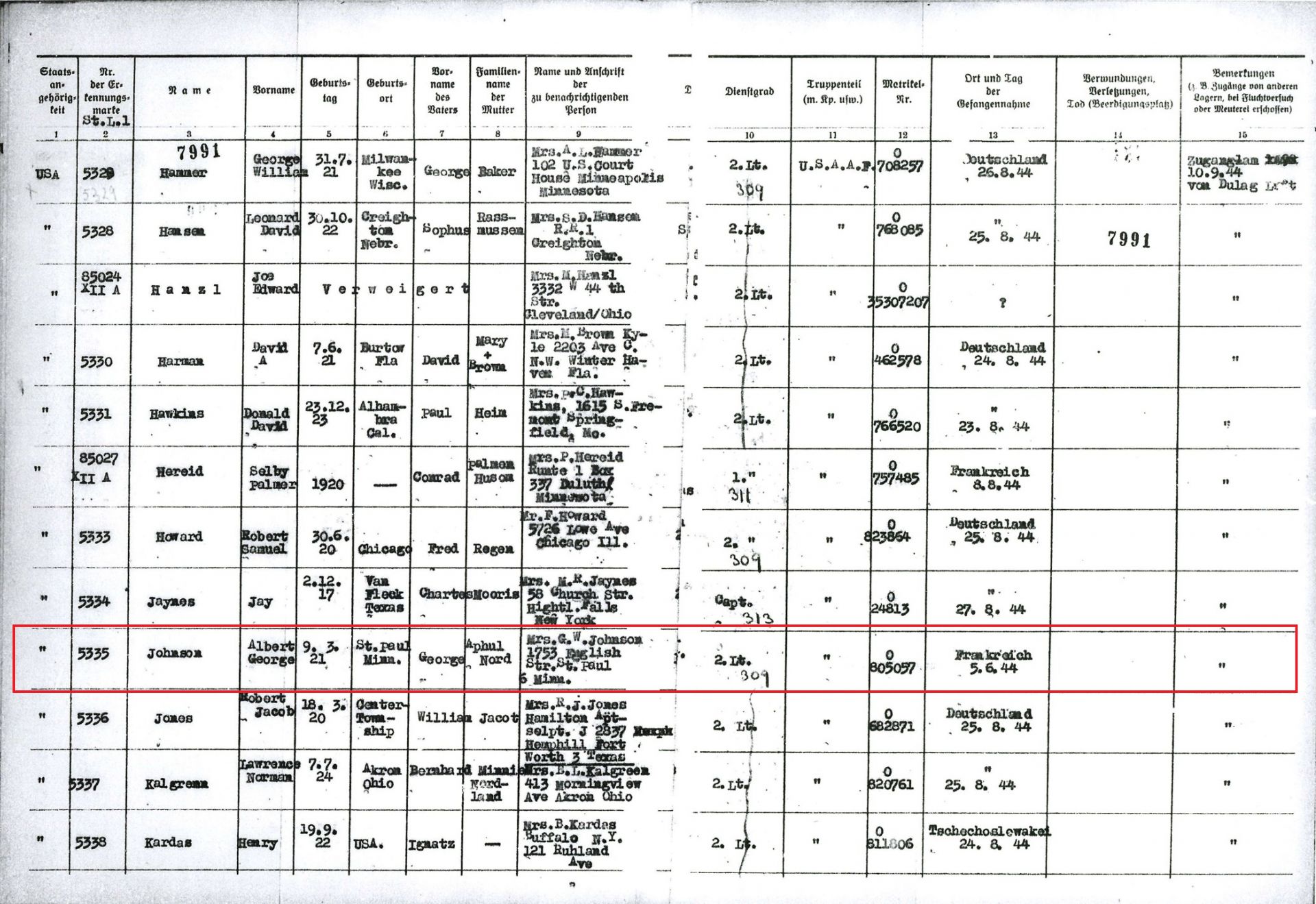
This German document informs us that Johnson had the identification number 5335 at Stalag Luft I.
• Norman Davis HERSBERGER's prisoner file. This file consists of letters and telegrams sent by Red Cross correspondents.
(source: Archives of the International Committee of the Red Cross)
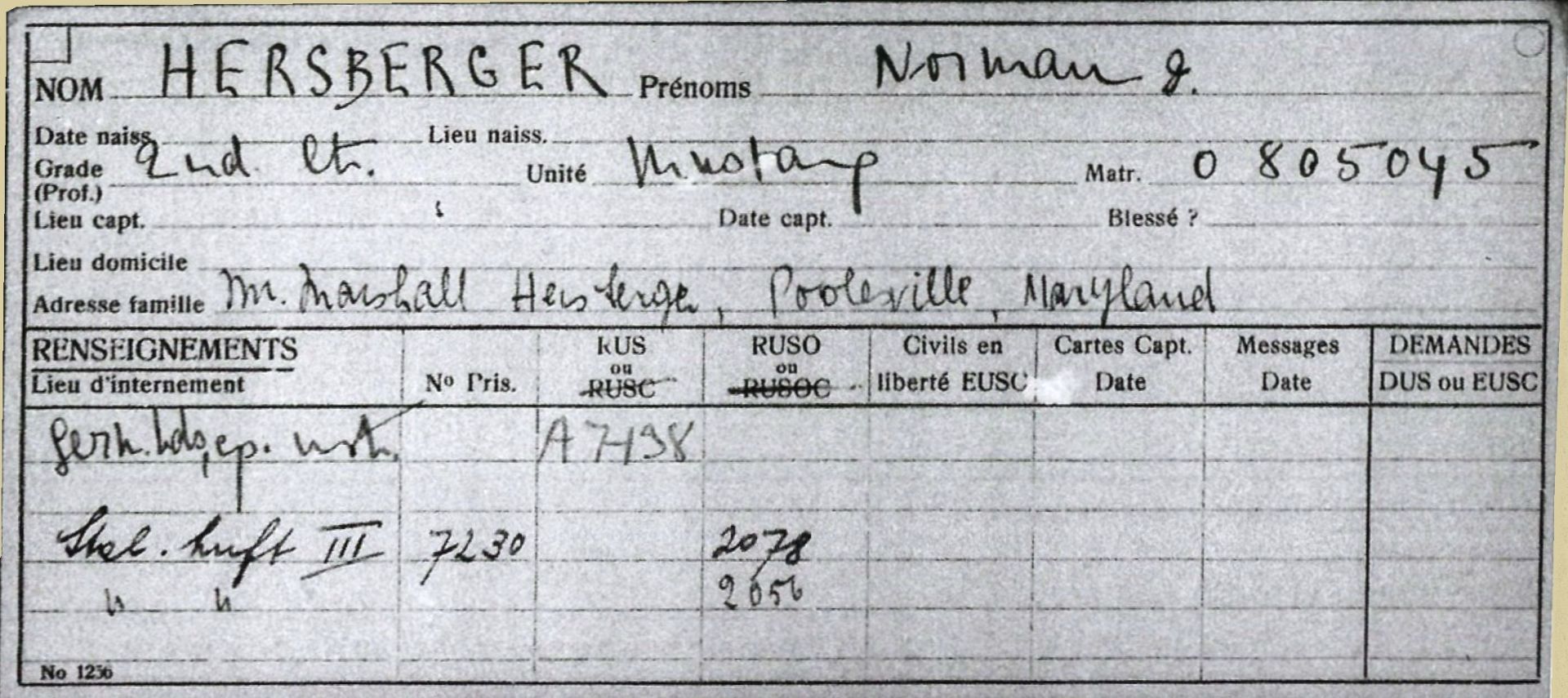
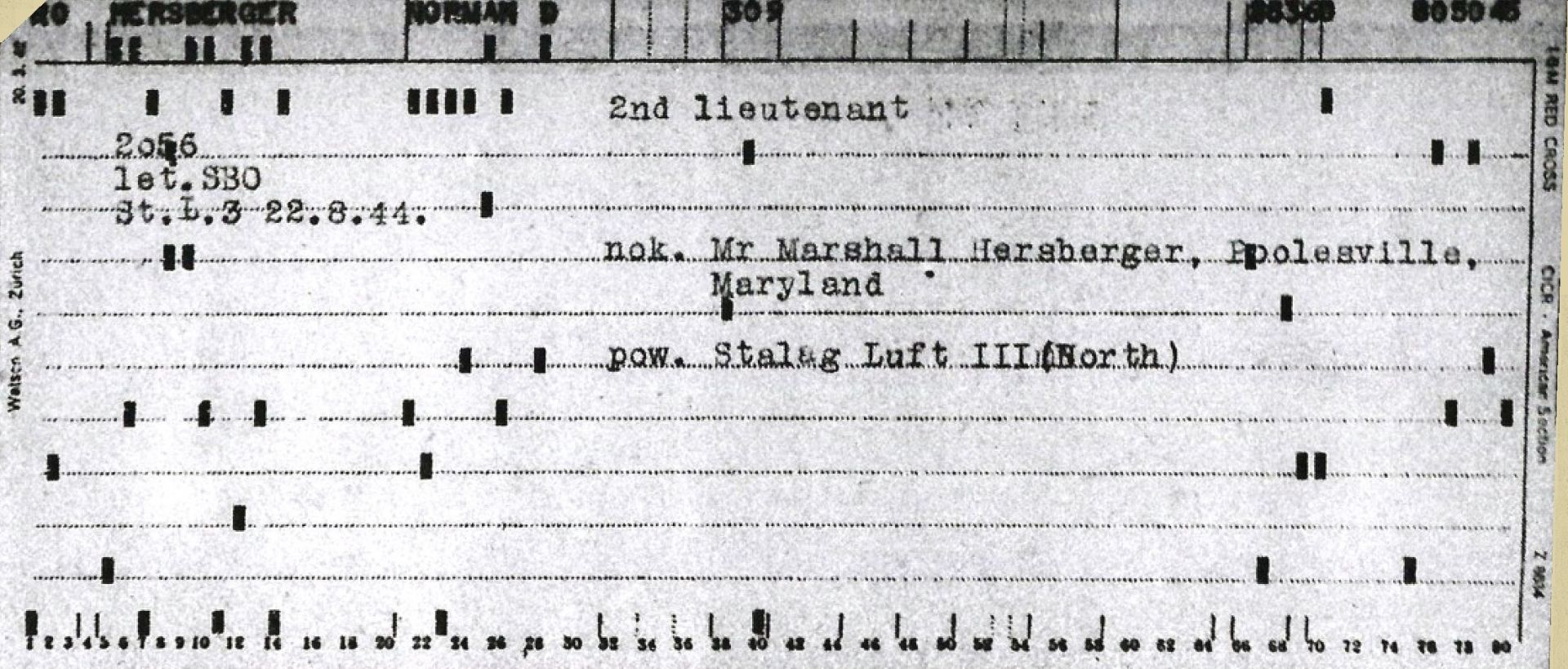
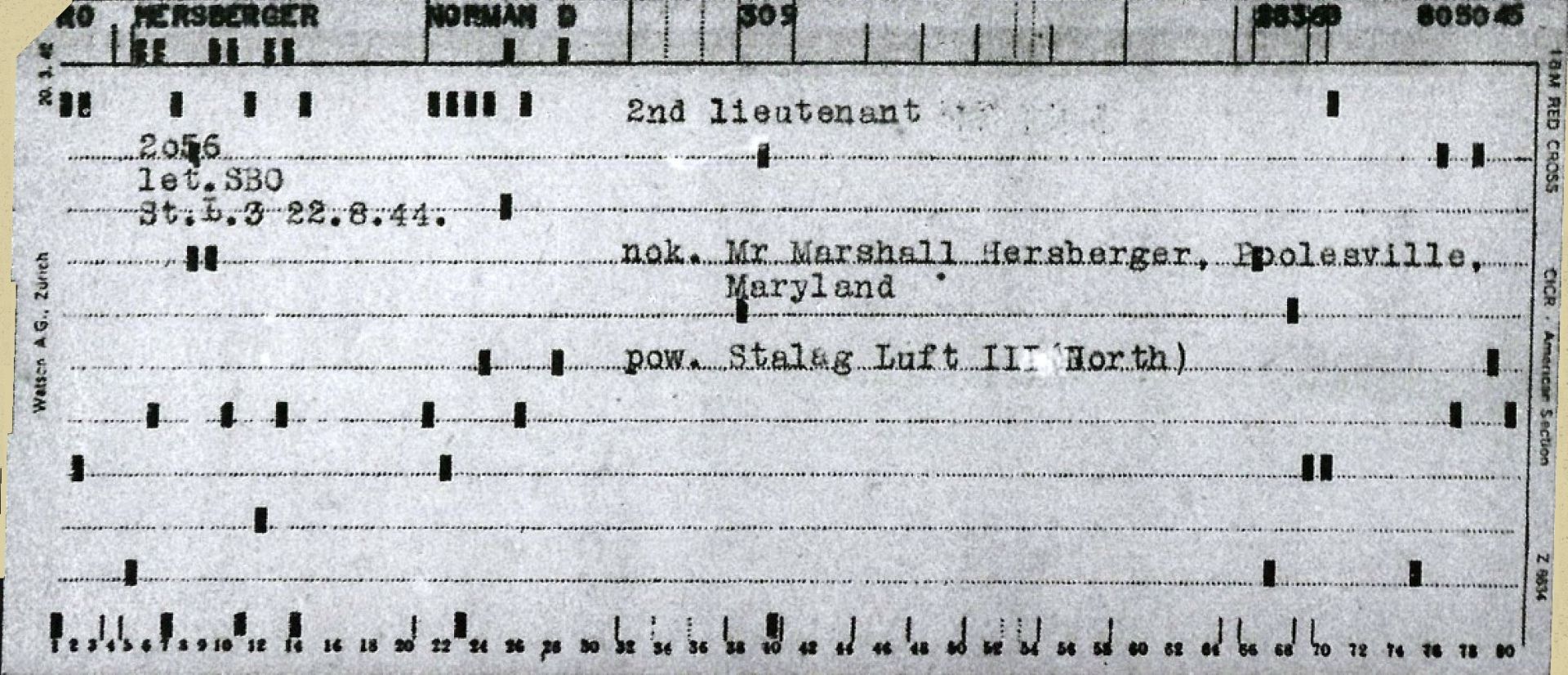
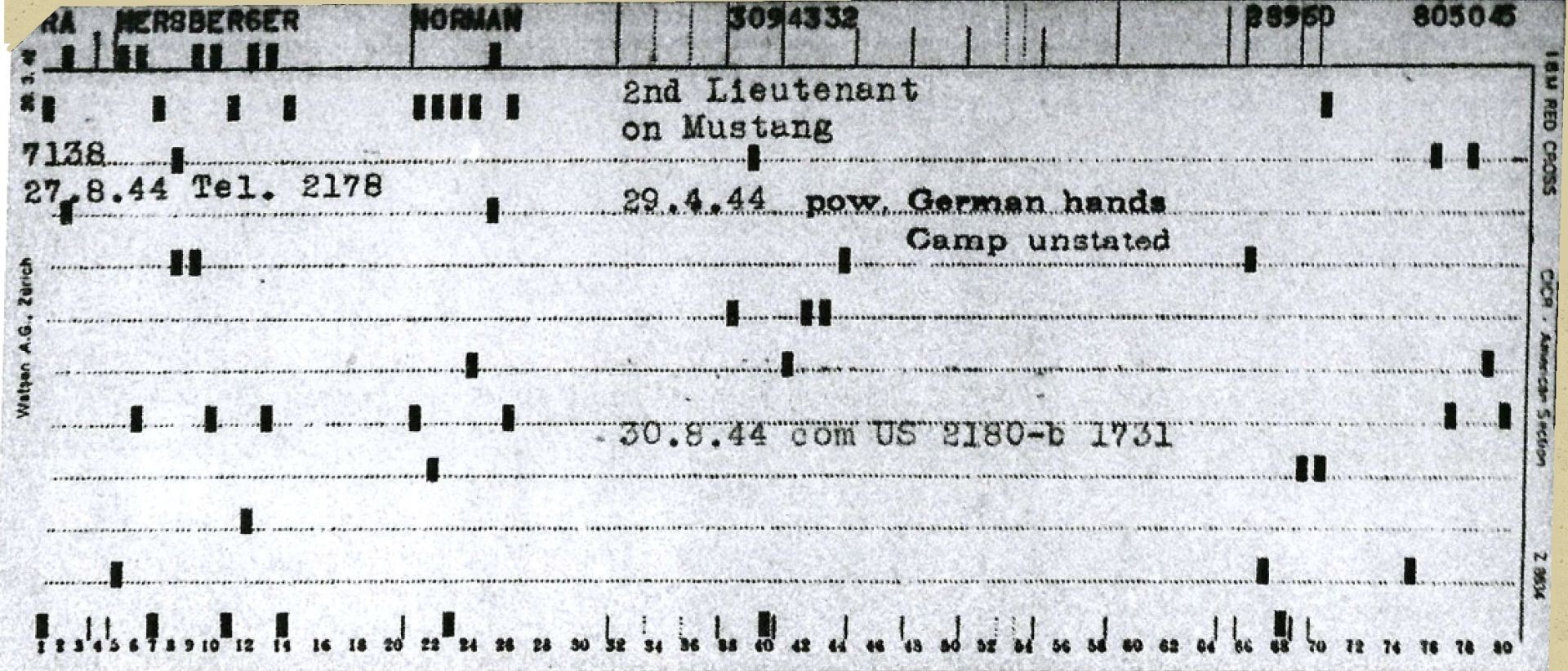
A series of telegrams sent to Marshall Hersberger, Norman's father, indicating that Norman Hersberger
was imprisoned at Stalag Luft III North, under the number 7230. He had passed through an intermediate camp under the number 7138.
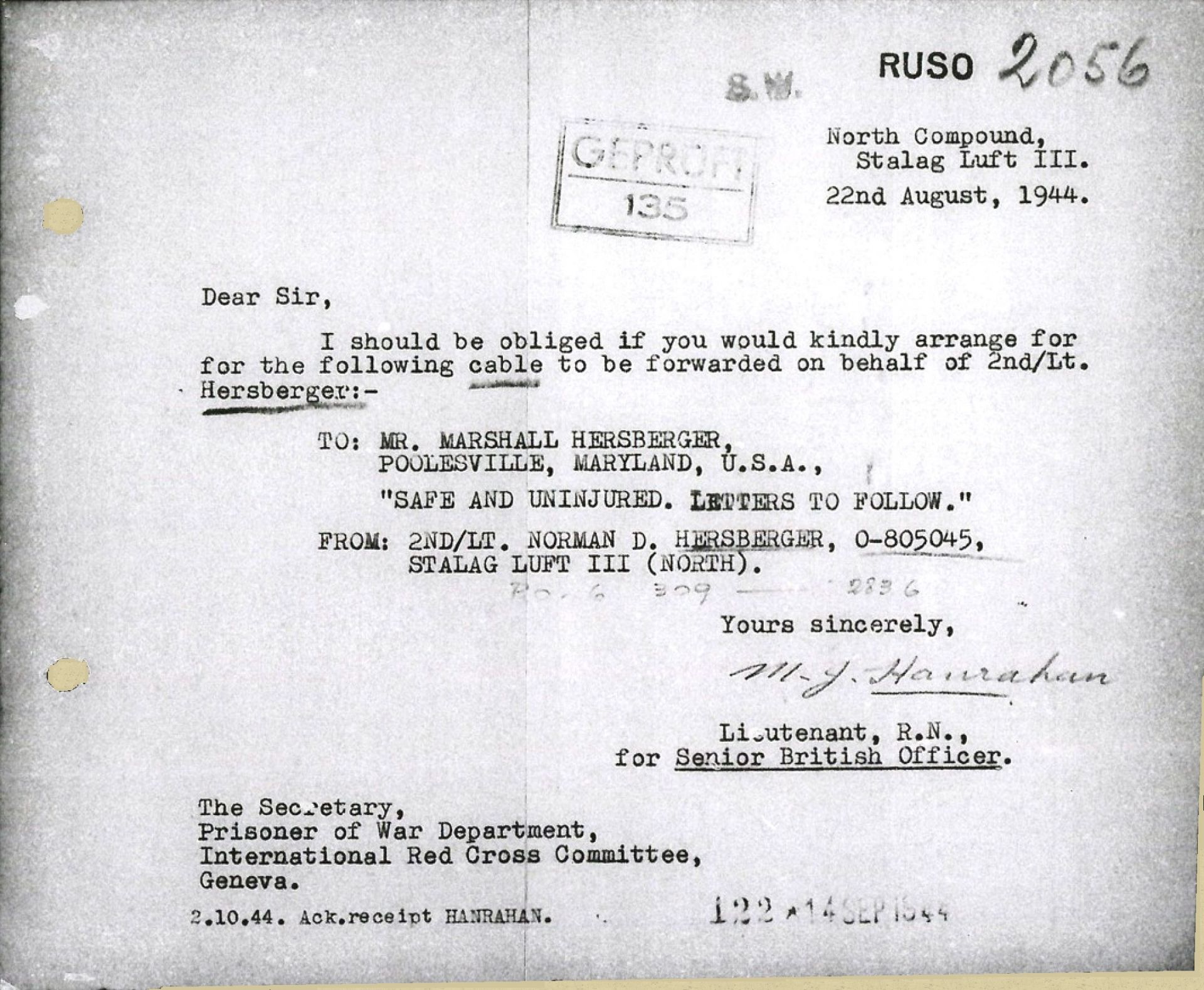
In this letter from the Red Cross, we learn that Hersberger was "safe and uninjured".
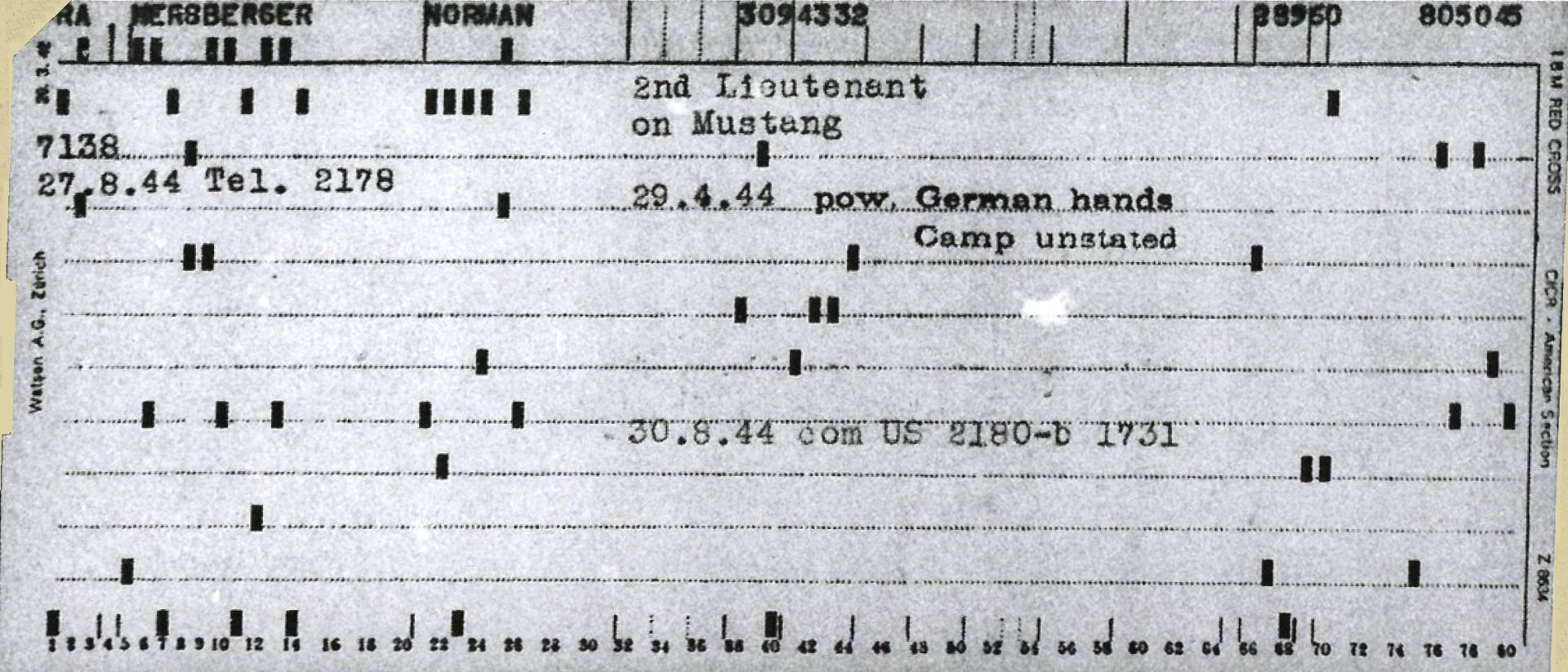
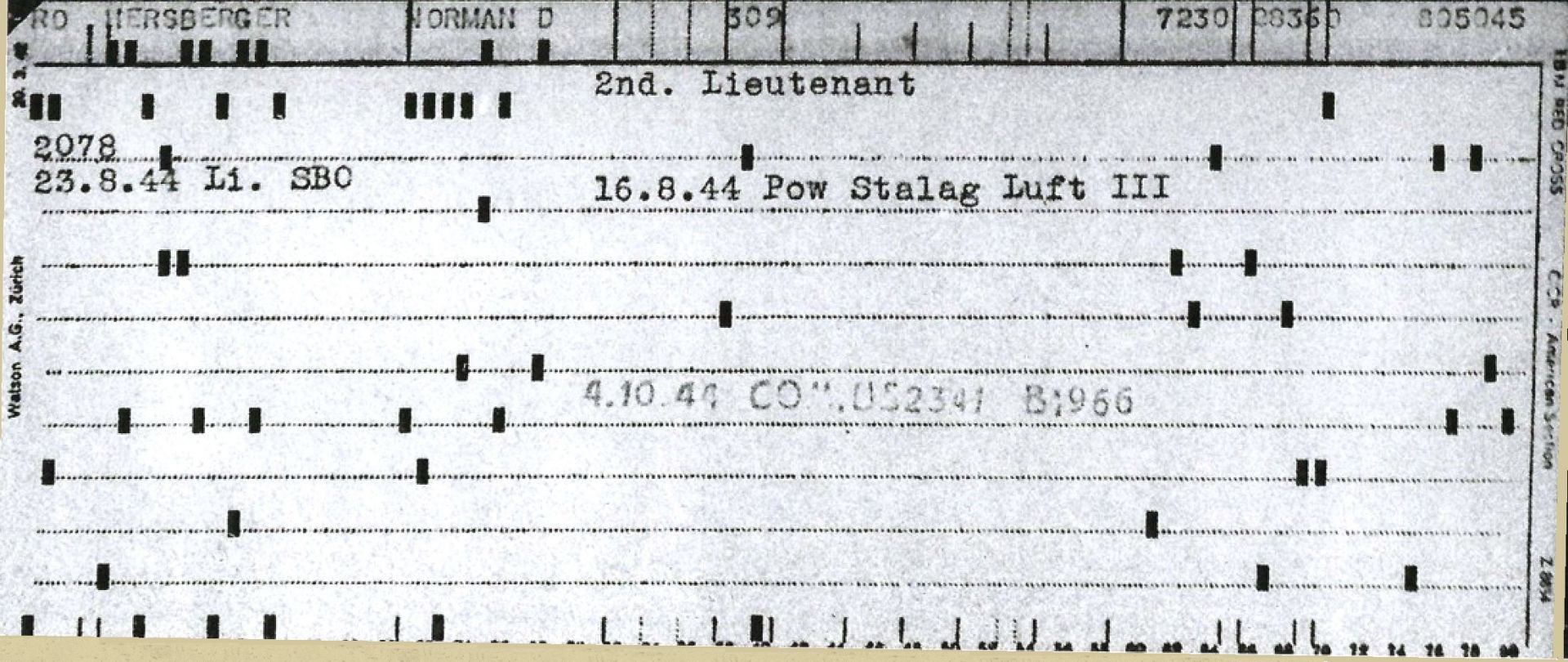
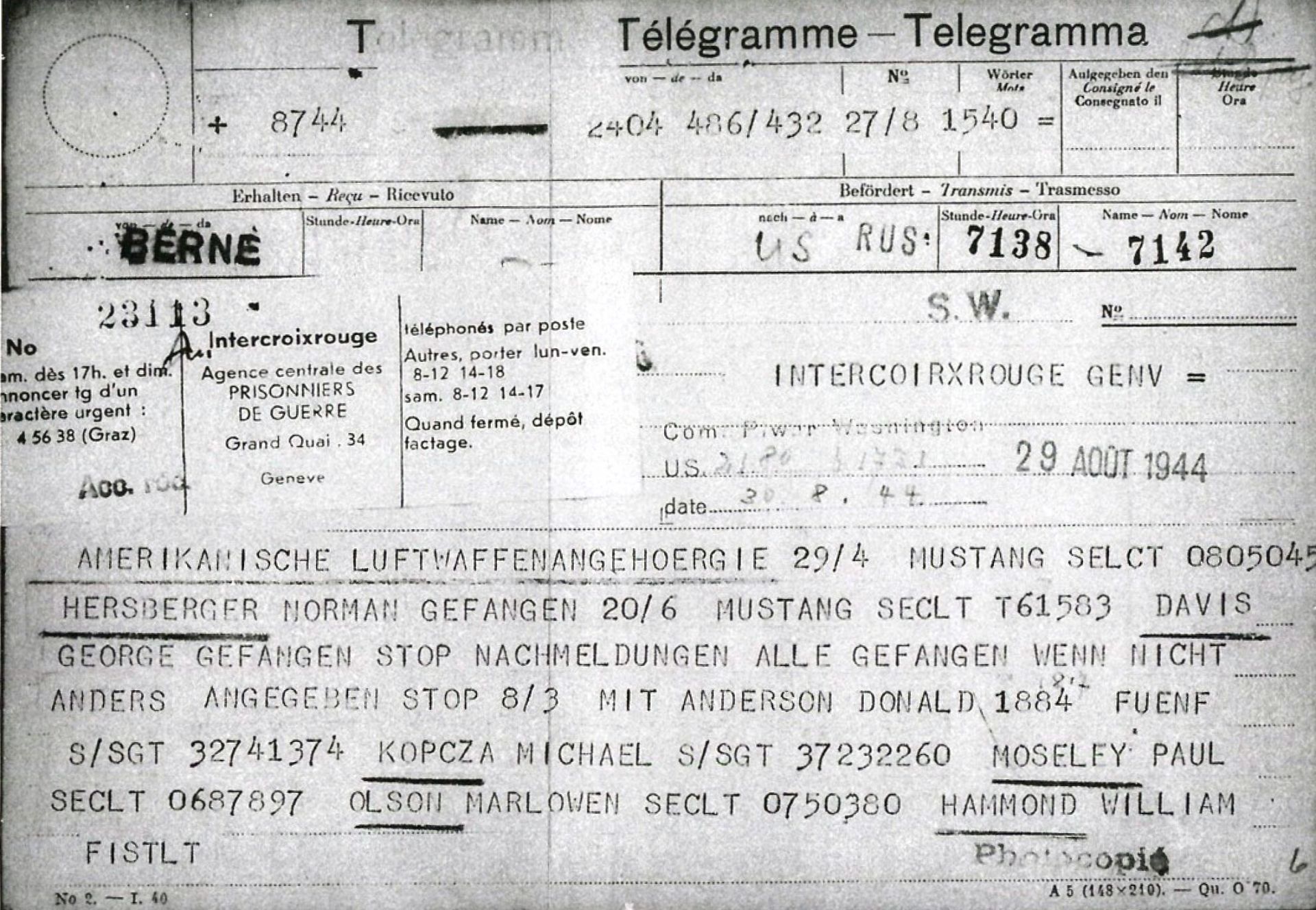
This telegram states :
"Members of the United States Army Air Force April 29 Mustang - service number 0805045 Hersberger Norman captured
June 20 Mustang service number T61583 Davis George captured - STOP - late entries of all prisoners
unless otherwise stated - STOP - March 8 with Anderson Donal 1884 S/Sgt 32741374 Kopcza Michael S/Sgt 37232260 Moseley Paul
number 0687897 Olson Marlowen number 0750380 Hammond William Fistlt"
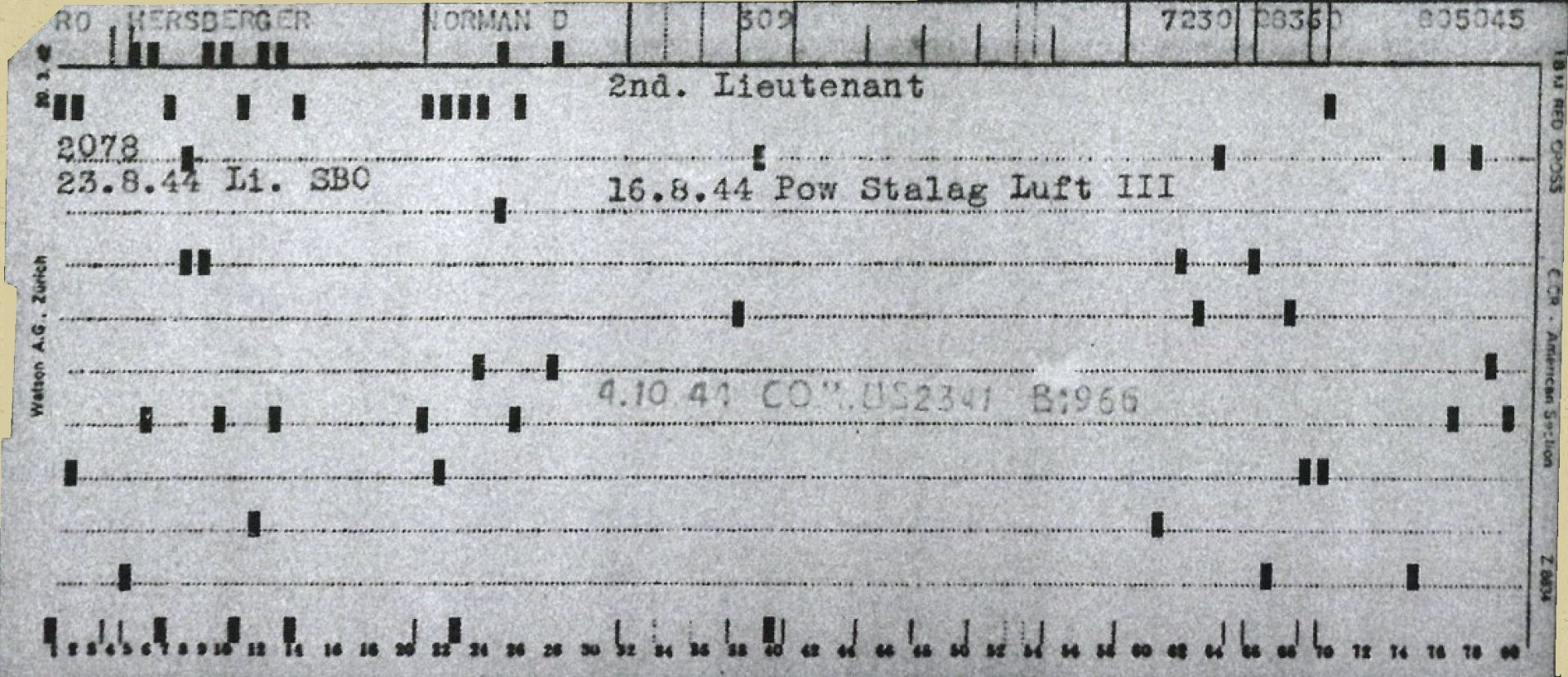
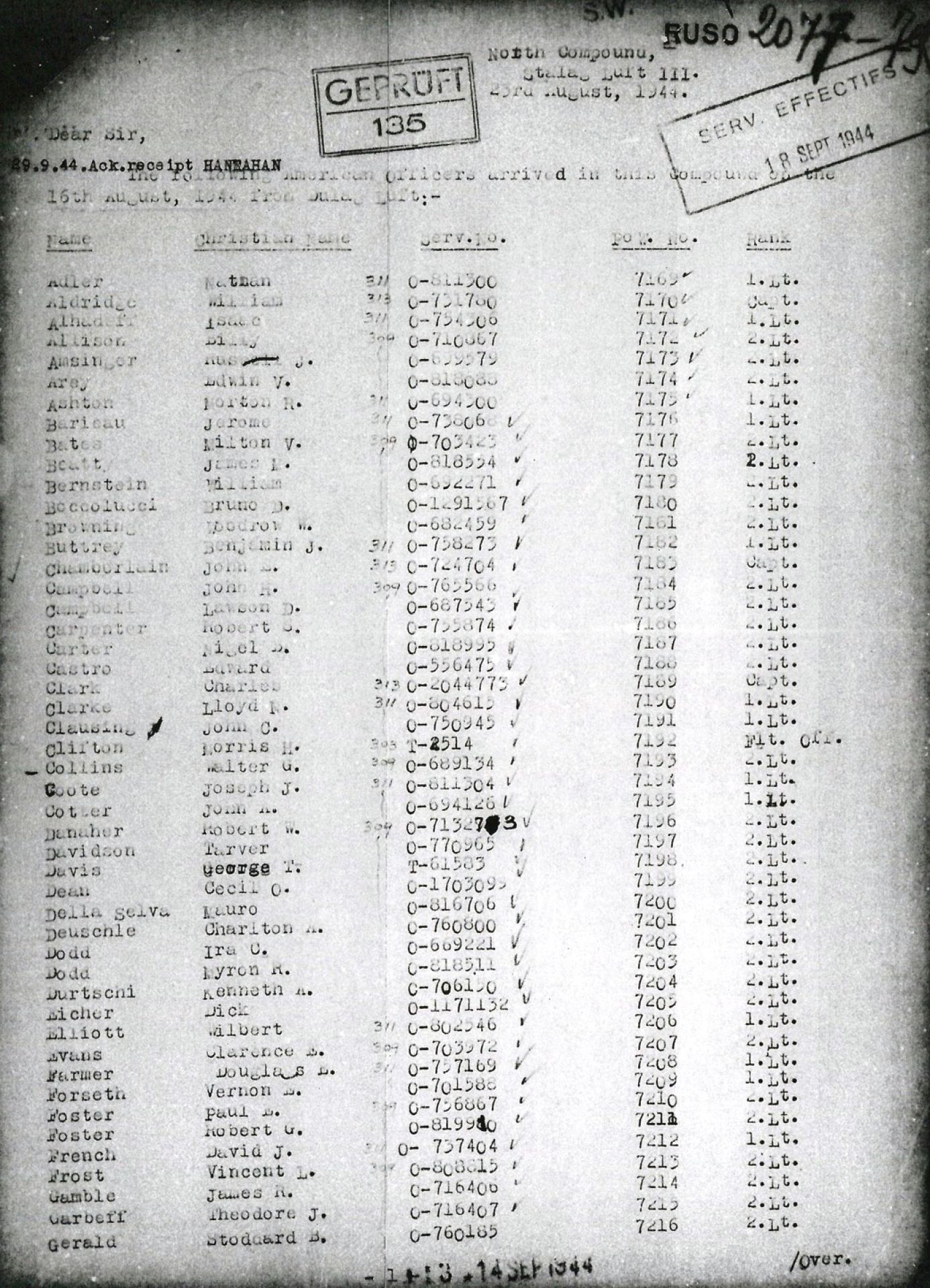
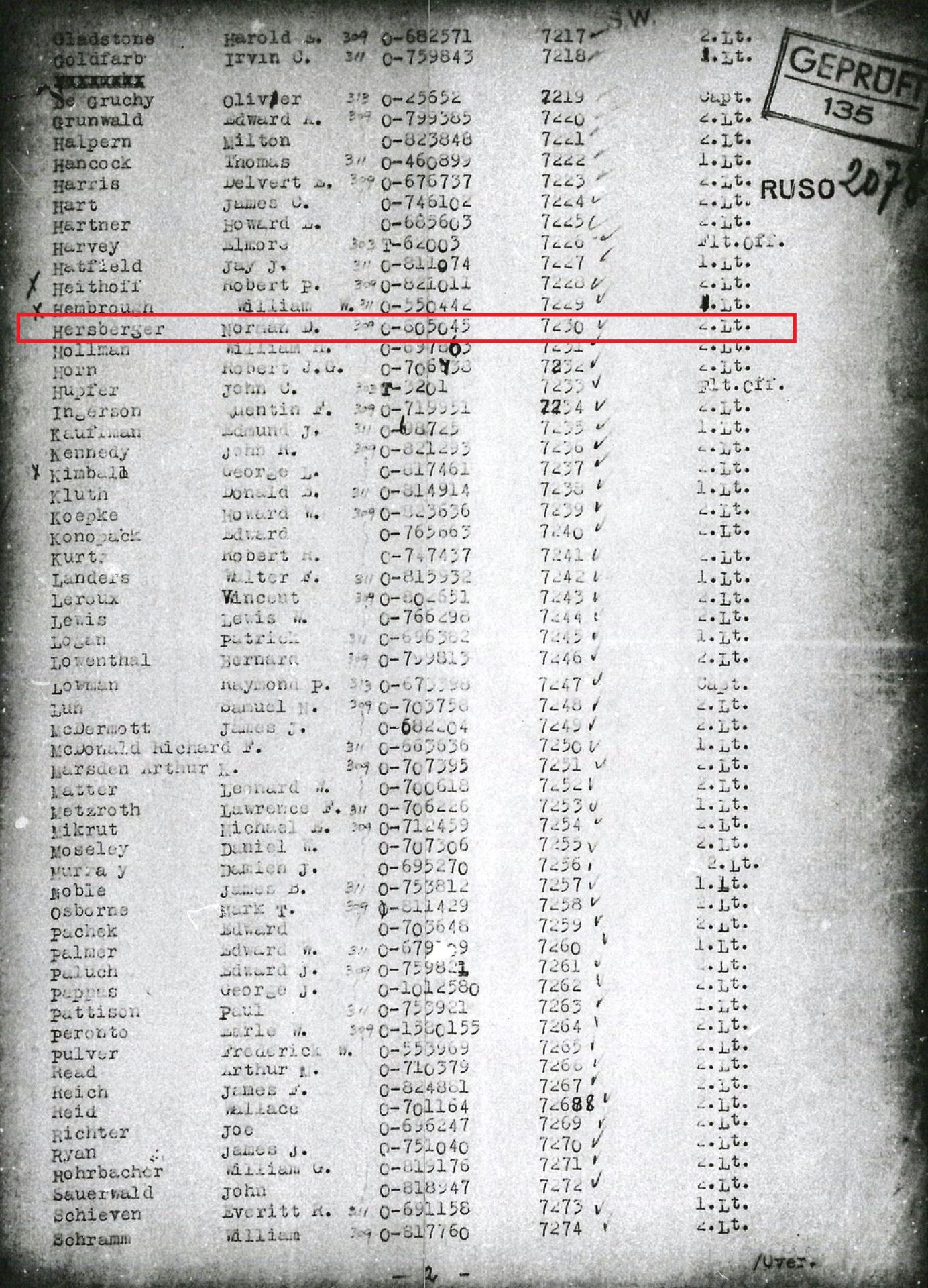
This document indicates that Hersberger was part of a group of prisoners who arrived at Stalag Luft III on August 16, 1944.
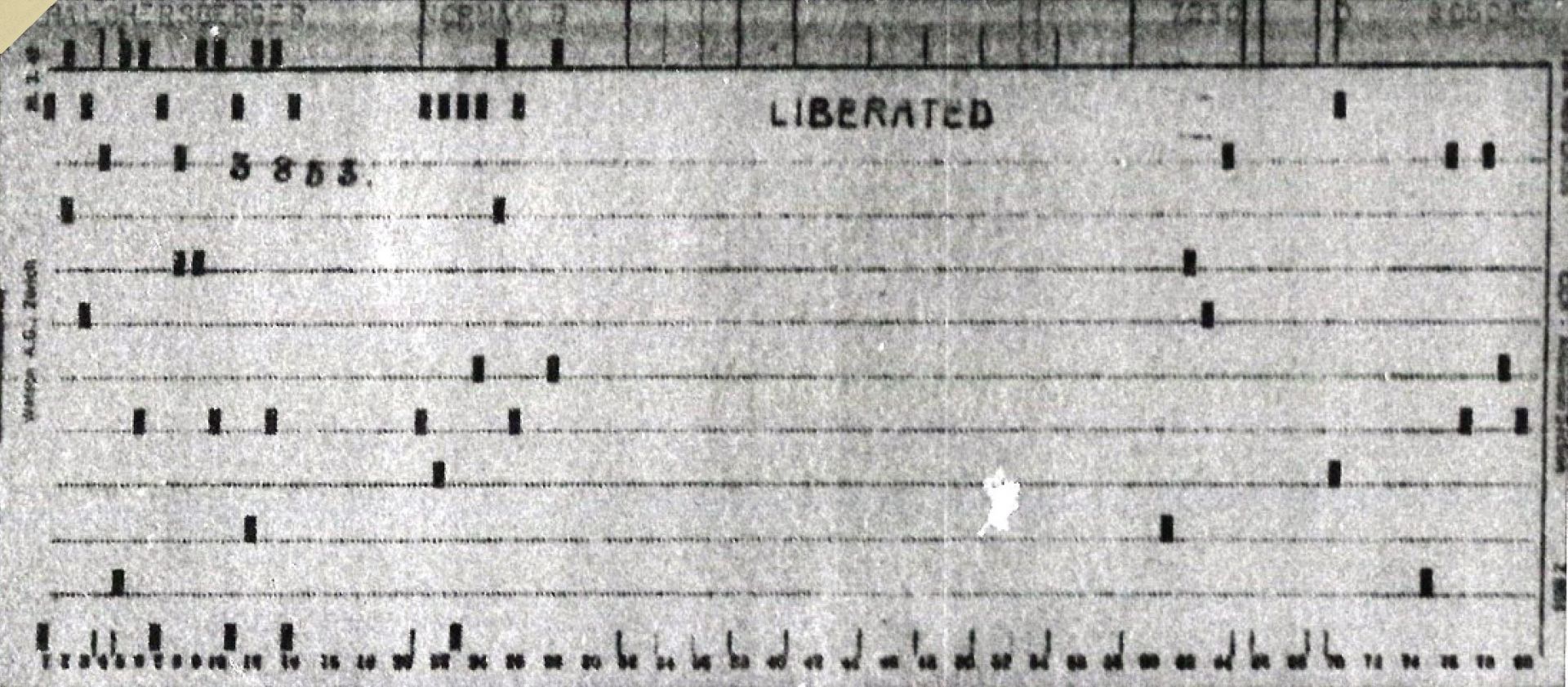
• Norman Davis Hersberger's Army Registration Card (10/16/1940 - 03/31/1947)
(source : Fold3 - US National Archives)
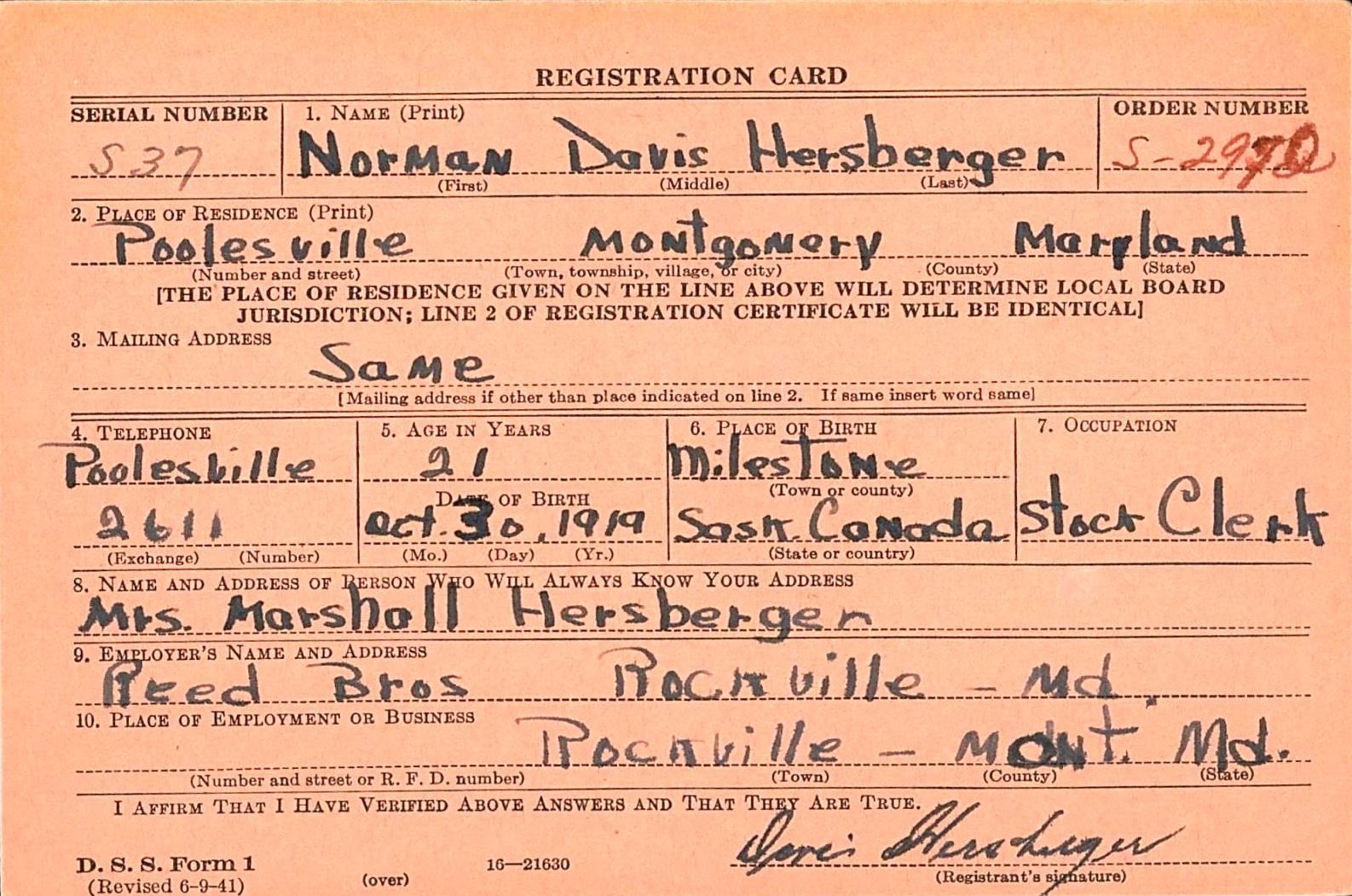
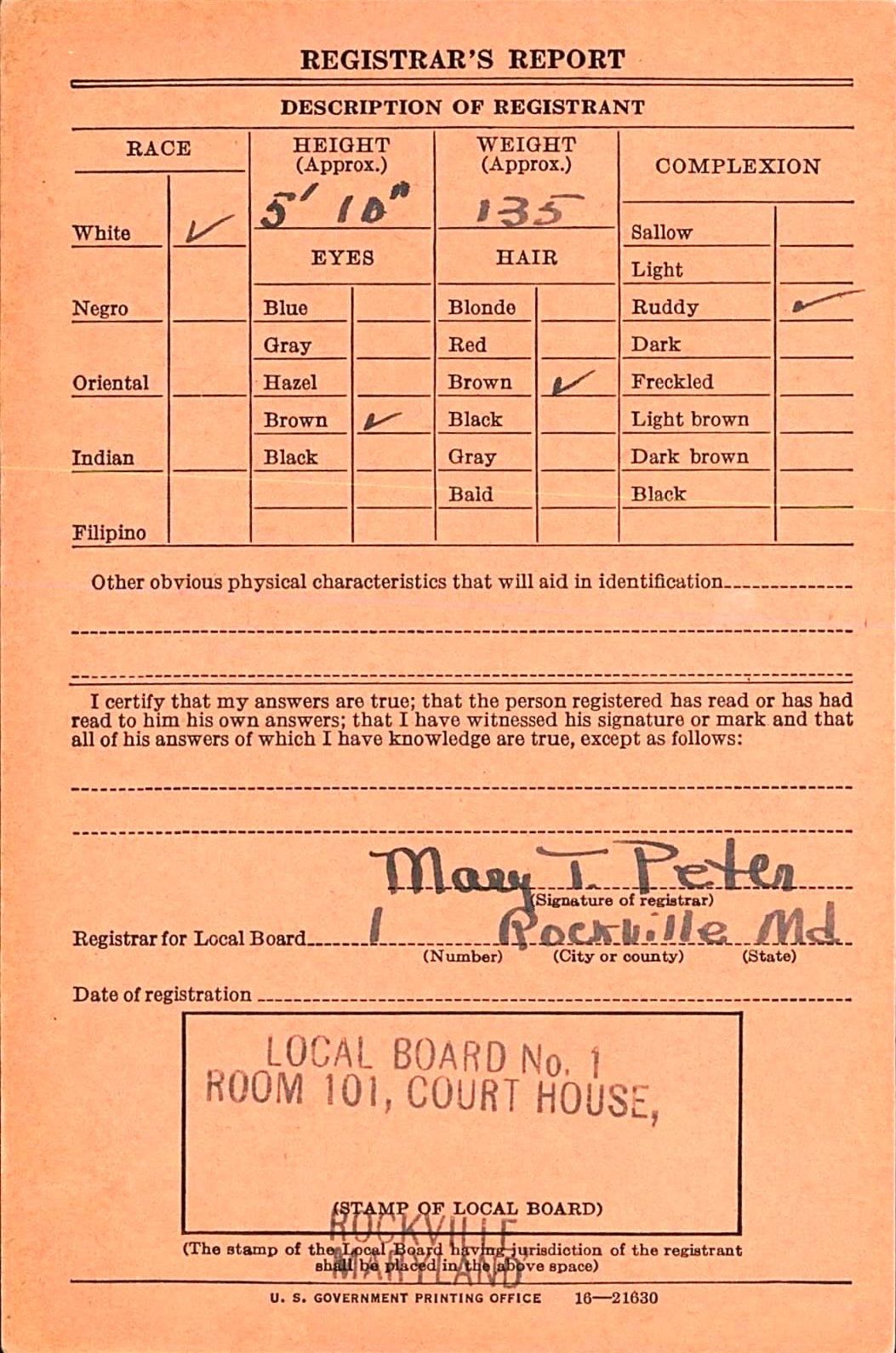

Ajouter un commentaire